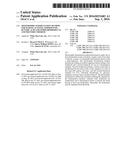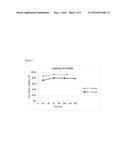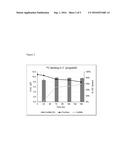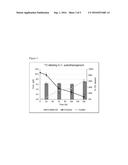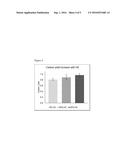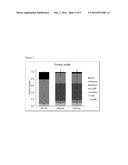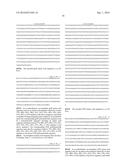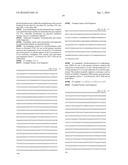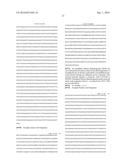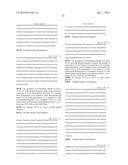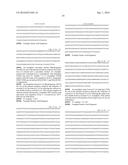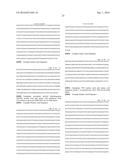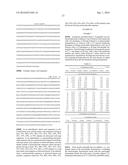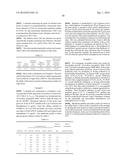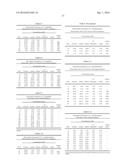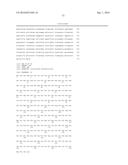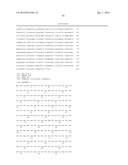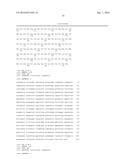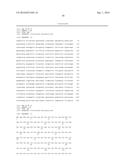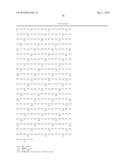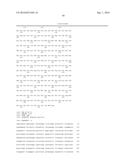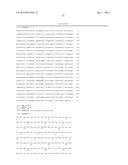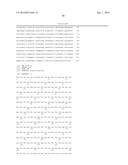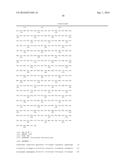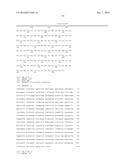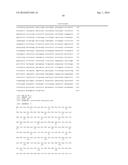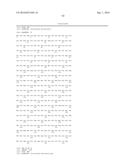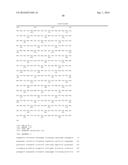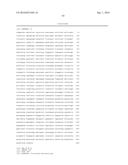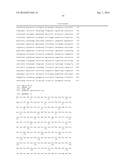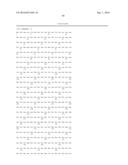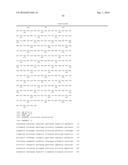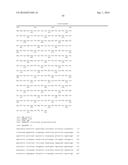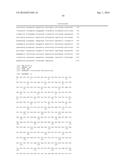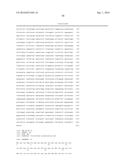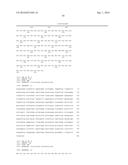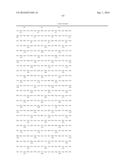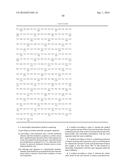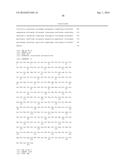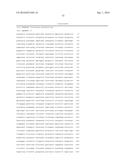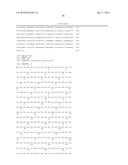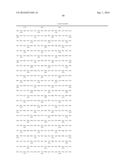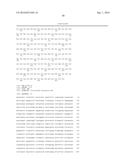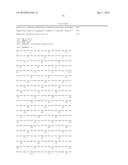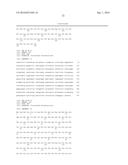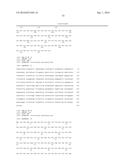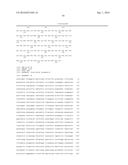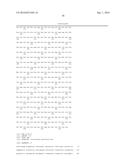Patent application title: MIXOTROPHIC FERMENTATION METHOD FOR MAKING ACETONE, ISOPROPANOL, BUTYRIC ACID AND OTHER BIOPRODUCTS, AND MIXTURES THEREOF
Inventors:
IPC8 Class: AC12P728FI
USPC Class:
435139
Class name: Preparing oxygen-containing organic compound containing a carboxyl group lactic acid
Publication date: 2016-09-01
Patent application number: 20160251683
Abstract:
Mixotrophic fermentation method performed to make one or more bioproducts
such as alcohols, organic acids of less than 7 carbons, acetone,
2,3-butanediol and mixtures thereof with a microorganism. The mixotrophic
fermentation method includes providing an isolated organism and providing
a first feedstock and a second feedstock for use in a fermentation
medium. The first feedstock includes a carbon source that is metabolized
by the native form of the organism at a rate of less than 0.01 g/hr/g
cell mass, and the second feedstock includes CO, CO.sub.2, carbonate,
bicarbonate, H.sub.2, glycerol, methanol, formate, urea or mixtures
thereof. The mixotrophic fermentation method also includes culturing the
organism in the fermentation medium, whereby both feedstocks are
metabolized and a fermentation broth is formed, the broth having at least
one bioproduct. Optionally, the bioproduct may be separated from the
broth.Claims:
1. A mixotrophic fermentation method comprising (i) providing an isolated
naturally acetogenic organism; (ii) providing a first feedstock and a
second feedstock wherein said first feedstock comprises a carbon source
that is metabolized by the native form of the organism at a rate of less
than 0.01 g/hr/g cell mass; and wherein said second feedstock comprises
CO, CO.sub.2, carbonate, bicarbonate, H.sub.2, glycerol, methanol,
formate, urea or a combination thereof; and (iii) culturing said organism
in a fermentation medium, whereby both feedstocks are metabolized and a
fermentation broth is formed, which broth comprises at least one
bioproduct.
2. A method according to claim 1, wherein the method yields a greater amount of the at least one bioproduct than the combined amounts of the at least one bioproduct produced by heterotrophic and autotrophic fermentation with the same organism under the same conditions.
3. A method according to claim 1, comprising production of at least one bioproduct and acetic acid as a second bioproduct, wherein the amount of acetic acid produced per biomass unit weight is less than about 50% of that produced in autotrophic fermentation with the same organism under the same conditions.
4. A method according to claim 1, wherein the carbon yield, based on the total amount of carbon in produced bioproducts divided by the total amount of carbon metabolized from said first feedstock, is at least 50%.
5. A method according to claim 1, wherein the .sup.13C/.sup.12C isotope ratio of the carbon present in the bioproduct is less than that of atmospheric CO.sub.2.
6. A method according to claim 1, wherein said carbon source is selected from carbohydrates, glycerol, methanol, or a combination thereof.
7. A method according to claim 1, wherein said organism is Clostridia.
8. A method according to claim 1, wherein said organism is genetically modified.
9. A method according to claim 1, wherein said first feedstock and said second feedstock are present in the fermentation medium at the same time.
10. A method according to claim 1, wherein said fermentation medium comprises a carbohydrate and at least one of CO, CO.sub.2, and hydrogen.
11. A method according to claim 1, wherein said fermentation medium comprises a steel mill produced CO composition.
12. A method according to claim 1, wherein the culturing is performed in whole or in part at a super-atmospheric pressure.
13. A method according to claim 1, wherein said bioproduct is selected from the group consisting of even numbered primary alcohols, odd numbered secondary alcohols, organic acids of less than 7 carbons, C3 compounds, C4 compounds, and mixtures thereof.
14. A method according to claim 1, wherein said bioproduct is selected from the group consisting of acetic acid, acetone, propionic acid, butyric acid, hexanoic acid, 3-hydroxypropionic acid, 3-hydroxybutyric acid, crotonic acid, acetoacetic acid, lactic acid, 2-hydroxyisobutyric acid, 3-methylbutanoic acid, ethanol, butanol, crotyl alcohol, hexanol, acetone, isopropanol, 2,3-butanediol, acetoin, 1,3-propanediol, and combinations thereof.
15. A method according to claim 1, wherein said bioproduct is non-naturally occurring.
16. A method according to claim 1, wherein said broth comprises a first bioproduct and a second bioproduct, wherein said first bioproduct is selected from the group consisting of acetoacetic acid, acetone, isopropanol, 3-hydroxybutyric acid, 2-hydroxyisobutyric acid, and combinations thereof, said second bioproduct is selected from the group consisting of ethanol, butanol, crotyl alcohol, hexanol, and combinations thereof, and the molar ratio between said first bioproduct and said second bioproduct is in the range from 0.1 to 0.95.
17. A method according to claim 1, wherein said second feedstock comprises CO, CO.sub.2, carbonate, bicarbonate, methanol, or a combination thereof; and wherein the .sup.13C/.sup.12C isotope ratio of the carbon present in said second feedstock is less than that of atmospheric CO.sub.2.
18. A method according to claim 1, comprising providing said fermentation medium with a mixture of CO.sub.2 and hydrogen at a molar ratio in the range from 1:0.1 to 1:5.
19. A method according to claim 18, further comprising steam reforming of a hydrocarbon to form said mixture of CO.sub.2 and hydrogen.
20. A method according to claim 1, wherein the first feedstock comprises a sugar selected from glucose and sucrose, and the organism metabolizes CO.sub.2 produced on metabolizing the sugar.
21. A method according to claim 1, wherein the first feedstock comprises a sugar selected from glucose and sucrose, the second feedstock comprises at least one of H.sub.2 and methanol, and the organism metabolizes CO.sub.2 produced on metabolizing the sugar.
22. A method according to claim 1, wherein said at least one bioproduct is acetone.
23. A method according to claim 22, wherein the first feedstock comprises a sugar selected from glucose and sucrose, and the organism metabolizes CO.sub.2 produced on metabolizing the sugar.
24. A method according to claim 1, wherein said at least one bioproduct is butyric acid.
25. A method according to claim 24, wherein the first feedstock comprises a sugar selected from glucose and sucrose, and the organism metabolizes CO.sub.2 produced on metabolizing the sugar.
26. A method according to claim 1, wherein said at least one bioproduct is isopropanol.
27. A method according to claim 26, wherein the first feedstock comprises a sugar selected from glucose and sucrose, and the organism metabolizes CO.sub.2 produced on metabolizing the sugar.
28. A method according to claim 1, wherein the metabolizing of the first feedstock does not inhibit the metabolizing of the second feedstock.
29. A method according to claim 1, wherein the first feedstock comprises a non-preferred sugar and wherein said second feedstock comprises CO, CO.sub.2, carbonate, bicarbonate, H.sub.2, glycerol, methanol, formate, urea or a combination thereof.
30. A mixotrophic fermentation method comprising (i) providing an isolated naturally acetogenic organism; (ii) providing a fermentation medium comprising a first feedstock and a second feedstock wherein said first feedstock comprises a carbon source that is metabolized by the native form of the organism at a rate of less than 0.01 g/hr/g cell mass; and (iii) culturing said organism in said fermentation medium, whereby both feedstocks are metabolized and acetic acid is formed, wherein the amount of acetic acid produced per biomass unit weight is less than about 50% of that produced in autotrophic fermentation with the same organism under the same conditions.
31. A mixotrophic fermentation method comprising (i) providing an isolated naturally acetogenic organism that has been genetically modified; (ii) providing a fermentation medium comprising a first feedstock and a second feedstock wherein said first feedstock comprises a sugar that is metabolized by the native form of the organism at a rate of less than 0.01 g/hr/g cell mass; and wherein said second feedstock comprises CO, CO.sub.2, carbonate, bicarbonate, H.sub.2, glycerol, methanol, formate, urea or mixtures thereof; and (iii) culturing said organism in said fermentation medium, whereby both feedstocks are metabolized and a fermentation broth is formed, which broth comprises at least one bioproduct.
Description:
CROSS-REFERENCE TO RELATED APPLICATIONS
[0001] The instant application claims priority to U.S. Provisional Application No. 62/121,871, filed Feb. 27, 2015; U.S. Provisional Application No. 62/183,034, filed Jun. 22, 2015; U.S. Provisional Application No. 62/199,548, filed Jul. 31, 2015; U.S. Provisional Application No. 62/209,133, filed Aug. 24, 2015; and U.S. Provisional Application No. 62/265,239, filed Dec. 9, 2015, the disclosures of each of which is incorporated by reference herein in their entireties.
SEQUENCE LISTING
[0002] The instant application contains a Sequence Listing which has been submitted electronically in ASCII format and is hereby incorporated by reference in its entirety. Said ASCII copy, created on Feb. 24, 2016, is named P49168 SL.txt and is 104,007 bytes in size.
FIELD OF INVENTION
[0003] The invention relates to the field of production of bioproducts such as alcohols, organic acids of less than 7 carbons, acetone, and mixtures thereof with microorganisms.
BACKGROUND
[0004] The production costs for biofuels and certain other bioproducts via microbial fermentation is currently high, particularly compared to oil-derived fuels. Feedstock and feedstock pre-treatment costs for use in such methods can form 50-60% or more of total operating costs. Generally these costs relate to the carbohydrates used as the carbon source in the production of the biofuels. Because these costs are so high, they are one of the primary factors affecting the economic viability of cellulosic and other next generation biofuel manufacturing processes. There is therefore a strong need for lowering these costs and for producing desired products at high yield and high titers. One way to mitigate high feedstock costs is by maximizing feedstock conversion to the product of interest.
[0005] However, conventional methods for maximizing feedstock conversion are fraught with difficulties. For example, attempts to ferment gaseous substrates with autotrophic organisms have been hindered by difficulties in reaching suitable concentrations of the substrate and by low titers, which increase isolation-related operating costs. Autotrophic fermentation has also been limited in the range of economically attainable products.
[0006] From a metabolic perspective, acetyl-CoA is a central building block and a link between glycolysis and fermentative alcohol production. Consequently acetyl-CoA serves as a focal point for biofuel production in microbial organisms. However, the ability to achieve metabolically efficient production of acetyl-CoA (and high mass yields) has historically been impeded by CO.sub.2 loss during decarboxylation reactions involved in classical Embden-Meyerhof-Parnas (EMP) glycolysis. For example, one molecule of glucose (where glucose is the carbon source) under heterotrophic growth conditions may be used to generate two molecules of acetyl-CoA and excess ATP, but this occurs at the "expense" of two CO.sub.2 molecules, which are lost in the conversion of pyruvate to acetyl-CoA. In contrast, two molecules of CO.sub.2 (where gaseous CO.sub.2 is the carbon source) under autotrophic growth conditions may generate one molecule of acetyl-CoA, but this scheme results in a net ATP formation of less than 1, and acetate production (from acetyl-CoA) is required to generate more ATP.
[0007] Accordingly, there is a need for fermentation methods and engineering metabolic pathways that minimize--or ideally eliminate--CO.sub.2 losses and result in complete conversion of a carbohydrate source into acetyl-CoA without having to sacrifice the acetyl-CoA produced for further generation of ATP.
SUMMARY OF THE INVENTION
[0008] Herein is provided a mixotrophic fermentation method comprising (i) providing an isolated naturally acetogenic organism, (ii) providing a first feedstock and a second feedstock wherein said first feedstock comprises a carbon source that is metabolized by the native form of the organism at a rate of less than 0.01 g/hr/g cell mass; and wherein said second feedstock comprises CO, CO.sub.2, carbonate, bicarbonate, H.sub.2, glycerol, methanol, formate, urea or a combination thereof; and (iii) culturing said organism in a fermentation medium, whereby both feedstocks are metabolized and a fermentation broth is formed, which broth comprises at least one bioproduct.
[0009] In an embodiment, the method yields a greater amount of the at least one bioproduct than the combined amounts of the at least on bioproduct produced by heterotrophic and autotrophic fermentation with the same organism under the same conditions.
[0010] In an embodiment, the method may comprise production of at least one bioproduct and acetic acid as a second bioproduct, wherein the amount of acetic acid produced per biomass unit weight is less than about 50% of that produced in autotrophic fermentation with the same organism under the same conditions.
[0011] In an embodiment, the carbon yield, based on the total amount of carbon in produced bioproducts divided by the total amount of carbon metabolized from said first feedstock, is at least 50%.
[0012] In an embodiment, the .sup.13C/.sup.12C isotope ratio of the carbon present in the bioproduct may be less than that of atmospheric CO.sub.2.
[0013] In an embodiment, said carbon source may be selected from carbohydrates, glycerol, methanol, or a combination thereof.
[0014] In embodiment, said organism may be Clostridia.
[0015] In an embodiment, said organism may be genetically modified.
[0016] In an embodiment, said first feedstock and said second feedstock may be present in the fermentation medium at the same time.
[0017] In an embodiment, said fermentation medium may comprise a carbohydrate and at least one of CO, CO.sub.2, and hydrogen.
[0018] In an embodiment, said fermentation medium comprises a steel mill produced CO composition.
[0019] In an embodiment, the culturing may be performed in whole or in part at a super-atmospheric pressure.
[0020] In an embodiment, said bioproduct may be selected from the group consisting of even numbered primary alcohols, odd numbered secondary alcohols, organic acids of less than 7 carbons, C3 compounds, C4 compounds, and mixtures thereof.
[0021] In an embodiment, said bioproduct may be selected from the group consisting of acetic acid, acetone, propionic acid, butyric acid, hexanoic acid, 3-hydroxypropionic acid, 3-hydroxybutyric acid, crotonic acid, acetoacetic acid, lactic acid, 2-hydroxyisobutyric acid, 3-methylbutanoic acid, ethanol, butanol, crotyl alcohol, hexanol, acetone, isopropanol, 2,3-butanediol, acetoin, 1,3-propanediol, and combinations thereof.
[0022] In an embodiment, said bioproduct may be non-naturally occurring.
[0023] In an embodiment, said broth may comprise a first bioproduct and a second bioproduct, wherein said first bioproduct is selected from the group consisting of acetoacetic acid, acetone, isopropanol, 3-hydroxybutyric acid, 2-hydroxyisobutyric acid, and combinations thereof, said second bioproduct is selected from the group consisting of ethanol, butanol, crotyl alcohol, hexanol, and combinations thereof, and the molar ratio between said first bioproduct and said second bioproduct is in the range from 0.1 to 0.95.
[0024] In an embodiment, the second feedstock may comprise CO, CO.sub.2, carbonate, bicarbonate, methanol, or a combination thereof; and the .sup.13C/.sup.12C isotope ratio of the carbon present in said second feedstock may be less than that of atmospheric CO.sub.2.
[0025] In an embodiment, the method may comprise providing said fermentation medium with a mixture of CO, and hydrogen at a molar ratio in the range from 1:0.1 to 1:5.
[0026] In an embodiment, the method may further comprise steam reforming of a hydrocarbon to form said mixture of CO.sub.2 and hydrogen.
[0027] In an embodiment, the first feedstock may comprise a sugar selected from glucose and sucrose, and the organism may metabolize CO.sub.2 produced on metabolizing the sugar.
[0028] In an embodiment, the first feedstock may comprise a sugar selected from glucose and sucrose, the second feedstock may comprise at least one of H.sub.2 and methanol, and the organism may metabolize CO.sub.2 produced on metabolizing the sugar.
[0029] In an embodiment, said at least one bioproduct is acetone. In such an embodiment, the first feedstock may comprise a sugar selected from glucose and sucrose, and the organism may metabolize CO.sub.2 produced on metabolizing the sugar.
[0030] In an embodiment, said at least one bioproduct is butyric acid. In such an embodiment, the first feedstock may comprise a sugar selected from glucose and sucrose, and the organism may metabolize CO.sub.2 produced on metabolizing the sugar.
[0031] In an embodiment, said at least one bioproduct is isopropanol. In such an embodiment, the first feedstock may comprise a sugar selected from glucose and sucrose, and the organism may metabolize CO.sub.2 produced on metabolizing the sugar.
[0032] In an embodiment, the metabolizing of the first feedstock does not inhibit the metabolizing of the second feedstock.
[0033] In an embodiment, the first feedstock may comprise a non-preferred sugar and the second feedstock may comprise CO, CO.sub.2, carbonate, bicarbonate, H.sub.2, glycerol, methanol, formate, urea or a combination thereof.
[0034] Herein is also provided a mixotrophic fermentation method comprising (i) providing an isolated naturally acetogenic organism, (ii) providing a fermentation medium comprising a first feedstock and a second feedstock wherein said first feedstock comprises a carbon source that is metabolized by the native form of the organism at a rate of less than 0.01 g/hr/g cell mass; and (iii) culturing said organism in said fermentation medium, whereby both feedstocks are metabolized and acetic acid is produced, wherein the amount of acetic acid produced per biomass unit weight is less than about 50% of that produced in autotrophic fermentation with the same organism under the same conditions.
[0035] Herein is also provided a mixotrophic fermentation method comprising (i) providing an isolated naturally acetogenic organism that has been genetically modified, (ii) providing a fermentation medium comprising a first feedstock and a second feedstock wherein said first feedstock comprises a sugar that is metabolized by the native form of the organism at a rate of less than 0.01 g/hr/g cell mass; and wherein said second feedstock comprises CO, CO.sub.2, carbonate, bicarbonate, H.sub.2, glycerol, methanol, formate, urea or a combination thereof; and (iii) culturing said organism in said fermentation medium, whereby both feedstocks are metabolized and a fermentation broth is formed, which broth comprises at least one bioproduct.
BRIEF DESCRIPTION OF THE DRAWINGS
[0036] FIG. 1 shows .sup.13C labeling of acetate in C. ljungdahlii grown under autotrophic (A-Acetate) and mixotrophic (M-Acetate) cultures.
[0037] FIG. 2 shows the percentage of .sup.13C labeling of acetate in C. ljungdahlii over time.
[0038] FIG. 3 shows the percentage of .sup.13C labeling of acetate in C. autoethanogenum over time.
[0039] FIG. 4 shows carbon yield with increasing amounts of H.sub.2 in the headspace in a C. ljungdahlii strain with a deleted secondary alcohol dehydrogenase gene (Clj .DELTA.SADH) and transformed with a plasmid expressing the genes for thiolase, acetoacetate transferase subunit A (COAT A), acetoacetate transferase subunit B (COAT B), and acetoacetate decarboxylase (acetone strain).
[0040] FIG. 5 shows product distributions of the acetone strain grown with increasing amounts of H.sub.2 in the headspace. Carbon fraction is the amount of carbon in each bioproduct with the total being 1.0.
DETAILED DESCRIPTION OF THE INVENTION
[0041] The particulars shown herein are by way of example and for purposes of illustrative discussion of the various embodiments of the present invention only and are presented in the cause of providing what is believed to be the most useful and readily understood description of the principles and conceptual aspects of the invention. In this regard, no attempt is made to show details of the invention in more detail than is necessary for a fundamental understanding of the invention, the description making apparent to those skilled in the art how the several forms of the invention may be embodied in practice.
[0042] The present invention will now be described by reference to more detailed embodiments. This invention may, however, be embodied in different forms and should not be construed as limited to the embodiments set forth herein. Rather, these embodiments are provided so that this disclosure will be thorough and complete, and will fully convey the scope of the invention to those skilled in the art.
[0043] Unless otherwise defined, all technical and scientific terms used herein have the same meaning as commonly understood by one of ordinary skill in the art to which this invention belongs. The terminology used in the description of the invention herein is for describing particular embodiments only and is not intended to be limiting of the invention. As used in the description of the invention and the appended claims, the singular forms "a," "an," and "the" are intended to include the plural forms as well, unless the context clearly indicates otherwise.
[0044] Unless otherwise indicated, all numbers expressing quantities of ingredients, reaction conditions, and so forth used in the specification and claims are to be understood as being modified in all instances by the term "about." Accordingly, unless indicated to the contrary, the numerical parameters set forth in the following specification and attached claims are approximations that may vary depending upon the desired properties sought to be obtained by the present invention. At the very least, and not as an attempt to limit the application of the doctrine of equivalents to the scope of the claims, each numerical parameter should be construed in light of the number of significant digits and ordinary rounding approaches.
[0045] Notwithstanding that the numerical ranges and parameters setting forth the broad scope of the invention are approximations, the numerical values set forth in the specific examples are reported as precisely as possible. Any numerical value, however, inherently contains certain errors necessarily resulting from the standard deviation found in their respective testing measurements. Every numerical range given throughout this specification will include every narrower numerical range that falls within such broader numerical range, as if such narrower numerical ranges were all expressly written herein.
[0046] Additional advantages of the invention will be set forth in part in the description which follows, and in part will be obvious from the description, or may be learned by practice of the invention. It is to be understood that both the foregoing general description and the following detailed description are exemplary and explanatory only and are not restrictive of the invention, as claimed.
[0047] One way to mitigate high feedstock costs is by maximizing feedstock conversion to the product of interest.
[0048] The inventors provide herein a mixotrophic fermentation method comprising (i) providing an isolated naturally acetogenic organism, (ii) providing a first feedstock and a second feedstock wherein said first feedstock comprises a carbon source that is metabolized by the native form of the organism at a rate of less than 0.01 g/hr/g cell mass; and wherein said second feedstock comprises CO, CO.sub.2, carbonate, bicarbonate, H.sub.2, glycerol, methanol, formate, urea or a combination thereof; and (iii) culturing said organism in a fermentation medium, whereby both feedstocks are metabolized and a fermentation broth is formed, which broth comprises at least one bioproduct.
[0049] Herein is also provided a mixotrophic fermentation method comprising (i) providing an isolated organism capable of metabolizing CO.sub.2 into acetyl-CoA; (ii) providing a fermentation medium comprising a first feedstock and a second feedstock wherein said first feedstock comprises carbohydrates, glycerol, methanol, or combinations thereof; and wherein said second feedstock comprises CO, CO.sub.2, carbonate, bicarbonate, H.sub.2, glycerol, methanol, formate, urea or mixtures thereof; and (iii) culturing said organism in said fermentation medium, whereby both feedstocks are metabolized and a fermentation broth is formed, which broth comprises at least one bioproduct.
[0050] In an embodiment, the method may further comprise separating at least one bioproduct from said broth to form a separated bioproduct.
[0051] In an embodiment, also provided is a method as above, wherein the method achieves greater production of the at least one bioproduct than the combined amounts produced by heterotrophic and autotrophic fermentation with the same organism under the same conditions.
[0052] In an embodiment, also provided is a method as above, comprising production of at least one bioproduct and acetic acid.
[0053] In an embodiment, also provided is a method as above, wherein the amount of acetic acid produced per biomass unit weight is less than about 50% of that produced in autotrophic fermentation with the same organism under the same conditions.
[0054] In an embodiment, also provided is a method as above, wherein the carbon yield, based on the total amount of carbon in produced metabolites divided by the total amount of carbon metabolized from said first feedstock, is at least 50%.
[0055] In an embodiment, also provided is a method as above, wherein said bioproduct is characterized by a .sup.13C/.sup.12C isotope ratio of less than that of atmospheric CO.sub.2.
[0056] In an embodiment, also provided is a method as above, wherein said first feedstock and said second feedstock are present in the fermentation medium at the same time.
[0057] In an embodiment, also provided is a method as above, wherein said fermentation medium comprises a carbohydrate and at least one of CO, CO.sub.2, and hydrogen.
[0058] In an embodiment, also provided is a method as above, wherein said fermentation medium comprises a steel mill produced CO composition.
[0059] In an embodiment, also provided is a method as above, wherein the first feedstock comprises juice extracted from at least one of sugarcane and sugarbeet.
[0060] In an embodiment, also provided is a method as above, wherein the culturing is performed in whole or in part at a super-atmospheric pressure.
[0061] In an embodiment, also provided is a method as above, wherein said bioproduct is selected from the group consisting of even numbered primary alcohols, odd numbered secondary alcohols, organic acids of less than 7 carbons, acetone, 2,3-butanediol, and mixtures thereof.
[0062] In an embodiment, also provided is a method as above, wherein said bioproduct is selected from the group consisting of acetic acid, propionic acid, butyric acid, hexanoic acid, 3-hydroxybutyric acid, crotonic acid, acetoacetic acid, lactic acid, 2-hydroxyisobutyric acid, 3-methylbutanoic acid, ethanol, butanol, crotyl alcohol, hexanol, acetone, isopropanol, 2,3-butanediol, acetoin, 1,3-propanediol and combinations thereof.
[0063] In an embodiment, also provided is a method as above, wherein said bioproduct is non-naturally occurring.
[0064] In an embodiment, also provided is a method as above, wherein said bioproduct is a C3 or a C4 compound.
[0065] In an embodiment, also provided is a method as above, wherein said bioproduct comprises a composition having multiple compounds and wherein one of said compounds is acetone.
[0066] In an embodiment, also provided is a method as above, wherein said broth comprises a first bioproduct and a second bioproduct, and wherein said first bioproduct is selected from the group consisting of acetoacetic acid, acetone, isopropanol, 3-hydroxybutyric acid, 2-hydroxyisobutyric acid, and combinations thereof. Also provided is such a method, wherein said second bioproduct is selected from the group consisting of ethanol, butanol, crotyl alcohol, hexanol, and combinations thereof. Also provided is such a method, wherein the molar ratio between said first bioproduct and said second bioproduct is in the range between 0.1 and 0.95.
[0067] In an embodiment, also provided is a method as above, wherein said second feedstock comprises CO, CO.sub.2, carbonate, bicarbonate methanol, and mixtures thereof; and wherein the .sup.13C/.sup.12C isotope ratio of the carbon present in said second feedstock is less than that of atmospheric CO.sub.2.
[0068] In an embodiment, also provided is a method as above, wherein said second feedstock comprises at least one of ammonium carbonate and ammonium bicarbonate. Also provided is such a method, further comprising adding pressurized CO.sub.2 to said fermentation medium.
[0069] In an embodiment, also provided is a method as above, wherein providing a fermentation medium includes providing said fermentation medium with a mixture of CO.sub.2 and hydrogen at a molar ratio in the range between 1:0.1 and 1:5. Also provided is such a method further comprising steam reforming of a hydrocarbon to form said mixture of CO.sub.2 and hydrogen. Also provided is such a method, wherein said hydrocarbon comprises methane.
[0070] In an embodiment, also provided is a method as above, wherein the bioproduct comprises at least one of butanol, butyric acid, acetic acid, lactic acid, 3-hydroxypropionic acid, 3-hydroxybutyric acid, crotonic acid, ethanol, acetone, isopropanol, 2,3-butanediol, acetoin, or crotyl-alcohol.
[0071] Also provided is such a method, wherein the first feedstock comprises a sugar selected from glucose and sucrose, the second feedstock comprises at least one of H.sub.2 and methanol, and the organism assimilates or metabolizes CO, produced on metabolizing the sugar. In an embodiment, the organism may metabolize CO.sub.2 produced during glycolysis. In an embodiment, the organism may metabolize CO.sub.2 produced via other metabolic pathways, for example, via the acetoacetate pathway and/or the 2-keto acid pathway and/or the .alpha.-acetolactate pathway.
[0072] Also provided is such a method, wherein the first feedstock comprises methanol and the second feedstock comprises a bicarbonate supplemented with CO.sub.2. Also provided is such a method, wherein the first feedstock comprises at least one of glucose and sucrose and the second feedstock comprises glycerol. Also provided is such a method, wherein the first feedstock comprises at least one of glucose and sucrose and the second feedstock comprises CO.sub.2 and H.sub.2. Also provided is such a method, wherein the first feedstock comprises at least one of glucose and sucrose and the second feedstock comprises CO, and methanol. Also provided is such method, wherein the first feedstock comprises methanol or glycerol and the second feedstock comprises CO.sub.2 and
[0073] In an embodiment, also provided is a method as above, wherein said at least one bioproduct is acetone.
[0074] Also provided is such a method, wherein said organism is acetogenic.
[0075] Also provided is such a method, wherein said organism is acetogenic Clostridia.
[0076] In an embodiment, also provided is a method as above, wherein said organism expresses genes of the Wood-Ljungdahl pathway.
[0077] Also provided is such a method, wherein said organism is selected from the group consisting of Clostridium ljungdahlii, Clostridium autoethanogenum, Clostridium ragsdalei, Eubacterium limosum, Butyribacterium methylotrophicum, Moorella thermoacetica, Clostridium aceticum, Acetobacterium woodii, Clostridium carboxidivorans, Alkalibaculum bacchi, Clostridium drakei, Clostridium formicoaceticum, Clostridium scatologenes, Moorella thermoautotrophica, Acetonema longum, Blautia producta, Clostridium glycolicum, Clostridium magnum, Clostridium mayombei, Clostridium methoxybenzovorans, Oxobacter pfennigii, and Thermoanaerobacter kivui.
[0078] Also provided is such a method, wherein said organism is genetically modified to have a primary alcohol dehydrogenase gene or a secondary alcohol dehydrogenase gene deleted from its genome.
[0079] Also provided is such a method, wherein said organism is genetically modified to have a butanediol dehydrogenase gene deleted from its genome.
[0080] Also provided is such a method, wherein the first feedstock comprises a sugar selected from glucose and sucrose, and the second feedstock comprises at least one of H.sub.2, and methanol, and the organism assimilates CO.sub.2 produced during glycolysis.
[0081] Also provided is such a method, wherein the first feedstock comprises methanol and the second feedstock comprises a bicarbonate supplemented with CO.sub.2.
[0082] Also provided is such a method, wherein the first feedstock comprises at least one of glucose and sucrose and the second feedstock comprises glycerol.
[0083] Also provided is such a method, wherein the first feedstock comprises at least one of glucose and sucrose and the second feedstock comprises CO.sub.2 and H.sub.2.
[0084] Also provided is such a method, wherein the first feedstock comprises at least one of glucose and sucrose and the second feedstock comprises CO.sub.2 and methanol.
[0085] Also provided is such a method, wherein the first feedstock comprises at least one of glucose and sucrose and the second feedstock comprises CO.sub.2.
[0086] Also provided is such a method, wherein the first feedstock comprises glucose and the second feedstock comprises CO. According to an embodiment, a method as described above is provided, wherein the feedstock glucose and feedstock CO are present in a glucose/CO weight/weight ratio of from about 0.3 to about 0.8.
[0087] Also provided is such a method, wherein the first feedstock comprises methanol or glycerol and the second feedstock comprises CO.sub.2 and H.sub.2.
[0088] Also provided is such a method, wherein the first feedstock comprises a carbohydrate, wherein said fermentation medium comprises a non-fermentable impurity, and wherein the impurity and the carbohydrate are present in the fermentation medium in a weight/weight ratio of greater than 0.05. In an embodiment, said impurity may be a fermentation inhibitor.
[0089] Also provided is such a method, wherein said broth comprises a second bioproduct, wherein said second bioproduct is selected from isopropanol and 3-hydroxybutyric acid and the molar ratio between acetone and said second bioproduct is greater than 5.
[0090] Also provided is such a method, further comprising separating acetone from said broth to form separated acetone. In an embodiment, said separating comprises evaporation. In an embodiment, said method further comprises catalytically converting said separated acetone into at least one acetone derivative. For example, herein is provided such a method comprising catalytically converting said separated acetone into one or more of mesitylene (1-3-5-trimethylbenzene), isophthalic acid, uvitic acid, and meta-xylene.
[0091] Also provided is such a method, wherein the method achieves greater production of acetone than the combined amounts of acetone produced by heterotrophic and autotrophic fermentation with the same organism under the same conditions.
[0092] Also provided is such a method, wherein said acetone has a .sup.13C/.sup.12C isotope ratio of less than that of atmospheric CO.sub.2.
[0093] Also provided is such a method, wherein said first feedstock and said second feedstock are present in the fermentation medium at the same time.
[0094] Also provided is such a method, comprising production of acetone and acetic acid. For example, in an embodiment, such a method is provided, wherein the amount of acetic acid formed per biomass unit weight is less than about 50% of that formed in autotrophic fermentation with the same organism under the same conditions.
[0095] Also provided is such a method, wherein said fermentation medium comprises at least one of CO, CO.sub.2, and hydrogen.
[0096] Also provided is such a method, wherein said fermentation medium comprises a steel mill produced composition.
[0097] Also provided is such a method, wherein said at least one bioproduct is butyric acid.
[0098] Also provided is such a method, wherein the first feedstock comprises glucose, and the second feedstock comprises methanol at a glucose/methanol molar ratio of about 1:6.
[0099] Also provided is such a method further comprising separating butyric acid from said broth to form separated butyric acid.
[0100] Also provided is such a method, wherein said separating comprises contacting said broth with an organic solvent comprising a C6-C12 alkanol.
[0101] Also provided is such a method, wherein said separating comprises contacting said broth with an organic solvent comprising an ester of butyric acid and a C4-C12 alkanol.
[0102] Also provided is such a method, wherein said fermentation medium has a pH of greater than 5.5 and comprises calcium carbonate for pH control.
[0103] Also provided is such a method, wherein said calcium carbonate is present in second feedstock and also serves as a carbon source.
[0104] Also provided is such a method, wherein said fermentation medium has a pH greater than 5.5, and comprises a calcium base for pH control and wherein said separating comprises acidulating with sulfuric acid.
[0105] Also provided is such a method, further comprising catalytically converting said separated butyric acid into at least one butyric acid derivative.
[0106] Also provided is such a method, wherein said catalytically converting comprises hydrogenation and wherein said at least one butyric acid derivative comprises butanol.
[0107] Also provided is such a method, wherein said at least one bioproduct is isopropanol.
[0108] Also provided is such a method, wherein said broth comprises a second bioproduct, said second bioproduct is selected from acetone and 3-hydroxybutyric acid, and the molar ratio of isopropanol to said second bioproduct in said broth is greater than 5.
[0109] Also provided is such a method, further comprising separating isopropanol from said broth to form in separated isopropanol.
[0110] Also provided is such a method, wherein said separating comprises evaporation.
[0111] Also provided is such a method, further comprising catalytically converting said separated isopropanol into at least one isopropanol derivative.
[0112] Also provided is such a method, wherein said broth comprises more than one bioproduct and at least one bioproduct is isopropanol and another is acetone.
[0113] Also provided is such a method, wherein said broth comprises a third bioproduct, said third bioproduct is 3-hydroxybutyric acid, and the molar ratio of the combination of isopropanol and acetone to said third bioproduct is greater than 5.
[0114] Also provided is such a method further comprising separating isopropanol and acetone from said broth to form a separated composition comprising isopropanol and acetone.
[0115] Also provided is such a method, wherein said separating comprises evaporation.
[0116] Also provided is such a method further comprising catalytically converting the isopropanol and/or acetone present in said separated composition into at least one derivative of isopropanol or acetone.
[0117] According to an embodiment, said organism is acetogenic and said first feedstock comprises at least one non-preferred sugar. According to an embodiment said first feedstock further comprises at least one preferred sugar.
[0118] According to an embodiment, said non-preferred sugar is metabolized by a genetically modified acetogenic organism at a rate of at least 0.02 g/hr/g cell mass.
[0119] According to an embodiment, CO.sub.2 is generated from metabolizing said non-preferred sugar and said generated CO.sub.2 comprises at least a fraction of said second feedstock.
[0120] According to an embodiment, said non-preferred sugar is selected from the group consisting of glucose, mannose, galactose, arabinose, ribose, maltose, sucrose, lactose, cellobiose and mixtures thereof. According to an embodiment, said non-preferred sugar comprises glucose.
[0121] According to an embodiment, said organism is genetically modified to express at least one component of a phosphotransferase system (PTS). According to an embodiment, said at least one component is selected from the group consisting of enzymes EIIA, EIIB, EIIC, and combinations thereof.
[0122] According to an embodiment, said organism is genetically modified to express a gene related to a sugar transport system other than genes associated with the phosphotransferase system. According to an embodiment, said gene is selected from the group consisting of a symporter system utilizing a sodium ion (Na.sup.+), a symporter system utilizing protons (H.sup.+), a permease system and a combination thereof.
[0123] According to an embodiment, the rate of metabolizing said non-preferred sugar by said genetically modified organism is greater than that of metabolizing said non-preferred sugar by the native form of the organism by a factor of at least 1.5.
[0124] According to an embodiment, said bioproduct is selected from the group consisting of acetic acid, propionic acid, 3-hydroxypropionic acid, butyric acid, hexanoic acid, 3-hydroxybutyric acid, crotonic acid, acetoacetic acid, lactic acid, 2-hydroxyisobutyric acid, 3-methylbutanoic acid, ethanol, butanol, crotyl alcohol, hexanol, acetone, isopropanol, 2,3-butanediol, acetoin, 1,3-propanediol and combinations thereof.
[0125] Provided is a mixotrophic fermentation method comprising (i) providing an isolated organism capable of metabolizing CO.sub.2 into acetyl-CoA; (ii) providing a first feedstock and a second feedstock for use in a fermentation medium, wherein said first feedstock comprises carbohydrates, glycerol, methanol or combinations thereof; and wherein said second feedstock comprises CO, CO.sub.2, carbonate, bicarbonate, H.sub.2, glycerol, methanol, formate, urea or mixtures thereof; (iii) culturing said organism in said fermentation medium, whereby both feedstocks are metabolized and a fermentation broth is formed, which broth comprises at least one bioproduct; and (iv) optionally separating said bioproduct from said broth.
[0126] According to an embodiment, the method provides a mixotrophic fermentation method that results in greater production of a target bioproduct or a combination of target bioproducts than the combined amounts produced by heterotrophic and autotrophic fermentation with the same organism under the same conditions. Said embodiment is exemplified by comparing three cases of fermenting with a given organism capable of and/or configured for use in the method. In the first case (referred to herein as heterotrophic fermentation), a microorganism is cultured in a fermentation medium comprising a first feedstock to form a heterotrophic fermentation broth. In the second case (referred to herein as autotrophic fermentation), the microorganism is cultured in a fermentation medium comprising a second feedstock to form an autotrophic fermentation broth. In the third case (referred to herein as mixotrophic fermentation), a microorganism is cultured in a fermentation medium comprising a mixture of the first feedstock and the second feedstock to form a mixotrophic fermentation broth. At the end of culturing time, the autotrophic fermentation broth is mixed with the heterotrophic fermentation broth to form a mixed fermentation broth. According to said embodiment, the mixotrophic fermentation method may achieve greater production of a target bioproduct or a combination of target bioproducts than the combined amounts produced by heterotrophic and autotrophic fermentation with the same microorganism under the same conditions. The nature of bioproducts in said mixotrophic fermentation and/or the molar ratio between the bioproducts (in case of forming multiple bioproducts), may differ from those of the mixed fermentation broth.
[0127] According to an embodiment, the method is characterized in that the amount of acetic acid formed per biomass unit weight is less than about 50% of that formed in autotrophic fermentation using the same organism, less than 40%, less than 30%, less than 20%, or less than 10%. Biomass refers to the total weight of solid biological material generated during fermentation. Biomass may be easily separated from the fermentation medium by, for example, centrifugation. Biomass does not include any solid biological material introduced into the fermentation medium by one or more feedstocks.
[0128] According to an embodiment, the method is characterized in carbon yield of at least 50%, at least 60%, at least 70%, at least 80%, at least 90%, at least 100%, at least 110%, at least 120%, at least 130%, at least 140%, at least 150%, or at least 160%. As used herein carbon yield may be calculated by dividing the total amount of carbon in bioproducts produced during fermentation by the total amount of carbon metabolized from the first feedstock during fermentation.
[0129] The method comprises providing an isolated, naturally occurring or non-naturally occurring organism capable of metabolizing CO.sub.2. The organism may be autotrophic. In an embodiment, the organism may be capable of assimilating CO, CO.sub.2, methanol, etc., for growth. The organism may also be capable of utilizing glycolysis for growth. Any organism capable of metabolizing CO.sub.2 is suitable. According to an embodiment, said organism is acetogenic. In an embodiment, the organism is naturally acetogenic. An organism is "naturally acetogenic" if the wild-type (or native) organism is capable of metabolizing CO.sub.2 into acetate using the Wood-Ljungdahl pathway (or reductive acetyl-CoA pathway). A naturally acetogenic organism may be a wild-type organism or genetically modified.
[0130] According to an embodiment, said organism is acetogenic Clostridia. According to an embodiment, the organism may be selected from the group consisting of Clostridium ljungdahlii, Clostridium autoethanogenum, Clostridium ragsdalei, Eubacterium limosum, Butyribacterium methylotrophicum, Moorella thermoacetica, Clostridium aceticum, Acetobacterium woodii, Clostridium carboxidivorans, Alkalibaculum bacchi, Clostridium drakei, Clostridium formicoaceticum, Clostridium scatologenes, Moorella thermoautotrophica, Acetonema longum, Blautia producta, Clostridium glycolicum, Clostridium magnum, Clostridium mayombei, Clostridium methoxybenzovorans, Oxobacter pfennigii, and Thermoanaerobacter kivui.
[0131] The organism may be genetically modified. For example, the organism may be genetically modified to reduce or eliminate expression of a primary alcohol dehydrogenase or a secondary alcohol dehydrogenase. In an embodiment, the organism may be genetically modified to have a primary alcohol dehydrogenase gene or a secondary alcohol dehydrogenase gene deleted from its genome. While a genomic deletion is a preferred embodiment, any genomic mutation resulting in inactivation of the enzyme would be sufficient, including but not limited to partial gene deletion, nonsense mutation, transcriptional promoter deletion, etc. In another embodiment, the transcriptional expression of this gene can be reduced by using antisense RNA.
[0132] Similarly, the organism may be genetically modified to reduce or eliminate nucleic acid and/or protein expression of butanediol dehydrogenase. In an embodiment, the organism may be genetically modified to have a butanediol dehydrogenase gene deleted from its genome. In another embodiment, the organism may be genetically modified to have a secondary alcohol dehydrogenase gene and a butanediol dehydrogenase gene deleted from its genome.
[0133] As used herein, a "secondary alcohol dehydrogenase" is an enzyme that catalyzes the reduction of a ketone to a secondary alcohol, for example, the reduction of acetone into 2-propanol (a.k.a. isopropanol). An exemplary amino acid sequence of the secondary alcohol dehydrogenase gene is the following amino acid sequence from C. ljungdahlii DSM 13528:
TABLE-US-00001 (SEQ ID NO: 2) MKGFAMLGINKLGWIEKKNPVPGPYDAIVHPLAVSPCTSDIHTVFEGALG NRENMILGHEAVGEIAEVGSEVKDFKVGDRVIVPCTTPDWRSLEVQAGFQ QHSNGMLAGWKESNEKDGVFADYFHVNDADMNLAILPDEIPLESAVMMTD MMTTGFHGAELADIKMGSSVVVIGIGAVGLMGIAGSKLRGAGRIIGVGSR PVCVETAKFYGATDIVNYKNGDIVEQIMDLTHGKGVDRVIMAGGGAETLA QAVTMVKPGGVISNINYHGSGDTLPIPRVQWGCGMAHKTIRGGLCPGGRL RMEMLRDLVLYKRVDLSKLVTHVFDGAENIEKALLLMKNKPKDLIKSVVT F.
[0134] In an embodiment, an exemplary secondary alcohol dehydrogenase amino acid sequence may be an amino acid sequence which has at least 75%, 80%, 85%, 90%, 91%, 92%, 93%, 94%, 95%, 96%, 97%, 98%, or 99% identity to the above sequence, and which is capable of catalyzing the reduction of a ketone to a secondary alcohol.
[0135] As used herein, a "butanediol dehydrogenase" may be an oxidoreductase enzyme, with EC number 1.1.1.4, that catalyzes the reduction of a ketone group to an alcohol group, specifically converting acetoin into butanediol. An exemplary amino acid sequence encoded by the butanediol dehydrogenase gene is the following amino sequence from C. ljungdahlii DSM 13528:
TABLE-US-00002 (SEQ ID NO: 4) MKAVLWYDKKDVRVEEIEEPKVKENAVKIKVKWCGICGSDLHEYLGGPIF IPVGTPHPLSKSTAPVVLGHEFSGEVVEIGSKVTKFKAGDRVIVEPIVAC GKCPACLEGKYNLCEALGFHGLCGSGGGFAEYTVFPEDFVHKIPDTMDYE QAALVEPMAVALHSLRVGNFTTGNTALVLGAGPIGLATIQCLKASGARIV IVFQRKSVRQEYAKKFGADVVLDPNEVDVIEEIKKLTGGVGVDTSFETTG ANVGINTAIQALKYEGTAVITSVWEKNAEINPNDLVFTEKKVVGTLAYRH EFPSTIALMNDGRIKTDGYITKRIALEDIVKEGFETLTGPEKKKHVKIIV TPDKSLL
[0136] In an embodiment, an exemplary butanediol dehydrogenase amino acid sequence may be an amino acid sequence which has at least 75%, 80%, 85%, 90%, 91%, 92%, 93%, 94%, 95%, 96%, 97%, 98%, or 99% identity to the above sequence, and which is capable of catalyzing the reduction of a ketone to an alcohol, specifically acetoin to butanediol. An exemplary nucleic acid sequence that encodes a butanediol dehydrogenase, which is from C. ljungdahlii DSM 13528, is as follows:
TABLE-US-00003 (SEQ ID NO: 3) ATGAAAGCTGTATTGTGGTATGATAAAAAAGATGTAAGAGTAGAGGAAAT TGAGGAACCTAAGGTAAAAGAAAATGCTGTAAAAATTAAAGTGAAATGGT GTGGTATATGTGGTTCTGACTTGCATGAGTATTTAGGAGGACCTATATTT ATTCCAGTAGGTACGCCACATCCTTTAAGCAAGAGTACTGCACCAGTAGT TTTAGGACATGAGTTTTCAGGAGAAGTAGTAGAAATAGGAAGCAAGGTTA CAAAATTTAAAGCAGGAGATAGAGTTATTGTAGAACCTATAGTTGCCTGT GGAAAGTGTCCTGCTTGTCTTGAAGGAAAATATAATTTATGTGAAGCTTT GGGATTTCATGGACTTTGTGGAAGCGGCGGCGGATTTGCTGAATACACAG TATTTCCTGAAGATTTTGTCCATAAGATACCAGATACTATGGACTATGAG CAGGCTGCACTTGTTGAGCCTATGGCAGTTGCCCTTCATTCTCTAAGAGT TGGAAACTTTACTACAGGAAATACTGCTTTGGTTTTAGGTGCAGGACCTA TAGGACTTGCAACTATTCAGTGTTTAAAGGCATCAGGGGCAAGAATTGTA ATTGTATTTCAGAGAAAATCTGTAAGACAGGAATATGCTAAGAAATTTGG AGCAGATGTAGTTTTAGATCCAAATGAGGTAGATGTAATTGAAGAAATTA AAAAACTTACAGGCGGCGTAGGCGTGGATACATCTTTTGAAACAACAGGT GCAAATGTAGGGATTAATACGGCAATTCAAGCTTTAAAATATGAAGGTAC TGCGGTAATAACCAGCGTATGGGAGAAAAATGCAGAAATCAATCCAAATG ATCTTGTATTTACAGAAAAGAAGGTAGTTGGTACTCTTGCCTACAGACAT GAATTTCCTTCTACAATAGCACTTATGAATGATGGAAGAATAAAGACAGA CGGATATATTACAAAGAGAATAGCACTTGAGGACATTGTAAAAGAAGGAT TTGAAACACTTACAGGACCTGAAAAGAAAAAACATGTAAAAATAATTGTA ACTCCTGACAAATCCTTATTGTAA.
[0137] In an embodiment, an exemplary butanediol dehydrogenase nucleic acid sequence or an exemplary secondary alcohol dehydrogenase nucleic acid may be a nucleic acid sequence which has at least 75%, 80%, 85%, 90%, 91%, 92%, 93%, 94%, 95%, 96%, 97%, 98%, or 99% identity to a corresponding butanediol dehydrogenase or secondary alcohol dehydrogenase nucleic acid sequence as disclosed herein.
[0138] According to an embodiment, said organism expresses and/or comprises one or more biomolecules of the Wood-Ljungdahl pathway (or reductive acetyl-CoA pathway). Biomolecules of the Wood-Ljungdahl pathway include enzymes such as CO dehydrogenase and acetyl-CoA synthase, as well as genes encoding such enzymes. The Wood-Ljungdahl pathway metabolizes CO.sub.2, which can be produced during glycolysis or fed exogenously, into acetyl-CoA. The acetyl-CoA is then fed into downstream pathways for production of other or additional bioproducts.
[0139] Rates and/or efficiencies relating to bioproduct formation and metabolite consumption achieved by the organism during the mixotrophic fermentation method of the invention may be higher than those achieved by the organism exposed to feedstocks comprising the same nutrients in the wild.
[0140] The method further comprises providing a fermentation medium comprising a first feedstock and a second feedstock. According to an embodiment, providing a fermentation medium comprises preparing an aqueous solution comprising said first feedstock and said second feedstock. According to an embodiment, providing comprises supplementing at least one of said first feedstock and said second feedstock during culturing. According to an embodiment, the fermentation medium comprises initially only the first feedstock and then the second feedstock is supplemented. According to an embodiment, supplementing said second feedstock is done before the first feedstock is fully utilized, e.g., at the time the first feedstock is only 10%, 20%, 30% or 40% utilized.
[0141] According to an embodiment, the fermentation medium may further comprise a steel mill gas composition. For example, the fermentation medium may comprise a steel mill gas composition comprising 40-80% CO, 10-25% CO.sub.2, 2-5% H.sub.2, and 15-35% N.sub.2. In an embodiment, the fermentation medium may comprise a steel mill gas composition comprising 60-70% CO, 15-20% CO.sub.2, 3-4% H.sub.2, and 20-30% N.sub.2. In an embodiment, the fermentation medium may comprise a steel mill gas composition comprising 43-55% CO, 17-20% CO.sub.2, 2-3% H.sub.2, and 25-34% N.sub.2.
[0142] According to an embodiment, said fermentation medium comprises concurrently both said first feedstock and said second feedstock during at least a fraction of the culturing time, e.g., during at least 30% of the time, at least 40%, at least 50%, at least 60%, at least 70%, at least 80% or at least 90% of the time.
[0143] The first feedstock of the provided method may comprise carbohydrates, glycerol, methanol or combinations thereof. The second feedstock may comprise CO, CO.sub.2, carbonate, bicarbonate, H.sub.2, glycerol, methanol, formate, urea or mixtures thereof. When the first feedstock comprises glycerol or methanol, the second feedstock may or may not also comprise glycerol or methanol. In an embodiment, if methanol is present in the first feedstock, it need not be present in the second feedstock.
[0144] According to an embodiment, said carbohydrate comprises monosaccharides, such as glucose, fructose and xylose, disaccharides, such as sucrose, oligosaccharides, such as dextrins, polysaccharides, such as starch, xylan, cellulose and hemicellulose and combinations thereof. According to an embodiment, said carbohydrate comprises hexoses, such as glucose and fructose, pentoses, such as xylose and arabinose and combinations thereof.
[0145] According to an embodiment, said second feedstock comprises a gaseous compound and said gaseous compound is supplemented to the fermentation medium, e.g., via bubbling the gaseous compound through the medium. The methods for supplementing the fermentation medium and/or the feedstock with a carbon source are not limited, and include, for example, exogenously feeding a gaseous compound, such as CO or CO.sub.2 or adding a carbon source and/or feedstock and/or additional components to an initially provided fermentation medium or feedstock later in time during fermentation.
[0146] According to an embodiment, said fermentation medium is kept during at least a fraction of the culturing time at a super-atmospheric pressure, e.g., during at least 30% of the time, at least 40%, at least 50%, at least 60%, at least 70%, at least 80% or at least 90% of the time. According to an embodiment, said super-atmospheric pressure is in the range between about 1.1 bar and about 10 bar.
[0147] According to an embodiment, said second feedstock comprises CO.sub.2 and said CO.sub.2 results from another fermentation process. According to an embodiment, said another fermentation process produces ethanol. According to another embodiment, said first feedstock comprises a carbohydrate, and metabolizing said carbohydrate by said autotrophic organism results in generating at least one of CO.sub.2 and hydrogen, which then provides at least a fraction of said second feedstock, e.g., at least 50%, at least 60%, at least 70%, at least 80% or at least 90%.
[0148] According to an embodiment, said second feedstock comprises CO, CO.sub.2, carbonate, bicarbonate, methanol and mixtures thereof and the .sup.13C/.sup.12C isotope ratio of said second feedstock is less than that of atmospheric CO.sub.2.
[0149] According to an embodiment, said second feedstock comprises at least one of ammonium carbonate and ammonium bicarbonate. According to a related embodiment, the method further comprises supplementing pressurized CO.sub.2 to said fermentation medium. According to an embodiment, providing said fermentation medium comprises dissolving ammonium bicarbonate and/or ammonium carbonate, and optionally other components, in water and adjusting the pH to a selected level by introducing CO.sub.2. According to a related embodiment, a fraction of the CO.sub.2 and/or carbonate is metabolized during said culturing and the method further comprises supplementing CO.sub.2 in order to maintain the selected pH. The pH of the fermentation medium may be greater than 4, 4.5, 5, 5.5, 6, 6.5, 7, 7.5, 8, 8.5, 9, or 9.5. The pH of the fermentation medium may be in the range from 4-9.5, 5-8.5, or 5.5-7.5. Calcium carbonate may also be used as an agent for controlling pH. In an embodiment calcium carbonate may serve as both a buffering agent and a source of carbon in a feedstock, including, for example, in the second feedstock.
[0150] According to an embodiment, said fermentation medium comprises a carbohydrate and carbon monoxide. According to an embodiment, said fermentation medium comprises a carbohydrate and carbon dioxide. According to an embodiment, said fermentation medium comprises a carbohydrate and hydrogen. According to an embodiment, said fermentation medium comprises a carbohydrate and at least one of carbon monoxide, carbon dioxide and hydrogen.
[0151] According to an embodiment, said first feedstock comprises a monosaccharide, said second feedstock comprises at least one of carbon monoxide and carbon dioxide and the weight ratio between said monosaccharide and said at least one of carbon monoxide and carbon dioxide is in the range from 0.1 to 10.
[0152] According to an embodiment, said providing a fermentation medium comprises providing said fermentation medium with a mixture of CO.sub.2 and hydrogen at molar ratio in the range from about 1:0.1 to about 1:5. According to an embodiment, said providing said mixture further comprises steam reforming a hydrocarbon to form said mixture of CO.sub.2 and hydrogen. According to an embodiment, said hydrocarbon comprises methane.
[0153] The provided method comprises culturing said organism in said fermentation medium, whereby both feedstocks are metabolized and a fermentation broth is formed, which broth comprises at least one bioproduct.
[0154] According to an embodiment, the consumption rate of said first feedstock is in the range from 0.01 to 10 mM/hr/OD.sub.600, where OD.sub.600 is the absorbance value of the culture read at a wavelength of 600 nm. According to an embodiment, the consumption rate of said second feedstock is in the range from 0.01 to 100 mM/hr/OD.sub.600, where OD.sub.600 is the absorbance value of the culture read at a wavelength of 600 nm.
[0155] According to an embodiment, the produced bioproduct is a metabolic derivative of acetyl-CoA.
[0156] According to an embodiment, said bioproduct is selected from the group consisting of even numbered primary alcohols, odd numbered secondary alcohols, organic acids of less than 7 carbons, C3 compounds, C4 compounds, and mixtures thereof.
[0157] According to an embodiment, said bioproduct is selected from the group consisting of acetic acid, propionic acid, butyric acid, hexanoic acid, 3-hydroxypropionic acid, 3-hydroxybutyric acid, crotonic acid, acetoacetic acid, lactic acid, 2-hydroxyisobutyric acid, 3-methylbutanoic acid, ethanol, isopropanol, butanol, crotyl alcohol, hexanol, acetone, isopropanol, 2,3-butanediol, acetoin, 1,3-propanediol and combinations thereof. In an embodiment, butanol may be n-butanol.
[0158] According to an embodiment, said bioproduct is non-naturally occurring. As used herein a non-naturally occurring bioproduct is a product which is unattainable by said organism when cultured in autotrophic conditions or is produced from a metabolic pathway not native to said organism.
[0159] According to an embodiment, said bioproduct is a C.sub.4 compound.
[0160] According to an embodiment, said bioproduct comprises multiple compounds and one of said compounds is acetone.
[0161] According to an embodiment, said broth comprises a first bioproduct and a second bioproduct, and said first bioproduct is selected from the group consisting of acetoacetic acid, acetone, isopropanol, 3-hydroxybutyric acid, 2-hydroxyisobutyric acid, and combinations thereof. According to an embodiment, said second bioproduct is selected from the group consisting of ethanol, butanol, crotyl alcohol, hexanol, and combinations thereof. According to an embodiment, the molar ratio between said first bioproduct and said second bioproduct is in a range from 0.1 to 0.95.
[0162] A .sup.13C/.sup.12C isotope ratio may be used as an indicator of nutrient cycling. For example, according to an embodiment, said bioproduct is characterized by a .sup.13C/.sup.12C isotope ratio of less than that of atmospheric CO.sub.2. In such a case, the .sup.13C/.sup.12C isotope ratio would be indicative of production of the bioproduct from a non-atmospheric CO.sub.2 source, for example, CO, CO.sub.2, carbonate, bicarbonate, methanol or mixtures thereof present in the second feedstock.
[0163] Embodiments of the mixtotrophic fermentation method may include methods that advantageously utilize CO.sub.2 and/or H.sub.2 produced via sugar consumption (glycolysis) by the organism. Bioproducts produced by such methods may be any molecule that has a NAD(P)H to acetyl-CoA ratio of less than 2. These products include, for example, butanol, butyric acid, acetic acid, 3-hydroxypropionic acid, 3-hydroxybutyric acid, crotonic acid, ethanol, acetone, isopropanol, 2,3-butanediol, acetoin, and crotyl-alcohol.
[0164] As the sugar is metabolized, CO.sub.2 and H.sub.2 evolved by the organism may be exhausted into the fermentation broth at the molecular level. This molecular-scale gas dispersion may provide an excellent source of CO.sub.2 or H.sub.2 for re-assimilation. No input energy is required for dissolving these molecules into the fermentation broth. No gas dispersion technology known to the inventors can achieve molecular-scale gas dispersion with zero energy input. The components of the first and second feedstock and the ratio of the components of the first and second feedstock may depend on the nature of the bioproduct targeted for production.
[0165] In an embodiment, such methods may utilize CO.sub.2 produced via glycolysis in combination with supplemented H.sub.2 to produce bioproducts, such as butyric acid or butanol. Supplemented H.sub.2 may be required because, as in the case of n-butanol or butyric acid production, not enough electrons are released during fermentation to allow for complete re-assimilation of glycolysis-derived CO.sub.2. Thus, H.sub.2 may provide an electron source for re-assimilation of the glycolysis-derived CO.sub.2.
[0166] However, dispersion of gaseous hydrogen may be difficult and/or energy intensive. Accordingly, in an embodiment butyric acid or n-butanol may be produced utilizing a first feedstock comprising methanol and a second feedstock comprising a bicarbonate such as sodium bicarbonate or ammonium bicarbonate. The bicarbonate may be supplemented with CO.sub.2.
[0167] In an embodiment, the organism may consume sugar and methanol in a particular molar ratio. Sugar consumption during fermentation is generally too electron deficient to achieve complete re-assimilation of glycolysis-derived CO.sub.2. Thus, concurrent use of methanol and sugar in a given ratio may achieve complete CO.sub.2 assimilation without the need for external gas delivery to the fermentation medium. The sugar to methanol molar ratio may range depending on the bioproduct targeted for production. For example, the sugar to methanol molar ratio may range from 1/1 to 1/3 to 1/6 to 1/12. In an embodiment, butyric acid may be produced in a mixotrophic fermentation method comprising the use of a first feedstock comprising glucose and a second feedstock comprising methanol, wherein the molar ratio is 1 mole glucose to 6 moles methanol.
[0168] In another embodiment, a bioproduct may be generated by mixotrophic fermentation in a fermentation medium comprising a first feedstock comprising a sugar such as glucose and a second feedstock comprising glycerol.
[0169] In another embodiment, a bioproduct may be generated by mixotrophic fermentation in a fermentation medium comprising a first feedstock comprising glucose and a second feedstock comprising supplemented CO.sub.2 and H.sub.2.
[0170] In another embodiment, a bioproduct may be generated by mixotrophic fermentation in a fermentation medium comprising a first feedstock comprising glucose and a second feedstock comprising methanol and supplemented CO.sub.2.
[0171] In another embodiment, a bioproduct may be generated by mixotrophic fermentation in a fermentation medium comprising a first feedstock comprising methanol or glycerol and a second feedstock comprising supplemented CO.sub.2 and H.sub.2.
[0172] Optionally said method further comprises separating said bioproduct from said broth. Any separation method is suitable. According to various embodiments, separating comprises distillation, solvent extraction, crystallization, ion-exchange, membrane separation and combinations thereof. In an embodiment, the bioproduct may be separated by evaporation, wherein evaporation means any transfer into the vapor phase, e.g., distillation, stripping, etc. In another embodiment, the bioproduct may be, for example, acetone, and the method includes catalytically converting said separated acetone into at least one acetone derivative. In an embodiment, such a method may comprise catalytically converting said separated acetone into one or more of mesitylene (1-3-5-trimethylbenzene), isophthalic acid, uvitic acid, and meta-xylene.
[0173] Production of Acetone
[0174] Provided herein is a mixotrophic fermentation method for the production of acetone comprising (i) providing an isolated organism capable of metabolizing CO.sub.2 into acetyl-CoA; (ii) providing a fermentation medium comprising a first feedstock and a second feedstock wherein said first feedstock comprises carbohydrates, glycerol, methanol, or combinations thereof; and wherein said second feedstock comprises CO, CO.sub.2, carbonate, bicarbonate, H.sub.2, glycerol, methanol, formate, urea or mixtures thereof; and (iii) culturing said organism in said fermentation medium, whereby both feedstocks are metabolized and a fermentation broth is formed, which broth comprises at least one bioproduct that includes acetone.
[0175] Also provided is such a method, wherein said organism is acetogenic.
[0176] Also provided is such a method, wherein said organism is acetogenic Clostridia.
[0177] Also provided is such a method, wherein said organism is selected from the group consisting of Clostridium ljungdahlii, Clostridium autoethanogenum, Clostridium ragsdalei, Eubacterium limosum, Butyribacterium methylotrophicum, Moorella thermoacetica, Clostridium aceticum, Acetobacterium woodii, Clostridium carboxidivorans, Alkalibaculum bacchi, Clostridium drakei, Clostridium formicoaceticum, Clostridium scatologenes, Moorella thermoautotrophica, Acetonema longum, Blautia producta, Clostridium glycolicum, Clostridium magnum, Clostridium mayombei, Clostridium methoxybenzovorans, Oxobacter pfennigii, and Thermoanaerobacter kivui.
[0178] Also provided is such a method, wherein said organism is genetically modified to have a primary alcohol dehydrogenase gene or a secondary alcohol dehydrogenase gene deleted from its genome.
[0179] Also provided is such a method, wherein said organism is genetically modified to have butanediol dehydrogenase deleted from its genome.
[0180] Also provided is such a method, wherein the first feedstock comprises a sugar selected from glucose and sucrose, and the second feedstock comprises at least one of H.sub.2, and methanol, and the organism assimilates CO.sub.2 produced during glycolysis. Also provided is such a method, wherein the first feedstock comprises methanol and the second feedstock comprises a bicarbonate supplemented with CO.sub.2. Also provided is such a method, wherein the first feedstock comprises at least one of glucose and sucrose and the second feedstock comprises glycerol. Also provided is such a method, wherein the first feedstock comprises at least one of glucose and sucrose and the second feedstock comprises CO.sub.2 and H.sub.2. Also provided is such a method, wherein the first feedstock comprises at least one of glucose and sucrose and the second feedstock comprises CO.sub.2 and methanol. Also provided is such a method, wherein the first feedstock comprises at least one of glucose and sucrose and the second feedstock comprises CO.sub.2. Also provided is such a method, wherein the first feedstock comprises glucose and the second feedstock comprises CO. According to an embodiment, a method as described above is provided, wherein the feedstock glucose and feedstock CO are present in a glucose/CO weight/weight ratio of from about 0.3 to about 0.8, e.g., from about 0.25 to about 0.85, from about 0.4 to about 0.7, from about 0.5 to about 0.6. Also provided is such a method, wherein the first feedstock comprises methanol or glycerol and the second feedstock comprises CO.sub.2 and H.sub.2. Also provided is such a method, wherein the first feedstock comprises a carbohydrate, wherein said fermentation medium comprises a non-fermentable impurity and wherein the impurity and the carbohydrate are present in the fermentation medium in a weight/weight ratio of greater than 0.05. In an embodiment, said impurity may be a fermentation inhibitor.
[0181] Also provided is such a method, wherein said broth comprises a second bioproduct, wherein said second bioproduct is selected from isopropanol and 3-hydroxybutyric acid and the molar ratio between acetone and said second bioproduct is greater than 5.
[0182] Also provided is such a method, further comprising separating acetone from said broth to form separated acetone. In an embodiment, said separating comprises evaporation. In an embodiment, said method further comprises catalytically converting said separated acetone into at least one acetone derivative. For example, herein is provided such a method comprising catalytically converting said separated acetone into one or more of mesitylene (1-3-5-trimethylbenzene), isophthalic acid, uvitic acid, and meta-xylene.
[0183] Also provided is such a method, wherein the method achieves greater production of acetone than the combined amounts of acetone produced by heterotrophic and autotrophic fermentation with the same organism under the same conditions.
[0184] Also provided is such a method, wherein said second feedstock comprises CO, CO.sub.2, carbonate, bicarbonate, methanol, and mixtures thereof; and wherein the .sup.13C/.sup.12C isotope ratio of the carbon present in said second feedstock is less than that of atmospheric CO.sub.2.
[0185] Also provided is such a method, wherein said acetone has a .sup.13C/.sup.12C isotope ratio of less than that of atmospheric CO.sub.2.
[0186] Also provided is such a method, wherein said first feedstock and said second feedstock are present in the fermentation medium at the same time.
[0187] Also provided is such a method, wherein the culturing is performed in whole or in part at a super-atmospheric pressure.
[0188] Also provided is such a method, wherein providing a fermentation medium comprises providing said fermentation medium with a mixture of CO.sub.2 and hydrogen at a molar ratio in the range between 1:0.1 and 1:5.
[0189] Also provided is such a method, comprising production of acetone and acetic acid. For example, in an embodiment, such a method is provided, wherein the amount of acetic acid formed per biomass unit weight is less than about 50% of that formed in autotrophic fermentation with the same organism under the same conditions.
[0190] Also provided is such a method, wherein said fermentation medium comprises at least one of CO, CO.sub.2, and hydrogen.
[0191] Also provided is such a method, wherein said fermentation medium comprises a steel mill produced composition.
[0192] Production of Butyric Acid
[0193] Provided herein is a mixotrophic fermentation method for the production of butyric acid comprising (i) providing an isolated organism capable of metabolizing CO.sub.2 into acetyl-CoA; (ii) providing a fermentation medium comprising a first feedstock and a second feedstock wherein said first feedstock comprises carbohydrates, glycerol, methanol, or combinations thereof; and wherein said second feedstock comprises CO, CO.sub.2, carbonate, bicarbonate, H.sub.2, glycerol, methanol, formate, urea or mixtures thereof; and (iii) culturing said organism in said fermentation medium, whereby both feedstocks are metabolized and a fermentation broth is formed, which broth comprises at least one bioproduct that includes butyric acid.
[0194] Also provided is such a method wherein said organism is selected from the group consisting of Clostridium ljungdahlii, Clostridium autoethanogenum, Clostridium ragsdalei, Eubacterium limosum, Butyribacterium methylotrophicum, Moorella thermoacetica, Clostridium aceticum, Acetobacterium woodii, Clostridium carboxidivorans, Alkalibaculum bacchi, Clostridium drakei, Clostridium formicoaceticum, Clostridium scatologenes, Moorella thermoautotrophica, Acetonema longum, Blautia producta, Clostridium glycolicum, Clostridium magnum, Clostridium mayombei, Clostridium methoxybenzovorans, Oxobacter pfennigii, and Thermoanaerobacter kivui.
[0195] Also provided is such a method wherein the first feedstock comprises a sugar selected from glucose and sucrose, and the second feedstock comprises at least one of H.sub.2 and methanol and the organism assimilates CO.sub.2 produced during glycolysis.
[0196] Also provided is such a method wherein the first feedstock comprises glucose, and the second feedstock comprises methanol at a glucose/methanol molar ratio of about 1:6, e.g., in a range from about 1:3 to about 1:4, from about 1:5 to about 1:6, from about 1:7 to about 1:9.
[0197] Also provided is such a method wherein the first feedstock comprises methanol and the second feedstock comprises a bicarbonate supplemented with CO.sub.2.
[0198] Also provided is such a method wherein the first feedstock comprises at least one of glucose and sucrose and the second feedstock comprises glycerol.
[0199] Also provided is such a method wherein the first feedstock comprises at least one of glucose and sucrose and the second feedstock comprises CO.sub.7 and H.sub.2.
[0200] Also provided is such a method wherein the first feedstock comprises at least one of glucose and sucrose and the second feedstock comprises CO.sub.2 and methanol.
[0201] Also provided is such a method wherein the first feedstock comprises at least one of glucose and sucrose and the second feedstock comprises CO.sub.2.
[0202] Also provided is such a method wherein the first feedstock comprises glucose and the second feedstock comprises CO. In an embodiment, such a method is provided wherein the feedstock glucose and feedstock CO are present in a glucose/CO weight/weight ratio of from about 0.3 to about 0.8, e.g., from about 0.25 to about 0.85, from about 0.4 to about 0.7, from about 0.5 to about 0.6.
[0203] Also provided is such a method wherein the first feedstock comprises methanol or glycerol and the second feedstock comprises CO.sub.2 and H.sub.2.
[0204] Also provided is such a method wherein the first feedstock comprises a carbohydrate, wherein said fermentation medium comprises a non-fermentable impurity and wherein the impurity and the carbohydrate are present in the fermentation medium in a weight/weight ratio of greater than 0.05. In an embodiment, the impurity may be a fermentation inhibitor.
[0205] Also provided is such a method further comprising separating butyric acid from said broth to form separated butyric acid. The butyric acid may be separated by utilizing an organic solvent comprising a C6-C12 alkanol, a C4-C12 alkanol, and/or an ester of butyric acid.
[0206] Also provided is such a method wherein said fermentation medium has a pH of greater than 5.5 and comprises calcium carbonate for pH control. In an embodiment, the calcium carbonate is present in the said second feedstock and also serves as a carbon source. In another embodiment, said fermentation medium comprises a calcium base for pH control.
[0207] Also provided is such a method further comprising separating butyric acid from said broth wherein said separating comprises acidulating with sulfuric acid.
[0208] Also provided is such a method further comprising catalytically converting said separated butyric acid into at least one butyric acid derivative. In an embodiment, said catalytically converting comprises hydrogenation and said at least one butyric acid derivative comprises butanol.
[0209] Production of Isopropanol
[0210] Provided herein is a mixotrophic fermentation method for the production of isopropanol (also known a 2-propanol) comprising (i) providing an isolated organism capable of metabolizing CO.sub.2 into acetyl-CoA; (ii) providing a fermentation medium comprising a first feedstock and a second feedstock wherein said first feedstock comprises carbohydrates, glycerol, methanol, or combinations thereof; and wherein said second feedstock comprises CO, CO.sub.2, carbonate, bicarbonate, H.sub.2, glycerol, methanol, formate, urea or mixtures thereof; and (iii) culturing said organism in said fermentation medium, whereby both feedstocks are metabolized and a fermentation broth is formed, which broth comprises at least one bioproduct that includes isopropanol.
[0211] Also provided is such a method, wherein said organism is acetogenic.
[0212] Also provided is such a method, wherein said organism is acetogenic Clostridia.
[0213] Also provided is such a method, wherein said organism is selected from the group consisting of Clostridium ljungdahlii, Clostridium autoethanogenum, Clostridium ragsdalei, Eubacterium limosum, Butyribacterium methylotrophicum, Moorella thermoacetica, Clostridium aceticum, Acetobacterium woodii, Clostridium carboxidivorans, Alkalibaculum bacchi, Clostridium drakei, Clostridium formicoaceticum, Clostridium scatologenes, Moorella thermoautotrophica, Acetonema longum, Blautia producta, Clostridium glycolicum, Clostridium magnum, Clostridium mayombei, Clostridium methoxybenzovorans, Oxobacter pfennigii, and Thermoanaerobacter kivui.
[0214] Also provided is such a method, wherein the first feedstock comprises a sugar selected from glucose and sucrose, and the second feedstock comprises at least one of H.sub.2, and methanol, and the organism assimilates CO.sub.2 produced during glycolysis. Also provided is such a method, wherein the first feedstock comprises methanol and the second feedstock comprises a bicarbonate supplemented with CO.sub.2. Also provided is such a method, wherein the first feedstock comprises at least one of glucose and sucrose and the second feedstock comprises glycerol. Also provided is such a method, wherein the first feedstock comprises at least one of glucose and sucrose and the second feedstock comprises CO.sub.2 and H.sub.2. Also provided is such a method, wherein the first feedstock comprises at least one of glucose and sucrose and the second feedstock comprises CO.sub.2 and methanol. Also provided is such a method, wherein the first feedstock comprises at least one of glucose and sucrose and the second feedstock comprises CO.sub.2. Also provided is such a method, wherein the first feedstock comprises glucose and the second feedstock comprises CO. According to an embodiment, a method as described above is provided, wherein the feedstock glucose and feedstock CO are present in a glucose/CO weight/weight ratio of from about 0.3 to about 0.8, e.g., from about 0.25 to about 0.85, from about 0.4 to about 0.7, from about 0.5 to about 0.6. Also provided is such a method, wherein the first feedstock comprises methanol or glycerol and the second feedstock comprises CO.sub.2 and H.sub.2. Also provided is such a method, wherein the first feedstock comprises a carbohydrate, wherein said fermentation medium comprises a non-fermentable impurity and wherein the impurity and the carbohydrate are present in the fermentation medium in a weight/weight ratio of greater than 0.05. In an embodiment, said impurity may be a fermentation inhibitor.
[0215] Also provided is such a method, wherein said broth comprises a second bioproduct, wherein said second bioproduct is selected from acetone and 3-hydroxybutyric acid and the molar ratio between isopropanol and said second bioproduct is greater than 5.
[0216] Also provided is such a method, further comprising separating isopropanol from said broth to form separated isopropanol. In an embodiment, said separating comprises evaporation. In an embodiment, said method further comprises catalytically converting said separated isopropanol into at least one isopropanol derivative. For example, herein is provided such a method comprising catalytically converting said separated isopropanol into acetone.
[0217] Also provided is such a method, wherein the method achieves greater production of isopropanol than the combined amounts of isopropanol produced by heterotrophic and autotrophic fermentation with the same organism under the same conditions.
[0218] Also provided is such a method, wherein said second feedstock comprises CO, CO.sub.2, carbonate, bicarbonate, methanol, and mixtures thereof; and wherein the .sup.13C/.sup.12C isotope ratio of the carbon present in said second feedstock is less than that of atmospheric CO.sub.2.
[0219] Also provided is such a method, wherein said isopropanol has a .sup.13C/.sup.12C isotope ratio of less than that of atmospheric CO.sub.2.
[0220] Also provided is such a method, wherein said first feedstock and said second feedstock are present in the fermentation medium at the same time.
[0221] Also provided is such a method, wherein the culturing is performed in whole or in part at a super-atmospheric pressure.
[0222] Also provided is such a method, wherein providing a fermentation medium comprises providing said fermentation medium with a mixture of CO.sub.2 and hydrogen at a molar ratio in the range between 1:0.1 and 1:5.
[0223] Also provided is such a method, comprising production of isopropanol and acetic acid. For example, in an embodiment, such a method is provided, wherein the amount of acetic acid formed per biomass unit weight is less than about 50% of that formed in autotrophic fermentation with the same organism under the same conditions.
[0224] Also provided is such a method, wherein said fermentation medium comprises at least one of CO, CO.sub.2, and hydrogen.
[0225] Also provided is such a method, wherein said fermentation medium comprises a steel mill produced composition.
[0226] Production of Isopropanol and Acetone
[0227] Provided herein is a mixotrophic fermentation method for the production of acetone and isopropanol comprising (i) providing an isolated organism capable of metabolizing CO.sub.2 into acetyl-CoA; (ii) providing a fermentation medium comprising a first feedstock and a second feedstock wherein said first feedstock comprises carbohydrates, glycerol, methanol, or combinations thereof; and wherein said second feedstock comprises CO, CO.sub.2, carbonate, bicarbonate, H.sub.2, glycerol, methanol, formate, urea or mixtures thereof; and (iii) culturing said organism in said fermentation medium, whereby both feedstocks are metabolized and a fermentation broth is formed, which broth comprises more than one bioproduct and at least one bioproduct is isopropanol and another is acetone.
[0228] Also provided is such a method, wherein said organism is acetogenic.
[0229] Also provided is such a method, wherein said organism is acetogenic Clostridia.
[0230] Also provided is such a method, wherein said organism is selected from the group consisting of Clostridium ljungdahlii, Clostridium autoethanogenum, Clostridium ragsdalei, Eubacterium limosum, Butyribacterium methylotrophicum, Moorella thermoacetica, Clostridium aceticum, Acetobacterium woodii, Clostridium carboxidivorans, Alkalibaculum bacchi, Clostridium drakei, Clostridium formicoaceticum, Clostridium scatologenes, Moorella thermoautotrophica, Acetonema longum, Blautia producta, Clostridium glycolicum, Clostridium magnum, Clostridium mayombei, Clostridium methoxybenzovorans, Oxobacter pfennigii, and Thermoanaerobacter kivui.
[0231] Also provided is such a method, wherein the first feedstock comprises a sugar selected from glucose and sucrose, and the second feedstock comprises at least one of H.sub.2, and methanol, and the organism assimilates CO.sub.2 produced during glycolysis. Also provided is such a method, wherein the first feedstock comprises methanol and the second feedstock comprises a bicarbonate supplemented with CO.sub.2. Also provided is such a method, wherein the first feedstock comprises at least one of glucose and sucrose and the second feedstock comprises glycerol. Also provided is such a method, wherein the first feedstock comprises at least one of glucose and sucrose and the second feedstock comprises CO.sub.2 and H.sub.2. Also provided is such a method, wherein the first feedstock comprises at least one of glucose and sucrose and the second feedstock comprises CO.sub.2 and methanol. Also provided is such a method, wherein the first feedstock comprises at least one of glucose and sucrose and the second feedstock comprises CO.sub.2. Also provided is such a method, wherein the first feedstock comprises glucose and the second feedstock comprises CO. According to an embodiment, a method as described above is provided, wherein the feedstock glucose and feedstock CO are present in a glucose/CO weight/weight ratio of from about 0.3 to about 0.8, e.g., from about 0.25 to about 0.85, from about 0.4 to about 0.7, from about 0.5 to about 0.6. Also provided is such a method, wherein the first feedstock comprises methanol or glycerol and the second feedstock comprises CO.sub.2 and H.sub.2. Also provided is such a method, wherein the first feedstock comprises a carbohydrate, wherein said fermentation medium comprises a non-fermentable impurity and wherein the impurity and the carbohydrate are present in the fermentation medium in a weight/weight ratio of greater than 0.05. In an embodiment, said impurity may be a fermentation inhibitor. Also provided is such a method wherein said broth comprises a third bioproduct, said third bioproduct is 3-hydroxybutyric acid, and the molar ratio of the combination of isopropanol and acetone to said third bioproduct is greater than 5.
[0232] Also provided is such a method, further comprising separating acetone and isopropanol from said broth to form separated acetone and isopropanol. In an embodiment, said separating comprises evaporation. In an embodiment, said method further comprises catalytically converting said separated acetone and separated isopropanol into at least one acetone or isopropanol derivative.
[0233] Also provided is such a method, wherein the method achieves greater production of acetone and isopropanol than the combined amounts of acetone and isopropanol produced by heterotrophic and autotrophic fermentation with the same organism under the same conditions.
[0234] Also provided is such a method, wherein said second feedstock comprises CO, CO.sub.2, carbonate, bicarbonate, methanol, and mixtures thereof; and wherein the .sup.13C/.sup.12C isotope ratio of the carbon present in said second feedstock is less than that of atmospheric CO.sub.2.
[0235] Also provided is such a method, wherein said isopropanol has a .sup.13C/.sup.12C isotope ratio of less than that of atmospheric CO.sub.2.
[0236] Also provided is such a method, wherein said first feedstock and said second feedstock are present in the fermentation medium at the same time.
[0237] Also provided is such a method, wherein the culturing is performed in whole or in part at a super-atmospheric pressure.
[0238] Also provided is such a method, wherein providing a fermentation medium comprises providing said fermentation medium with a mixture of CO.sub.2 and hydrogen at a molar ratio in the range between 1:0.1 and 1:5.
[0239] Also provided is such a method, comprising production of acetone, isopropanol and acetic acid. For example, in an embodiment, such a method is provided, wherein the amount of acetic acid formed per biomass unit weight is less than about 50% of that formed in autotrophic fermentation with the same organism under the same conditions.
[0240] Also provided is such a method, wherein said fermentation medium comprises at least one of CO, CO.sub.2, and hydrogen.
[0241] Also provided is such a method, wherein said fermentation medium comprises a steel mill produced composition.
[0242] Production of Crotyl Alcohol
[0243] Provided herein is a method of producing crotyl alcohol, comprising culturing a microbial organism on a growth substrate under conditions to form a broth comprising crotyl alcohol, wherein the microbial organism is capable of converting acetyl-CoA into crotyl alcohol and comprises at least one exogenous nucleic acid encoding one or more of the following crotyl alcohol pathway enzymes:
[0244] A. Acetyl-CoA acetyltransferase (also known as thiolase) (THL)
[0245] B. 3-hydroxybutyryl-CoA dehydrogenase (HBD)
[0246] C. 3-hydroxybutyryl-CoA dehydratase (also known as crotonase) (CRT)
[0247] D. Acetaldehyde/alcohol dehydrogenase (ADHE)
[0248] E. Butanol dehydrogenase (BDH)
[0249] F. CoA-transferase subunit A (COAT-A)
[0250] G. CoA-transferase subunit B (COAT-B)
[0251] H. Aldehyde:ferredoxin oxidoreductase (AOR),
and wherein said microbial organism produces more crotyl alcohol compared with a naturally occurring microbial organism of the same genus and species lacking said exogenous nucleic acid.
[0252] Also provided herein is an acetogenic microbial organism or a microbial organism naturally capable of converting acetyl-CoA into crotonyl-CoA, the microbial organism comprising at least one exogenous nucleic acid encoding one or more of the following crotyl alcohol pathway enzymes:
[0253] A. Acetyl-CoA acetyltransferase (also known as thiolase) (THL)
[0254] B. 3-hydroxybutyryl-CoA dehydrogenase (HBD)
[0255] C. 3-hydroxybutyryl-CoA dehydratase (also known as crotonase) (CRT)
[0256] D. Acetaldehyde/alcohol dehydrogenase (ADHE)
[0257] E. Butanol dehydrogenase (BDH)
[0258] F. CoA-transferase subunit A (COAT-A)
[0259] G. CoA-transferase subunit B (COAT-B)
[0260] H. Aldehyde:ferredoxin oxidoreductase (AOR),
wherein said microbial organism produces more crotyl alcohol compared with a naturally occurring microbial organism of the same genus and species lacking said exogenous nucleic acid.
[0261] In an embodiment, provided is such a microbial organism, which is capable of converting acetyl-CoA into isopropanol, the microbial organism further comprising at least a second exogenous nucleic acid, the second exogenous nucleic acid encoding one or more isopropanol pathway enzymes. In an embodiment, the one or more isopropanol pathway enzymes comprises: A. THL, F. COAT-A, G. COAT-B, I. ADC, and/or J. secondary alcohol dehydrogenase (SADH). In an embodiment, said microbial organism may comprise exogenous nucleic acids encoding each of the enzymes A, B, C, D, F, G, I, J. In an embodiment, said microbial organism may comprise exogenous nucleic acids encoding each of the enzymes A, B, C, D, E, F, G, I, J. In an embodiment, said microbial organism may comprise exogenous nucleic acids encoding each of the enzymes A, B, C, E, F, G, H, I, J.
[0262] In an embodiment, a microbial organism as provided herein may comprise two, three, four, five, six, seven, eight, nine, or ten exogenous nucleic acids.
[0263] Also provided herein is such a microbial organism, wherein the exogenous nucleic acid is a heterologous nucleic acid.
[0264] Also provided is such a method for further producing acetone, comprising culturing said microbial organism comprising at least one exogenous nucleic acid on a growth substrate to form a broth comprising crotyl alcohol and acetone, wherein said microbial organism is capable of converting acetyl-CoA into acetone, the microbial organism further comprising at least a second exogenous nucleic acid, the second exogenous nucleic acid encoding one or more acetone pathway enzymes. In an embodiment, such a method may be performed, wherein a crotyl alcohol to acetone molar ratio in said broth is in the range from 5 to 10.
[0265] Also provided is such a method for further producing isopropanol, comprising culturing said microbial organism comprising at least one exogenous nucleic acid on a growth substrate to form a broth comprising crotyl alcohol and isopropanol, wherein said microbial organism is capable of converting acetyl-CoA into isopropanol, the microbial organism further comprising at least a second exogenous nucleic acid, the second exogenous nucleic acid encoding one or more isopropanol pathway enzymes. In an embodiment, such a method may be performed, wherein a crotyl alcohol to isopropanol molar ratio in said broth is in the range from 5 to 10.
[0266] Also provided is such a method, wherein said growth substrate comprises a carbohydrate.
[0267] Also provided is such a method, wherein said growth substrate comprises a one-carbon molecule. In an embodiment, such a method may be performed, wherein said one-carbon molecule is exogenously added. In an embodiment, said one-carbon molecule is selected from a group consisting of CO, CO.sub.2, CH.sub.3OH, carbonate, bicarbonate and combinations thereof.
[0268] Also provided is such a method, wherein said growth substrate comprises at least one gaseous compound. In an embodiment, said gaseous compound is exogenously added. In an embodiment, said at least one gaseous compound is selected from a group consisting of CO, CO.sub.2, H.sub.2 and combinations thereof.
[0269] Also provided herein is such a method, wherein said growth substrate comprises a carbohydrate in combination with at least one of a one-carbon molecule and a gaseous compound.
[0270] Also provided herein is such a method, wherein said growth substrate comprises a carbohydrate, exogenously added CO.sub.2 and exogenously added H.sub.2, and wherein at least 2 moles of H.sub.2 are added per mole of CO.sub.2.
[0271] Also provided herein is such a method, comprising steam reforming of a hydrocarbon, whereby CO.sub.2 and H.sub.2 are formed and used in said growth substrate.
[0272] Also provided herein is such a method, wherein carbon yield is at least 42 wt %.
[0273] Also provided herein is such a method, comprising providing pressurized CO.sub.2, pressurized CO, pressurized H.sub.2, or a combination thereof to said growth substrate.
[0274] Also provided herein is such a method, wherein said culturing is conducted at a pressure in the range between 1 atm and 5 atm.
[0275] Also provided herein is such a method, comprising providing at least one of ammonium carbonate and ammonium bicarbonate to said growth substrate.
[0276] Also provided herein is such a method, comprising at least partially separating crotyl alcohol from said broth.
[0277] Also provided herein is such a method, comprising at least partially separating acetone from said broth.
[0278] Also provided herein is such a method, comprising at least partially separating isopropanol from said broth.
[0279] Also provided herein is such a method, wherein said separating comprises liquid-liquid extraction. In an embodiment, the method may further comprise dehydrating said separated crotyl alcohol to form butadiene.
[0280] Also provided is such a method, which comprises culturing the microbial organism on a growth substrate for at least 1 hour under conditions to foul' a broth comprising at least 1 g/L crotyl alcohol.
[0281] Also provided is such a method, which comprises culturing the microbial organism on a growth substrate for at least 1 hour under conditions to form a broth comprising at least 1 g/L crotyl alcohol and at least 0.1 g/L acetone.
[0282] Also provided is such a method, which comprises culturing the microbial organism on a growth substrate for at least 1 hour under conditions to form a broth comprising at least 1 g/L crotyl alcohol and at least 0.1 g/L isopropanol.
[0283] Provided herein is also a non-naturally occurring microbial organism capable of converting acetyl-CoA into crotyl alcohol, wherein butyryl-CoA dehydrogenase (BCD) nucleic acid expression and/or BCD protein translation in the microbial organism is disrupted or silenced. In an embodiment, said expression silencing comprises at least one of gene disruption, gene deletion and gene mutation. In an embodiment, said protein translation silencing comprises RNA interference. In an embodiment, such a microbial organism comprises at least one exogenous nucleic acid encoding one or more of the following crotyl alcohol pathway enzymes:
[0284] A. Acetyl-CoA acetyltransferase (also known as thiolase) (THL)
[0285] B. 3-hydroxybutyryl-CoA dehydrogenase (HBD)
[0286] C. 3-hydroxybutyryl-CoA dehydratase (also known as crotonase) (CRT)
[0287] D. Acetaldehyde/alcohol dehydrogenase (ADHE)
[0288] E. Butanol dehydrogenase (BDH)
[0289] F. CoA-transferase subunit A (COAT-A)
[0290] G. CoA-transferase subunit B (COAT-B)
[0291] H. Aldehyde:ferredoxin oxidoreductase (AOR),
wherein said microbial organism produces more crotyl alcohol compared with a naturally occurring microbial organism of the same genus and species lacking said exogenous nucleic acid.
[0292] Also provided herein is such a microbial organism, which is capable of converting acetyl-CoA into acetone, the microbial organism further comprising at least one exogenous nucleic acid encoding one or more acetone pathway enzymes. In an embodiment, said one or more acetone pathway enzymes comprises A. THL, F. COAT-A, G. COAT-B, and/or I. acetoacetate decarboxylase (ADC).
[0293] Also provided herein is such a microbial organism, which is capable of converting acetyl-CoA into isopropanol, the microbial organism further comprising at least one exogenous nucleic acid encoding one or more isopropanol pathway enzymes. In an embodiment, said one or more isopropanol pathway enzymes comprises: A. THL, F. COAT-A, G. COAT-B, I. ADC, and/or J. secondary alcohol dehydrogenase (SADH).
[0294] In an embodiment, said microbial organism may comprise two, three, four, five, six, seven, eight, nine or ten exogenous nucleic acids.
[0295] In an embodiment, said microbial organism may comprise exogenous nucleic acids encoding each of the enzymes A, B, C, D, F, G, I. In an embodiment, said microbial organism may comprise exogenous nucleic acids encoding each of the enzymes A, B, C, D, E, F, G, I. In another embodiment, said microbial organism may comprise exogenous nucleic acids encoding each of the enzymes A, B, C, E, F, G, H, I. In another embodiment, said microbial organism may comprise exogenous nucleic acids encoding each of the enzymes A, B, C, D, F, G, I, J.
[0296] Also provided herein is such a microbial organism, wherein at least one exogenous nucleic acid is a heterologous nucleic acid.
[0297] Also provided herein is such a microbial organism, wherein said organism is an acetogenic bacterium.
[0298] Herein is further provided a method of producing crotyl alcohol, comprising culturing a non-naturally occurring microbial organism on a growth substrate under conditions to form a broth comprising crotyl alcohol, wherein the microbial organism is capable of converting acetyl-CoA into crotyl alcohol and wherein butyryl-CoA dehydrogenase (BCD) nucleic acid expression and/or BCD protein translation in the microbial organism is disrupted or silenced.
[0299] Utilization of Non-Preferred Carbon Source
[0300] According to an embodiment, said organism is acetogenic and said first feedstock comprises at least one non-preferred carbon source, for example, a non-preferred sugar. As used herein, the term non-preferred carbon source refers to a carbon source that is metabolized by the native form of the organism at a rate of less than 0.01 g/hr/g cell mass. Such a carbon source may be a carbohydrate, a sugar (e.g., glucose) or glycerol. Such a non-preferred carbon source may also be methanol. The non-preferred carbon source may also be an oxygen-containing organic compound. According to an embodiment, said non-preferred carbon source comprises at least 50%, at least 60%, at least 70%, at least 80% or at least 90% of said first feedstock. According to an embodiment, the concentration of said non-preferred carbon source in said provided fermentation medium is in a range between 2 g/L and 50 g/L.
[0301] According to an embodiment, said non-preferred sugar is selected from the group consisting of glucose, mannose, galactose, arabinose, ribose, maltose, sucrose, lactose, cellobiose, and mixtures thereof. A non-preferred sugar is a sugar that is metabolized by the native form of the organism at a rate of less than 0.01 g/hr/g cell mass. According to an embodiment, said non-preferred sugar comprises glucose. According to an embodiment, said non-preferred sugar forms at least 50%, at least 60%, at least 70%, at least 80% or at least 90% of said first feedstock. According to an embodiment, the concentration of said non-preferred sugar in said provided fermentation medium is in a range between 2 g/L and 50 g/L.
[0302] According to an embodiment, said first feedstock further comprises at least one preferred sugar. As used herein, the term preferred sugar refers to a sugar that is metabolized by the native form of the organism at a rate greater than 0.01 g/hr/g cell mass.
[0303] According to an embodiment, said preferred sugar is selected from the group consisting of fructose, xylose, and mixtures thereof. According to an embodiment, said provided fermentation medium comprises said preferred sugar and said non-preferred sugar concurrently. According to an embodiment, said provided fermentation medium comprises first said preferred sugar and then said non-preferred sugar.
[0304] According to an embodiment, said non-preferred sugar is metabolized at a rate greater than 0.01 g/hr/g cell mass. Metabolism rates of a non-preferred sugar of greater than 0.01 g/hr/g cell mass may be achieved by an organism that has been genetically modified for increased non-preferred sugar metabolism. In an embodiment, said non-preferred sugar may be metabolized by a genetically modified organism at a rate greater than 0.02 g/hr/g, greater than 0.04 g/hr/g cell mass, greater than 0.06 g/hr/g, greater than 0.08 g/hr/g cell mass, greater than 0.1 g/hr/g, greater than 0.12 g/hr/g cell mass, greater than 0.14 g/hr/g, greater than 0.16 g/hr/g cell mass, greater than 0.18 g/hr/g, greater than 0.2 g/hr/g cell mass, or greater than 0.26 g/hr/g.
[0305] According to an embodiment, CO.sub.2 is generated from metabolism of said non-preferred sugar and said generated CO.sub.2 comprises at least a fraction of said fermentation medium second feedstock. According to an embodiment, said generated CO.sub.2 comprises at least 20% of said fermentation medium second feedstock, at least 40%, at least 60%, at least 80% or at least 90%.
[0306] According to an embodiment, said acetogenic organism metabolizing said non-preferred sugar is acetogenic Clostridia. According to an embodiment, said organism metabolizing said non-preferred sugar is selected from the group consisting of Clostridium ljungdahlii, Clostridium autoethanogenum, Clostridium ragsdalei, Eubacterium limosum, Butyribacterium methylotrophicum, Moorella thermoacetica, Clostridium aceticum, Acetobacterium woodii, Clostridium carboxidivorans, Alkalibaculum bacchi, Clostridium drakei, Clostridium formicoaceticum, Clostridium scatologenes, Moorella thermoautotrophica, Acetonema longum, Blautia producta, Clostridium glycolicum, Clostridium magnum, Clostridium mayombei, Clostridium methoxybenzovorans, Oxobacter pfennigii, and Thermoanaerobacter kivui.
[0307] According to an embodiment, said organism metabolizing said non-preferred sugar is genetically modified to express at least one component of a phosphotransferase system (PTS), also known as PEP group translocation. According to an embodiment, said at least one component is selected from the group consisting of enzymes EIIA, EIIB, EIIC, and combinations thereof.
[0308] According to an embodiment, said organism is genetically modified to express a gene related to a sugar transport system other than genes associated with the phosphotransferase system. According to an embodiment, said organism may be genetically modified to express a gene selected from the group consisting of a symporter system utilizing a sodium ion (Na.sup.+), a symporter system utilizing protons (H.sup.+), a permease system, and a combination thereof. For example, the organism may be transformed with a Gnt-II system transporter (gntP gene), a glycoside-pentoside-hexuronide (GPH):cation symporter family gene (GPH gene) or a fucose-galactose-glucose (FGH):H.sup.+ symporter family gene (FGH gene).
[0309] The sugar transport system is not particularly limited. For example, in an embodiment, said gntP gene may be obtained from one or more various organisms including Clostridium acetobutylicum ATCC 824 and Escherichia coli K-12. An exemplary nucleic acid sequence that encodes a gntP gene, from C. acetobutylicum, is as follows:
TABLE-US-00004 (SEQ ID NO: 5) ATGCCATTATTAATTGTTGTTATTGGCGTCGCATTACTATTACTACTTAT GATTAAATTCAAAGTAAACGGATTCATATCCCTAATTCTTGTAGCTTTGG TTGTTGGTATCGCCGAAGGTATGAATCCTGCAAAAGCTGTTTCTTCAATT CAAAACGGTGTTGGAAGCACCTTAAGCAGTTTGGCACTAATTTTAGGTTT TGGTGCTATGTTTGGAAAATTAATAGCTGATTCTGGTGCTGCTCAAAGGA TTTCTAGAAGTTTAATTAATAAATTTGGTGTAAAAAAAATTCAATGGGCT GTTGTATTAACGGGTTTCATAGTTGGCATTGCTATGTTCTATGAGGTAGG TTTTGTTCTACTTATACCTCTTGTTTTTACTATTGCTGAATTCACAGAAC TTCCTCTTTTATACATAGGCGTTCCTATGGCTGCAGCTTTATCTGTCACT CACGGATTTTTACCTCCTCACCCTGGACCTGTTGCAATAGCTACAATATA TGGTGCAAGCATTAGCATGACTCTTGTATATGGAATTGTAATAGCTATAC CTACAGTAATAGTTGCAGGACCTGTTTTGACTAAGTTTTTAAAACGTTTT GATCATAAATCTTCAAAAAACCTTTTTAAAACTAAGGTCTTTGATGAAGA TGAAATGCCAAGTTTCTCATTAAGCGTATTAACTGCTATTGTTCCTCCTA TTCTTATGGCCTTTTCAGCTGTTTGTGAAATCACACTACCAAAAACATCT CCTATAAGACATTTTGCAGAATTCGTTGGAAGTCCTATGATGGCAATGTT TATATCAATCATTGTAGCTATCTTTACTCTTGGTATAATGCGCGGAAAGA AAATGGAAGAAATAATGAGAACTTTAGCTGAAGCCGCAAGTTCCATTGCA ATGATCCTTTTAATAGTAGCTGGAGGTGGTGCCTTCAAGCAAGTACTAAT AGACAGTGGTGTTGGAAAATATATCGCTTCTATTATGGTTGGAAGTAATA TATCTCCTCTAATCTTGGCTTGGGCGATTGCAGCAATTTTAAGATTATCT CTTGGTTCTGCCACTGTTTCTGCTATGACTACTGCCGGTATAGTACTTCC TCTTATTCCTTCAACCCATGCAAACCCAGCATTAATGGTTTTAGCAACTG GCGCAGGTAGTCTTATTTTCTCTCATGTAAACGATCCAGGTTTCTGGATG TTCAAAGAATATTTTGGACTTAGCATAGGAGAAACAATGGCTTCATGGTC TACTTTAGAAACTATAATTTCAATTATGGGGTTAATTGGTGTTTTAGCTT TAAATATGGTTGGATAG.
[0310] The encoded gntP amino acid sequence is as follows:
TABLE-US-00005 (SEQ ID NO: 6) MPLLIVVIGVALLLLLMIKFKVNGFISLILVALVVGIAEGMNPAKAVSSI QNGVGSTLSSLALILGFGAMFGKLIADSGAAQRISRSLINKFGVKKIQWA VVLTGFIVGIAMFYEVGFVLLIPLVFTIAEFTELPLLYIGVPMAAALSVT HGFLPPHPGPVAIATIYGASISMTLVYGIVIAIPTVIVAGPVLTKFLKRF DHKSSKNLFKTKVFDEDEMPSFSLSVLTAIVPPILMAFSAVCEITLPKTS PIRHFAEFVGSPMMAMFISIIVAIFTLGIMRGKKMEEIMRTLAEAASSIA MILLIVAGGGAFKQVLIDSGVGKYIASIMVGSNISPLILAWAIAAILRLS LGSATVSAMTTAGIVLPLIPSTHANPALMVLATGAGSLIFSHVNDPGFWM FKEYFGLSIGETMASWSTLETIISIMGLIGVLALNMVG.
[0311] In an embodiment, an exemplary gntP amino acid sequence may be an amino acid sequence which has at least 75%, 80%, 85%, 90%, 91%, 92%, 93%, 94%, 95%, 96%, 97%, 98%, or 99% identity to the above sequence, and which is capable of transporting gluconate or glucose. In an embodiment, the corresponding gntP polynucleotide sequence may be a polynucleotide sequence encoding an amino acid sequence which has at least 75%, 80%, 85%, 90%, 91%, 92%, 93%, 94%, 95%, 96%, 97%, 98%, or 99% identity to the above sequence. The corresponding GPH polynucleotide sequence may also be a sequence which is 75%, 80%, 85%, 90%, 91%, 92%, 93%, 94%, 95%, 96%, 97%, 98%, or 99% identical to the above GPH polynucleotide sequence.
[0312] An exemplary nucleic acid sequence that encodes a GPH gene, from C. acetobutylicum, is as follows:
TABLE-US-00006 (SEQ ID NO: 7) ATGAAAAAGTTAAGCTTAAAGGAAAAAATCTCTTATGGACTTGGCGATTT TGGAAATGGTTTCATGTTTGATTTGGGTCAATCATATCTGTTAAAATTCT ATACAGACGTCGTAGGTATAGCTGCAGGAGCGGCGGGAGGAATATTCTTC TTCACTAAAATATTTGATGCTTTCATGGATCCTATAGCTGGAACAATAAT AGATTCAAGGAAACCAGGTAAAAACGGTAAATTCAAACCTATTATGTTCT TTGCAAGTATAGTACTTGCTATATTGACAGTAATAACGTTTACTAACCCT GGAAAAACTGCTACATCAAAACTATTATTTGCATATGCAACATATATGAT ATGGGGACTTGGATACTCATTTACAAATGTTCCGTATGGATCTCTTGGAT CAGTTATAACTCAAGATGTTCAAGAAAGAACTTCGTTGGCGACTTTTAGA CAGATAGGTTCTTCAGGAGCTCTTCTTATAACAAGTGTTATATTTATGCC TCTTGTTTTAGTATTTCATAACCCAGCAATAGGTTATCCAGTAGTTGCGG GTATAATGGGGTTAATAGGAATATTATCATTCTACATGACATACAAAAAT ACTAGAGAAGTTGTTGCGCCAGCTGAAAACGTTAAGAAGGAAAAAATAAC ACCAAAGTCAATTGCGGTTACAATATTTACAAATAGAGCATTATTAACAT TAATATTAATGACTATATTCTCTATTTCGGCTTACAATATTAGAAGTTCA TTAATTGTTTATTACTGCCAATATAATCTTGGAAACGTTACTTTATTACC ATATATAAATTTCTTCACTATAGGATGTGCTGTTTTAGGTGTTTCTTTCA TGCCAAAGCTAGTTGGTAGATTTGGTAAAAAAAGAACTGCTATCATAGGA TTTTTGATAAGTGTTATTGCAGATAGTATAAACTTTCTTCTTCCAGGAAA TATATATACTTTCACAATATTATTAGCAATTGGATTTATAGGTATAAGCA TTCCTAATGGAATAACTTGGGCTTTTGTATCAGACAGTATCGATTATGGT GAGTGGAGAACAGGAACTAGAAGAGAAGGAATAACTTACTCTGTATTTAA TTTCGCAAGAAAACTTGCTCAGTCAATAGCTGGATTATTATCAGGATGGG GACTTGGATTTGTTGGTTATGTAGCTAACAAGAAACAAAGTGCACATGCA TTATTTGGAATAAAAGCATTATTGATGGCTTATCCAGCGGTAGCGCTTTT AGTAGCAGCATTAATAATTGGTTTATTGTACAACCTTTCAGATAAGAAAT TTACTGAAATAATAGAAGAATTAGACGCTAGAAAAGGTAAAACAGTTTA A.
[0313] The encoded GPH amino acid sequence is as follows:
TABLE-US-00007 (SEQ ID NO: 8) MKKLSLKEKISYGLGDFGNGFMFDLGQSYLLKFYTDVVGIAAGAAGGIFF FTKIFDAFMDPIAGTIIDSRKPGKNGKFKPIMFFASIVLAILTVITFTNP GKTATSKLLFAYATYMIWGLGYSFTNVPYGSLGSVITQDVQERTSLATFR QIGSSGALLITSVIFMPLVLVFHNPAIGYPVVAGIMGLIGILSFYMTYKN TREVVAPAENVKKEKITPKSIAVTIFTNRALLTLILMTIFSISAYNIRSS LIVYYCQYNLGNVTLLPYINFFTIGCAVLGVSFMPKLVGRFGKKRTAIIG FLISVIADSINFLLPGNIYTFTILLAIGFIGISIPNGITWAFVSDSIDYG EWRTGTRREGITYSVFNFARKLAQSIAGLLSGWGLGFVGYVANKKQSAHA LFGIKALLMAYPAVALLVAALIIGLLYNLSDKKFTEIIEELDARKGKTV.
[0314] In an embodiment, an exemplary GPH amino acid sequence may be an amino acid sequence which has at least 75%, 80%, 85%, 90%, 91%, 92%, 93%, 94%, 95%, 96%, 97%, 98%, or 99% identity to the above sequence, and which is capable of transporting glucose. In an embodiment, the corresponding GPH polynucleotide sequence may be a polynucleotide sequence encoding an amino acid sequence which has at least 75%, 80%, 85%, 90%, 91%, 92%, 93%, 94%, 95%, 96%, 97%, 98%, or 99% identity to the above sequence. The corresponding GPH polynucleotide sequence may also be a sequence which is 75%, 80%, 85%, 90%, 91%, 92%, 93%, 94%, 95%, 96%, 97%, 98%, or 99% identical to the above GPH polynucleotide sequence.
[0315] An exemplary nucleic acid sequence that encodes an FGH gene, from E. coli, is as follows:
TABLE-US-00008 (SEQ ID NO: 9) ATGGGAAACACATCAATACAAACGCAGAGTTACCGTGCGGTAGATAAAGA TGCAGGGCAAAGCAGAAGTTACATTATTCCATTCGCGCTGCTGTGCTCAC TGTTTTTTCTTTGGGCGGTAGCCAATAACCTTAACGACATTTTATTACCT CAATTCCAGCAGGCTTTTACGCTGACAAATTTCCAGGCTGGCCTGATCCA ATCGGCCTTTTACTTTGGTTATTTCATTATCCCAATCCCTGCTGGGATAT TCATGAAAAAACTCAGTTATAAAGCAGGGATTATTACCGGGTTATTTTTA TATGCCTTGGGTGCTGCATTATTCTGGCCCGCCGCAGAAATAATGAACTA CACCTTGTTTTTAGTTGGCCTATTTATTATTGCAGCCGGATTAGGTTGTC TGGAAACTGCCGCAAACCCTTTTGTTACGGTATTAGGGCCGGAAAGTAGT GGTCACTTCCGCTTAAATCTTGCGCAAACATTTAACTCGTTTGGCGCAAT TATCGCGGTTGTCTTTGGGCAAAGTCTTATTTTGTCTAACGTGCCACATC AATCGCAAGACGTTCTCGATAAAATGTCTCCAGAGCAATTGAGTGCGTAT AAACACAGCCTGGTATTATCGGTACAGACACCTTATATGATCATCGTGGC TATCGTGTTACTGGTCGCCCTGCTGATCATGCTGACGAAATTCCCGGCAT TGCAGAGTGATAATCACAGTGACGCCAAACAAGGATCGTTCTCCGCATCG CTTTCTCGCCTGGCGCGTATTCGCCACTGGCGCTGGGCGGTATTAGCGCA ATTCTGCTATGTCGGCGCACAAACGGCCTGCTGGAGCTATTTGATTCGCT ACGCTGTAGAAGAAATTCCAGGTATGACTGCAGGCTTTGCCGCTAACTAT TTAACCGGAACCATGGTGTGCTTCTTTATTGGTCGTTTCACCGGTACCTG GCTCATCAGTCGCTTCGCACCACACAAAGTCCTGGCCGCCTACGCATTAA TCGCTATGGCACTGTGCCTGATCTCAGCCTTCGCTGGCGGTCATGTGGGC TTAATAGCCCTGACTTTATGCAGCGCCTTTATGTCGATTCAGTACCCAAC AATCTTCTCGCTGGGCATTAAGAATCTCGGCCAGGACACCAAATATGGTT CGTCCTTCATCGTTATGACCATTATTGGCGGCGGTATTGTCACTCCGGTC ATGGGTTTTGTCAGTGACGCGGCGGGCAACATCCCCACTGCTGAACTGAT CCCCGCACTCTGCTTCGCGGTCATCTTTATCTTTGCCCGTTTCCGTTCTC AAACGGCAACTAACTGA.
[0316] The encoded FGH amino acid sequence is as follows:
TABLE-US-00009 (SEQ ID NO: 10) MGNTSIQTQSYRAVDKDAGQSRSYIIPFALLCSLFFLWAVANNLNDI LLPQFQQAFTLTNFQAGLIQSAFYFGYFIIPIPAGILMKKLSYKAGI ITGLFLYALGAALFWPAAEIMNYTLFLVGLFIIAAGLGCLETAANPF VTVLGPESSGHFRLNLAQTFNSFGAIIAVVFGQSLILSNVPHQSQDV LDKMSPEQLSAYKHSLVLSVQTPYMIIVAIVLLVALLIMLTKFPALQ SDNHSDAKQGSFSASLSRLARIRHWRWAVLAQFCYVGAQTACWSYLI RYAVEEIPGMTAGFAANYLTGTMVCFFIGRFTGTWLISRFAPHKVLA AYALIAMALCLISAFAGGHVGLIALTLCSAFMSIQYPTIFSLGIKNL GQDTKYGSSFIVMTIIGGGIVTPVMGFVSDAAGNIPTAELIPALCFA VIFIFARFRSQTATN.
[0317] In an embodiment, an exemplary FGH amino acid sequence may be an amino acid sequence which has at least 75%, 80%, 85%, 90%, 91%, 92%, 93%, 94%, 95%, 96%, 97%, 98%, or 99% identity to the above sequence, and which is capable of transporting glucose. In an embodiment, the corresponding FGH polynucleotide sequence may be a polynucleotide sequence encoding an amino acid sequence which has at least 75%, 80%, 85%, 90%, 91%, 92%, 93%, 94%, 95%, 96%, 97%, 98%, or 99% identity to the above sequence. The corresponding FGH polynucleotide sequence may also be a sequence which is 75%, 80%, 85%, 90%, 91%, 92%, 93%, 94%, 95%, 96%, 97%, 98%, or 99% identical to the above FGH polynucleotide sequence.
[0318] According to an embodiment, said organism metabolizing said non-preferred sugar expresses genes of the Wood-Ljungdahl pathway.
[0319] According to an embodiment, said organism metabolizing said non-preferred sugar is genetically modified to have a primary alcohol dehydrogenase gene or a secondary alcohol dehydrogenase gene deleted from its genome.
[0320] According to an embodiment, said organism metabolizing said non-preferred sugar is genetically modified to have butanediol dehydrogenase deleted from its genome.
[0321] According to an embodiment, the rate of metabolizing said non-preferred sugar by said genetically modified organism is greater than that of metabolizing said non-preferred sugar by the native form of the organism by a factor of at least 1.5, at least 2, at least 5, at least 8, at least 10, at least 12, at least 15, or at least 20.
[0322] According to an embodiment, culturing said organism in said non-preferred sugar comprising fermentation medium, forms a fermentation broth comprising a bioproduct selected from the group consisting of even numbered primary alcohols, odd numbered secondary alcohols, organic acids of less than 7 carbons, C3 compounds, C4 compounds, and mixtures thereof.
[0323] According to an embodiment, culturing said organism in said non-preferred sugar comprising fermentation medium, forms a fermentation broth comprising a bioproduct selected from the group consisting of acetic acid, propionic acid, 3-hydroxypropionic acid, butyric acid, hexanoic acid, 3-hydroxybutyric acid, crotonic acid, acetoacetic acid, lactic acid, 2-hydroxyisobutyric acid, 3-methylbutanoic acid, ethanol, butanol, crotyl alcohol, hexanol, acetone, isopropanol, 2,3-butanediol, acetoin, 1,3-propanediol and combinations thereof.
[0324] According to an embodiment, culturing said organism in said non-preferred sugar comprising fermentation medium, foul's a fermentation broth comprising a non-naturally occurring bioproduct.
[0325] According to an embodiment, culturing said organism in said non-preferred sugar comprising fermentation medium achieves greater production of the at least one bioproduct than the combined amounts produced by heterotrophic and autotrophic fermentation with the same organism under the same conditions.
[0326] According to an embodiment, in culturing said organism in said non-preferred sugar comprising fermentation medium, the carbon yield, based on the total amount of carbon in produced bioproducts divided by the total amount of carbon metabolized in said first feedstock, is at least 50%, at least 60%, at least 70%, at least 80%, at least 90%, at least 100%, at least 110%, at least 120%, at least 130%, at least 140%, at least 150%, or at least 160%.
[0327] According to an embodiment, providing a non-preferred sugar comprising fermentation medium includes providing said fermentation medium with a mixture of CO.sub.2 and hydrogen at a molar ratio in the range from 1:0.1 to 1:5.
[0328] In an embodiment, provided herein is a mixotrophic fermentation method comprising (i) providing an isolated naturally acetogenic organism, (ii) providing a first feedstock and a second feedstock wherein said first feedstock comprises a carbon source that is metabolized by the native form of the organism at a rate of less than 0.01 g/hr/g cell mass; and wherein said second feedstock comprises CO, CO.sub.2, carbonate, bicarbonate, H.sub.2, glycerol, methanol, formate, urea or a combination thereof; and (iii) culturing said organism in a fermentation medium, whereby both feedstocks are metabolized and a fermentation broth is formed, which broth comprises at least one bioproduct.
[0329] In an embodiment, the method may comprise production of at least one bioproduct and acetic acid as a second bioproduct, wherein the amount of acetic acid formed per biomass unit weight is less than about 50% of that formed in autotrophic fermentation with the same organism under the same conditions.
[0330] In an embodiment, the carbon yield, based on the total amount of carbon in produced bioproducts divided by the total amount of carbon metabolized from said first feedstock, is at least 50%.
[0331] In an embodiment, the .sup.13C/.sup.12C isotope ratio of the carbon present in the bioproduct may be less than that of atmospheric CO.sub.2.
[0332] In an embodiment, said carbon source may be selected from carbohydrates, glycerol, methanol, or a combination thereof.
[0333] In embodiment, said organism may be Clostridia.
[0334] In an embodiment, said organism may be genetically modified.
[0335] In an embodiment, said first feedstock and said second feedstock may be present in the fermentation medium at the same time.
[0336] In an embodiment, said fermentation medium may comprise a carbohydrate and at least one of CO, CO.sub.2, and hydrogen.
[0337] In an embodiment, said fermentation medium may comprise a steel mill produced CO composition.
[0338] In an embodiment, the culturing may be performed in whole or in part at a super-atmospheric pressure.
[0339] In an embodiment, said bioproduct may be selected from the group consisting of even numbered primary alcohols, odd numbered secondary alcohols, organic acids of less than 7 carbons, C3 compounds, C4 compounds, and mixtures thereof.
[0340] In an embodiment, said bioproduct may be selected from the group consisting of acetic acid, acetone, propionic acid, butyric acid, hexanoic acid, 3-hydroxypropionic acid, 3-hydroxybutyric acid, crotonic acid, acetoacetic acid, lactic acid, 2-hydroxyisobutyric acid, 3-methylbutanoic acid, ethanol, butanol, crotyl alcohol, hexanol, acetone, isopropanol, 2,3-butanediol, acetoin, 1,3-propanediol, and combinations thereof.
[0341] In an embodiment, said bioproduct may be non-naturally occurring.
[0342] In an embodiment, said broth may comprise a first bioproduct and a second bioproduct, wherein said first bioproduct is selected from the group consisting of acetoacetic acid, acetone, isopropanol, 3-hydroxybutyric acid, 2-hydroxyisobutyric acid, and combinations thereof, said second bioproduct is selected from the group consisting of ethanol, butanol, crotyl alcohol, hexanol, and combinations thereof, and the molar ratio between said first bioproduct and said second bioproduct is in the range from 0.1 to 0.95.
[0343] In an embodiment, the second feedstock may comprise CO, CO.sub.2, carbonate, bicarbonate, methanol, or a combination thereof; and the .sup.13C/.sup.12C isotope ratio of the carbon present in said second feedstock may be less than that of atmospheric CO.sub.2.
[0344] In an embodiment, the method may comprise providing said fermentation medium with a mixture of CO.sub.2 and hydrogen at a molar ratio in the range from 1:0.1 to 1:5.
[0345] In an embodiment, the method may further comprise steam reforming of a hydrocarbon to form said mixture of CO.sub.2 and hydrogen.
[0346] In an embodiment, the first feedstock may comprise a sugar selected from glucose and sucrose, and the organism may metabolize CO.sub.2 produced during glycolysis.
[0347] In an embodiment, the first feedstock may comprise a sugar selected from glucose and sucrose, the second feedstock may comprise at least one of fl, and methanol, and the organism may metabolize CO.sub.2 produced during glycolysis.
[0348] In an embodiment, said at least one bioproduct is acetone. In such an embodiment, the first feedstock may comprise a sugar selected from glucose and sucrose, and the organism may metabolize CO.sub.2 produced during glycolysis.
[0349] In an embodiment, said at least one bioproduct is butyric acid. In such an embodiment, the first feedstock may comprise a sugar selected from glucose and sucrose, and the organism may metabolize CO.sub.2 produced during glycolysis.
[0350] In an embodiment, said at least one bioproduct is isopropanol. In such an embodiment, the first feedstock may comprise a sugar selected from glucose and sucrose, and methanol, and the organism may metabolize CO.sub.2 produced during glycolysis.
[0351] In an embodiment, the metabolizing of the first feedstock does not inhibit the metabolizing of the second feedstock. In such a case, inhibition is defined as a decrease in the metabolizing rate of the second feedstock in the presence of the first feedstock compared to the metabolizing rate of the second feedstock in the absence of the first feedstock. In an embodiment, the first feedstock may inhibit the metabolizing of the second feedstock by less than 10%. In an embodiment, the first feedstock may inhibit the metabolizing of the second feedstock by less than 1%, less than 5%, less than 15%, less than 20%, or less than 30%.
[0352] In an embodiment, the first feedstock may comprise a non-preferred sugar and the second feedstock may comprise CO, CO.sub.2, carbonate, bicarbonate, H.sub.2, glycerol, methanol, formate, urea or a combination thereof.
[0353] Additional Exemplary Polynucleotide and Amino Acids Sequences
[0354] Exemplary amino acid and nucleic acid sequences for performing methods are disclosed herein.
[0355] An exemplary acetyl-CoA acetyltransferase (also known as thiolase) (THL) for use in the present invention catalyzes the condensation of two (2) acetyl-CoA molecules into acetoacetyl-CoA and the release of one (1) coenzyme-A (CoA) molecule. Exemplary THL nucleic acid and amino acid sequences (from C. acetobutylicum ATCC 824) are set forth below:
[0356] EC number: 2.3.1.9
[0357] Example Nucleic Acid Sequence:
TABLE-US-00010 (SEQ ID NO: 11) ATGAAAGAAGTTGTAATAGCTAGTGCAGTAAGAACAGCGATTGGATC TTATGGAAAGTCTCTTAAGGATGTACCAGCAGTAGATTTAGGAGCTA CAGCTATAAAGGAAGCAGTTAAAAAAGCAGGAATAAAACCAGAGGAT GTTAATGAAGTCATTTTAGGAAATGTTCTTCAAGCAGGTTTAGGACA GAATCCAGCAAGACAGGCATCTTTTAAAGCAGGATTACCAGTTGAAA TTCCAGCTATGACTATTAATAAGGTTTGTGGTTCAGGACTTAGAACA GTTAGCTTAGCAGCACAAATTATAAAAGCAGGAGATGCTGACGTAAT AATAGCAGGTGGTATGGAAAATATGTCTAGAGCTCCTTACTTAGCGA ATAACGCTAGATGGGGATATAGAATGGGAAACGCTAAATTTGTTGAT GAAATGATCACTGACGGATTGTGGGATGCATTTAATGATTACCACAT GGGAATAACAGCAGAAAACATAGCTGAGAGATGGAACATTTCAAGAG AAGAACAAGATGAGTTTGCTCTTGCATCACAAAAAAAAGCTGAAGAA GCTATAAAATCAGGTCAATTTAAAGATGAAATAGTTCCTGTAGTAAT TAAAGGCAGAAAGGGAGAAACTGTAGTTGATACAGATGAGCACCCTA GATTTGGATCAACTATAGAAGGACTTGCAAAATTAAAACCTGCCTTC AAAAAAGATGGAACAGTTACAGCTGGTAATGCATCAGGATTAAATGA CTGTGCAGCAGTACTTGTAATCATGAGTGCAGAAAAAGCTAAAGAGC TTGGAGTAAAACCACTTGCTAAGATAGTTTCTTATGGTTCAGCAGGA GTTGACCCAGCAATAATGGGATATGGACCTTTCTATGCAACAAAAGC AGCTATTGAAAAAGCAGGTTGGACAGTTGATGAATTAGATTTAATAG AATCAAATGAAGCTTTTGCAGCTCAAAGTTTAGCAGTAGCAAAAGAT TTAAAATTTGATATGAATAAAGTAAATGTAAATGGAGGAGCTATTGC CCTTGGTCATCCAATTGGAGCATCAGGTGCAAGAATACTCGTTACTC TTGTACACGCAATGCAAAAAAGAGATGCAAAAAAAGGCTTAGCAACT TTATGTATAGGTGGCGGACAAGGAACAGCAATATTGCTAGAAAAGTG CTAG
[0358] Example Amino Acid Sequence:
TABLE-US-00011 (SEQ ID NO: 12) MKEVVIASAVRTAIGSYGKSLKDVPAVDLGATAIKEAVKKAGIKPED VNEVILGNVLQAGLGQNPARQASFKAGLPVEIPAMTINKVCGSGLRT VSLAAQIIKAGDADVIIAGGMENMSRAPYLANNARWGYRMGNAKFVD EMITDGLWDAFNDYHMGITAENIAERWNISREEQDEFALASQKKAEE AIKSGQFKDEIVPVVIKGRKGETVVDTDEHPRFGSTIEGLAKLKPAF KKDGTVTAGNASGLNDCAAVLVIMSAEKAKELGVKPLAKIVSYGSAG VDPAIMGYGPFYATKAAIEKAGWTVDELDLIESNEAFAAQSLAVAKD LKFDMNKVNVNGGAIALGHPIGASGARILVTLVHAMQKRDAKKGLAT LCIGGGQGTAILLEKC
[0359] An exemplary 3-hydroxybutyryl-CoA dehydrogenase (HBD) for use in the present invention catalyzes the conversion of acetoacetyl-CoA into 3-hydroxybutyryl-CoA. 3-Hydroxybutyryl-CoA can be either the (S) or the (R) enantiomer. This reaction typically requires a coenzyme, such as NADH or NADPH. Exemplary HBD nucleic acid and amino acid sequences (from C. acetobutylicum ATCC 824) are set forth below:
[0360] EC number: 1.1.1.36 or 1.1.1.35 or 1.1.1.157
[0361] Example Nucleic Acid Sequence:
TABLE-US-00012 (SEQ ID NO: 13) ATGAAAAAGGTATGTGTTATAGGTGCAGGTACTATGGGTTCAGGAAT TGCTCAGGCATTTGCAGCTAAAGGATTTGAAGTAGTATTAAGAGATA TTAAAGATGAATTTGTTGATAGAGGATTAGATTTTATCAATAAAAAT CTTTCTAAATTAGTTAAAAAAGGAAAGATAGAAGAAGCTACTAAAGT TGAAATCTTAACTAGAATTTCCGGAACAGTTGACCTTAATATGGCAG CTGATTGCGATTTAGTTATAGAAGCAGCTGTTGAAAGAATGGATATT AAAAAGCAGATTTTTGCTGACTTAGACAATATATGCAAGCCAGAAAC AATTCTTGCATCAAATACATCATCACTTTCAATAACAGAAGTGGCAT CAGCAACTAAAAGACCTGATAAGGTTATAGGTATGCATTTCTTTAAT CCAGCTCCTGTTATGAAGCTTGTAGAGGTAATAAGAGGAATAGCTAC ATCACAAGAAACTTTTGATGCAGTTAAAGAGACATCTATAGCAATAG GAAAAGATCCTGTAGAAGTAGCAGAAGCACCAGGATTTGTTGTAAAT AGAATATTAATACCAATGATTAATGAAGCAGTTGGTATATTAGCAGA AGGAATAGCTTCAGTAGAAGACATAGATAAAGCTATGAAACTTGGAG CTAATCACCCAATGGGACCATTAGAATTAGGTGATTTTATAGGTCTT GATATATGTCTTGCTATAATGGATGTTTTATACTCAGAAACTGGAGA TTCTAAGTATAGACCACATACATTACTTAAGAAGTATGTAAGAGCAG GATGGCTTGGAAGAAAATCAGGAAAAGGTTTCTACGATTATTCAAAA TAA
[0362] Example Amino Acid Sequence:
TABLE-US-00013 (SEQ ID NO: 14) MKKVCVIGAGTMGSGIAQAFAAKGFEVVLRDIKDEFVDRGLDFINKN LSKLVKKGKIEEATKVEILTRISGTVDLNMAADCDLVIEAAVERMDI KKQIFADLDNICKPETILASNTSSLSITEVASATKRPDKVIGMHFFN PAPVMKLVEVIRGIATSQETFDAVKETSIAIGKDPVEVAEAPGFVVN RILIPMINEAVGILAEGIASVEDIDKAMKLGANHPMGPLELGDFIGL DICLAIMDVLYSETGDSKYRPHTLLKKYVRAGWLGRKSGKGFYDYSK
[0363] An exemplary 3-hydroxybutyryl-CoA dehydratase (also known as crotonase) (CRT) for use in the present invention catalyzes the dehydration of 3-hydroxybutyryl-CoA into crotonyl-CoA and a water molecule. It can act upon either the (S) or the (R) enantiomer of 3-hydroxybutyryl-CoA. Exemplary CRT nucleic acid and amino acid sequences (from C. acetobutylicum ATCC 824) are set forth below:
[0364] EC number: 4.2.1.17 or 4.2.1.55
[0365] Example Nucleic Acid Sequence:
TABLE-US-00014 (SEQ ID NO: 15) ATGGAACTAAACAATGTCATCCTTGAAAAGGAAGGTAAAGTTGCTGT AGTTACCATTAACAGACCTAAAGCATTAAATGCGTTAAATAGTGATA CACTAAAAGAAATGGATTATGTTATAGGTGAAATTGAAAATGATAGC GAAGTACTTGCAGTAATTTTAACTGGAGCAGGAGAAAAATCATTTGT AGCAGGAGCAGATATTTCTGAGATGAAGGAAATGAATACCATTGAAG GTAGAAAATTCGGGATACTTGGAAATAAAGTGTTTAGAAGATTAGAA CTTCTTGAAAAGCCTGTAATAGCAGCTGTTAATGGTTTTGCTTTAGG AGGCGGATGCGAAATAGCTATGTCTTGTGATATAAGAATAGCTTCAA GCAACGCAAGATTTGGTCAACCAGAAGTAGGTCTCGGAATAACACCT GGTTTTGGTGGTACACAAAGACTTTCAAGATTAGTTGGAATGGGCAT GGCAAAGCAGCTTATATTTACTGCACAAAATATAAAGGCAGATGAAG CATTAAGAATCGGACTTGTAAATAAGGTAGTAGAACCTAGTGAATTA ATGAATACAGCAAAAGAAATTGCAAACAAAATTGTGAGCAATGCTCC AGTAGCTGTTAAGTTAAGCAAACAGGCTATTAATAGAGGAATGCAGT GTGATATTGATACTGCTTTAGCATTTGAATCAGAAGCATTTGGAGAA TGCTTTTCAACAGAGGATCAAAAGGATGCAATGACAGCTTTCATAGA GAAAAGAAAAATTGAAGGCTTCAAAAATAGATAG
[0366] Example Amino Acid Sequence:
TABLE-US-00015 (SEQ ID NO: 16) MELNNVILEKEGKVAVVTINRPKALNALNSDTLKEMDYVIGEIENDS EVLAVILTGAGEKSFVAGADISEMKEMNTIEGRKFGILGNKVFRRLE LLEKPVIAAVNGFALGGGCEIAMSCDIRIASSNARFGQPEVGLGITP GFGGTQRLSRLVGMGMAKQLIFTAQNIKADEALRIGLVNKVVEPSEL MNTAKEIANKIVSNAPVAVKLSKQAINRGMQCDIDTALAFESEAFGE CFSTEDQKDAMTAFIEKRKIEGFKNR
[0367] An exemplary acetaldehyde/alcohol dehydrogenase (ADHE) for use in the present invention is a bifunctional enzyme that catalyzes two reactions sequentially. The first reaction is a CoA-acylating reaction in which crotonyl-CoA is converted into crotonaldehyde. The second reaction is a dehydrogenase reaction in which crotonaldehyde is converted into crotyl alcohol. Any similar substrates can also be used, such as acetyl-CoA, butyryl-CoA, and others. This reaction typically requires a coenzyme, such as NADH or NADPH. Exemplary ADHE nucleic acid and amino acid sequences (from C. acetobutylicum ATCC 824) are set forth below:
[0368] EC number: For the first reaction (1.2.1.10 or 1.2.1.57); for the second reaction (1.1.1.1)
[0369] Example Nucleic Acid Sequence:
TABLE-US-00016 (SEQ ID NO: 17) ATGAAAGTCACAACAGTAAAGGAATTAGATGAAAAACTCAAGGTAAT TAAAGAAGCTCAAAAAAAATTCTCTTGTTACTCGCAAGAAATGGTTG ATGAAATCTTTAGAAATGCAGCAATGGCAGCAATCGACGCAAGGATA GAGCTAGCAAAAGCAGCTGTTTTGGAAACCGGTATGGGCTTAGTTGA AGACAAGGTTATAAAAAATCATTTTGCAGGCGAATACATCTATAACA AATATAAGGATGAAAAAACCTGCGGTATAATTGAACGAAATGAACCC TACGGAATTACAAAAATAGCAGAACCTATAGGAGTTGTAGCTGCTAT AATCCCTGTAACAAACCCCACATCAACAACAATATTTAAATCCTTAA TATCCCTTAAAACTAGAAATGGAATTTTCTTTTCGCCTCACCCAAGG GCAAAAAAATCCACAATACTAGCAGCTAAAACAATACTTGATGCAGC CGTTAAGAGTGGTGCCCCGGAAAATATAATAGGTTGGATAGATGAAC CTTCAATTGAACTAACTCAATATTTAATGCAAAAAGCAGATATAACC CTTGCAACTGGTGGTCCCTCACTAGTTAAATCTGCTTATTCTTCCGG AAAACCAGCAATAGGTGTTGGTCCGGGTAACACCCCAGTAATAATTG ATGAATCTGCTCATATAAAAATGGCAGTAAGTTCAATTATATTATCC AAAACCTATGATAATGGTGTTATATGTGCTTCTGAACAATCTGTAAT AGTCTTAAAATCCATATATAACAAGGTAAAAGATGAGTTCCAAGAAA GAGGAGCTTATATAATAAAGAAAAACGAATTGGATAAAGTCCGTGAA GTGATTTTTAAAGATGGATCCGTAAACCCTAAAATAGTCGGACAGTC AGCTTATACTATAGCAGCTATGGCTGGCATAAAAGTACCTAAAACCA CAAGAATATTAATAGGAGAAGTTACCTCCTTAGGTGAAGAAGAACCT TTTGCCCACGAAAAACTATCTCCTGTTTTGGCTATGTATGAGGCTGA CAATTTTGATGATGCTTTAAAAAAAGCAGTAACTCTAATAAACTTAG GAGGCCTCGGCCATACCTCAGGAATATATGCAGATGAAATAAAAGCA CGAGATAAAATAGATAGATTTAGTAGTGCCATGAAAACCGTAAGAAC CTTTGTAAATATCCCAACCTCACAAGGTGCAAGTGGAGATCTATATA ATTTTAGAATACCACCTTCTTTCACGCTTGGCTGCGGATTTTGGGGA GGAAATTCTGTTTCCGAGAATGTTGGTCCAAAACATCTTTTGAATAT TAAAACCGTAGCTGAAAGGAGAGAAAACATGCTTTGGTTTAGAGTTC CACATAAAGTATATTTTAAGTTCGGTTGTCTTCAATTTGCTTTAAAA GATTTAAAAGATCTAAAGAAAAAAAGAGCCTTTATAGTTACTGATAG TGACCCCTATAATTTAAACTATGTTGATTCAATAATAAAAATACTTG AGCACCTAGATATTGATTTTAAAGTATTTAATAAGGTTGGAAGAGAA GCTGATCTTAAAACCATAAAAAAAGCAACTGAAGAAATGTCCTCCTT TATGCCAGACACTATAATAGCTTTAGGTGGTACCCCTGAAATGAGCT CTGCAAAGCTAATGTGGGTACTATATGAACATCCAGAAGTAAAATTT GAAGATCTTGCAATAAAATTTATGGACATAAGAAAGAGAATATATAC TTTCCCAAAACTCGGTAAAAAGGCTATGTTAGTTGCAATTACAACTT CTGCTGGTTCCGGTTCTGAGGTTACTCCTTTTGCTTTAGTAACTGAC AATAACACTGGAAATAAGTACATGTTAGCAGATTATGAAATGACACC AAATATGGCAATTGTAGATGCAGAACTTATGATGAAAATGCCAAAGG GATTAACCGCTTATTCAGGTATAGATGCACTAGTAAATAGTATAGAA GCATACACATCCGTATATGCTTCAGAATACACAAACGGACTAGCACT AGAGGCAATACGATTAATATTTAAATATTTGCCTGAGGCTTACAAAA ACGGAAGAACCAATGAAAAAGCAAGAGAGAAAATGGCTCACGCTTCA ACTATGGCAGGTATGGCATCCGCTAATGCATTTCTAGGTCTATGTCA TTCCATGGCAATAAAATTAAGTTCAGAACACAATATTCCTAGTGGCA TTGCCAATGCATTACTAATAGAAGAAGTAATAAAATTTAACGCAGTT GATAATCCTGTAAAACAAGCCCCTTGCCCACAATATAAGTATCCAAA CACCATATTTAGATATGCTCGAATTGCAGATTATATAAAGCTTGGAG GAAATACTGATGAGGAAAAGGTAGATCTCTTAATTAACAAAATACAT GAACTAAAAAAAGCTTTAAATATACCAACTTCAATAAAGGATGCAGG TGTTTTGGAGGAAAACTTCTATTCCTCCCTTGATAGAATATCTGAAC TTGCACTAGATGATCAATGCACAGGCGCTAATCCTAGATTTCCTCTT ACAAGTGAGATAAAAGAAATGTATATAAATTGTTTTAAAAAACAACC TTAA
[0370] Example Amino Acid Sequence:
TABLE-US-00017 (SEQ ID NO: 18) MKVTTVKELDEKLKVIKEAQKKFSCYSQEMVDEIFRNAAMAAIDARI ELAKAAVLETGMGLVEDKVIKNHFAGEYIYNKYKDEKTCGIIERNEP YGITKIAEPIGVVAAIIPVTNPTSTTIFKSLISLKTRNGIFFSPHPR AKKSTILAAKTILDAAVKSGAPENIIGWIDEPSIELTQYLMQKADIT LATGGPSLVKSAYSSGKPAIGVGPGNTPVIIDESAHIKMAVSSIILS KTYDNGVICASEQSVIVLKSIYNKVKDEFQERGAYIIKKNELDKVRE VIFKDGSVNPKIVGQSAYTIAAMAGIKVPKTTRILIGEVTSLGEEEP FAHEKLSPVLAMYEADNFDDALKKAVTLINLGGLGHTSGIYADEIKA RDKIDRFSSAMKTVRTFVNIPTSQGASGDLYNFRIPPSFTLGCGFWG GNSVSENVGPKHLLNIKTVAERRENMLWFRVPHKVYFKFGCLQFALK DLKDLKKKRAFIVTDSDPYNLNYVDSIIKILEHLDIDFKVFNKVGRE ADLKTIKKATEEMSSFMPDTIIALGGTPEMSSAKLMWVLYEHPEVKF EDLAIKFMDIRKRIYTFPKLGKKAMLVAITTSAGSGSEVTPFALVTD NNTGNKYMLADYEMTPNMAIVDAELMMKMPKGLTAYSGIDALVNSIE AYTSVYASEYTNGLALEAIRLIFKYLPEAYKNGRTNEKAREKMAHAS TMAGMASANAFLGLCHSMAIKLSSEHNIPSGIANALLIEEVIKFNAV DNPVKQAPCPQYKYPNTIFRYARIADYIKLGGNTDEEKVDLLINKIH ELKKALNIPTSIKDAGVLEENFYSSLDRISELALDDQCTGANPRFPL TSEIKEMYINCFKKQP
[0371] An exemplary butanol dehydrogenase (BDH) for use in the present invention catalyzes the dehydrogenation of an aldehyde into an alcohol, particularly crotonaldehyde into crotyl alcohol, though any aldehyde can be a substrate. This reaction typically requires a coenzyme, such as NADH or NADPH. Exemplary butanol dehydrogenase nucleic acid and amino acid sequences (from C. acetobutylicum ATCC 824) are set forth below:
[0372] EC number: 1.1.1.1
[0373] Example Nucleic Acid Sequence:
TABLE-US-00018 (SEQ ID NO: 19) GTGGTTGATTTCGAATATTCAATACCAACTAGAATTTTTTTCGGTAA AGATAAGATAAATGTACTTGGAAGAGAGCTTAAAAAATATGGTTCTA AAGTGCTTATAGTTTATGGTGGAGGAAGTATAAAGAGAAATGGAATA TATGATAAAGCTGTAAGTATACTTGAAAAAAACAGTATTAAATTTTA TGAACTTGCAGGAGTAGAGCCAAATCCAAGAGTAACTACAGTTGAAA AAGGAGTTAAAATATGTAGAGAAAATGGAGTTGAAGTAGTACTAGCT ATAGGTGGAGGAAGTGCAATAGATTGCGCAAAGGTTATAGCAGCAGC ATGTGAATATGATGGAAATCCATGGGATATTGTGTTAGATGGCTCAA AAATAAAAAGGGTGCTTCCTATAGCTAGTATATTAACCATTGCTGCA ACAGGATCAGAAATGGATACGTGGGCAGTAATAAATAATATGGATAC AAACGAAAAACTAATTGCGGCACATCCAGATATGGCTCCTAAGTTTT CTATATTAGATCCAACGTATACGTATACCGTACCTACCAATCAAACA GCAGCAGGAACAGCTGATATTATGAGTCATATATTTGAGGTGTATTT TAGTAATACAAAAACAGCATATTTGCAGGATAGAATGGCAGAAGCGT TATTAAGAACTTGTATTAAATATGGAGGAATAGCTCTTGAGAAGCCG GATGATTATGAGGCAAGAGCCAATCTAATGTGGGCTTCAAGTCTTGC GATAAATGGACTTTTAACATATGGTAAAGACACTAATTGGAGTGTAC ACTTAATGGAACATGAATTAAGTGCTTATTACGACATAACACACGGC GTAGGGCTTGCAATTTTAACACCTAATTGGATGGAGTATATTTTAAA TAATGATACAGTGTACAAGTTTGTTGAATATGGTGTAAATGTTTGGG GAATAGACAAAGAAAAAAATCACTATGACATAGCACATCAAGCAATA CAAAAAACAAGAGATTACTTTGTAAATGTACTAGGTTTACCATCTAG ACTGAGAGATGTTGGAATTGAAGAAGAAAAATTGGACATAATGGCAA AGGAATCAGTAAAGCTTACAGGAGGAACCATAGGAAACCTAAGACCA GTAAACGCCTCCGAAGTCCTACAAATATTCAAAAAATCTGTGTAA
[0374] Example Amino Acid Sequence:
TABLE-US-00019 (SEQ ID NO: 20) MVDFEYSIPTRIFFGKDKINVLGRELKKYGSKVLIVYGGGSIKRNGI YDKAVSILEKNSIKFYELAGVEPNPRVTTVEKGVKICRENGVEVVLA IGGGSAIDCAKVIAAACEYDGNPWDIVLDGSKIKRVLPIASILTIAA TGSEMDTWAVINNMDTNEKLIAAHPDMAPKFSILDPTYTYTVPTNQT AAGTADIMSHIFEVYFSNTKTAYLQDRMAEALLRTCIKYGGIALEKP DDYEARANLMWASSLAINGLLTYGKDTNWSVHLMEHELSAYYDITHG VGLAILTPNWMEYILNNDTVYKFVEYGVNVWGIDKEKNHYDIAHQAI QKTRDYFVNVLGLPSRLRDVGIEEEKLDIMAKESVKLTGGTIGNLRP VNASEVLQIFKKSV
[0375] An exemplary CoA-transferase subunit A (COAT-A) for use in the present invention catalyzes the transfer of coenzyme-A (CoA) between two molecules. For example, from acetoacetyl-CoA to acetate to form acetoacetate and acetyl-CoA or from acetoacetyl-CoA to butyrate to form acetoacetate and butyryl-CoA. Exemplary COAT-A, i.e., subunit A nucleic acid and amino acid sequences (from C. acetobutylicum ATCC 824) are set forth below:
[0376] EC number: 2.8.3.8 or 2.8.3.9 or other related enzymes
[0377] Example Nucleic Acid Sequence:
TABLE-US-00020 (SEQ ID NO: 21) ATGAACTCTAAAATAATTAGATTTGAAAATTTAAGGTCATTCTTTAA AGATGGGATGACAATTATGATTGGAGGTTTTTTAAACTGTGGCACTC CAACCAAATTAATTGATTTTTTAGTTAATTTAAATATAAAGAATTTA ACGATTATAAGTAATGATACATGTTATCCTAATACAGGTATTGGTAA GTTAATATCAAATAATCAAGTAAAAAAGCTTATTGCTTCATATATAG GCAGCAACCCAGATACTGGCAAAAAACTTTTTAATAATGAACTTGAA GTAGAGCTCTCTCCCCAAGGAACTCTAGTGGAAAGAATACGTGCAGG CGGATCTGGCTTAGGTGGTGTACTAACTAAAACAGGTTTAGGAACTT TGATTGAAAAAGGAAAGAAAAAAATATCTATAAATGGAACGGAATAT TTGTTAGAGCTACCTCTTACAGCCGATGTAGCATTAATTAAAGGTAG TATTGTAGATGAGGCCGGAAACACCTTCTATAAAGGTACTACTAAAA ACTTTAATCCCTATATGGCAATGGCAGCTAAAACCGTAATAGTTGAA GCTGAAAATTTAGTTAGCTGTGAAAAACTAGAAAAGGAAAAAGCAAT GACCCCCGGAGTTCTTATAAATTATATAGTAAAGGAGCCTGCATAA
[0378] Example Amino Acid Sequence:
TABLE-US-00021 (SEQ ID NO: 22) MNSKIIRFENLRSFEKDGMTIMIGGFLNCGTPTKLIDFLVNLNIKNL TIISNDTCYPNTGIGKLISNNQVKKLIASYIGSNPDTGKKLFNNELE VELSPQGTLVERIRAGGSGLGGVLTKTGLGTLIEKGKKKISINGTEY LLELPLTADVALIKGSIVDEAGNTFYKGTTKNFNPYMAMAAKTVIVE AENLVSCEKLEKEKAMTPGVLINYIVKEPA
[0379] An exemplary CoA-transferase subunit B (COAT-B) for use in the present invention catalyzes the transfer of coenzyme-A (CoA) between two molecules. For example, from acetoacetyl-CoA to acetate to form acetoacetate and acetyl-CoA or from acetoacetyl-CoA to butyrate to form acetoacetate and butyryl-CoA. Exemplary COAT-B, i.e., subunit B nucleic acid and amino acid sequences (from C. acetobutylicum ATCC 824) are set forth below:
[0380] EC number: 2.8.3.8 or 2.8.3.9 or other related enzymes
[0381] Example Nucleic Acid Sequence:
TABLE-US-00022 (SEQ ID NO: 23) ATGATTAATGATAAAAACCTAGCGAAAGAAATAATAGCCAAAAGAGT TGCAAGAGAATTAAAAAATGGTCAACTTGTAAACTTAGGTGTAGGTC TTCCTACCATGGTTGCAGATTATATACCAAAAAATTTCAAAATTACT TTCCAATCAGAAAACGGAATAGTTGGAATGGGCGCTAGTCCTAAAAT AAATGAGGCAGATAAAGATGTAGTAAATGCAGGAGGAGACTATACAA CAGTACTTCCTGACGGCACATTTTTCGATAGCTCAGTTTCGTTTTCA CTAATCCGTGGTGGTCACGTAGATGTTACTGTTTTAGGGGCTCTCCA GGTAGATGAAAAGGGTAATATAGCCAATTGGATTGTTCCTGGAAAAA TGCTCTCTGGTATGGGTGGAGCTATGGATTTAGTAAATGGAGCTAAG AAAGTAATAATTGCAATGAGACATACAAATAAAGGTCAACCTAAAAT TTTAAAAAAATGTACACTTCCCCTCACGGCAAAGTCTCAAGCAAATC TAATTGTAACAGAACTTGGAGTAATTGAGGTTATTAATGATGGTTTA CTTCTCACTGAAATTAATAAAAACACAACCATTGATGAAATAAGGTC TTTAACTGCTGCAGATTTACTCATATCCAATGAACTTAGACCCATGG CTGTTTAG
[0382] Example Amino Acid Sequence:
TABLE-US-00023 (SEQ ID NO: 24) MINDKNLAKEIIAKRVARELKNGQLVNLGVGLPTMVADYIPKNFKIT FQSENGIVGMGASPKINEADKDVVNAGGDYTTVLPDGTFFDSSVSFS LIRGGHVDVTVLGALQVDEKGNIANWIVPGKMLSGMGGAMDLVNGAK KVIIAMRHTNKGQPKILKKCTLPLTAKSQANLIVTELGVIEVINDGL LLTEINKNTTIDEIRSLTAADLLISNELRPMAV
[0383] An exemplary aldehyde:ferredoxin oxidoreductase (AOR) for use in the present invention catalyzes the reduction of a carboxylic acid into its corresponding aldehyde. For example, crotonic acid into crotonaldehyde. This reaction typically requires a coenzyme, such as ferredoxin. Exemplary AOR nucleic acid and amino acid sequences (from C. ljungdahlii DSM 13528) are set forth below:
[0384] EC number: 1.2.7.5
[0385] Example Nucleic Acid Sequence:
TABLE-US-00024 (SEQ ID NO: 25) ATGTACGGATATAAGGGTAAGGTATTAAGAATTAATCTAAGTAGTAAAAC TTATATAGTGGAAGAATTGAAAATTGACAAAGCTAAAAAATTTATAGGTG CAAGAGGGTTAGGCGTAAAAACCTTATTTGACGAAGTAGATCCAAAGGTA GATCCATTATCACCTGATAACAAATTTATTATAGCAGCGGGACCACTTAC AGGTGCACCTGTTCCAACAAGCGGAAGATTCATGGTAGTTACTAAATCAC CTTTAACAGGAACTATTGCTATTGCAAATTCAGGTGGAAAATGGGGAGCA GAATTCAAAGCAGCTGGATACGATATGATAATCGTTGAAGGTAAATCTGA TAAAGAAGTTTATGTAAATATAGTAGATGATAAAGTAGAATTTAGGGATG CTTCTCATGTTTGGGGAAAACTAACAGAAGAAACTACAAAAATGCTTCAA CAGGAAACAGATTCGAGAGCTAAGGTTTTATGCATAGGACCAGCTGGGGA AAAGTTATCACTTATGGCAGCAGTTATGAATGATGTTGATAGAACAGCAG GACGTGGTGGTGTTGGAGCTGTTATGGGTTCAAAGAACTTAAAAGCTATT GTAGTTAAAGGAAGCGGAAAAGTAAAATTATTTGATGAACAAAAAGTGAA GGAAGTAGCACTTGAGAAAACAAATATTTTAAGAAAAGATCCAGTAGCTG GTGGAGGACTTCCAACATACGGAACAGCTGTACTTGTTAATATTATAAAT GAAAATGGTGTACATCCAGTAAAGAATTTTCAAAAATCTTATACAGATCA AGCAGATAAGATCAGTGGAGAAACTTTAACTAAAGATTGCTTAGTTAGAA AAAATCCTTGCTATAGGTGTCCAATTGCCTGTGGAAGATGGGTAAAACTT GATGATGGAACTGAATGTGGAGGACCAGAATATGAAACATTATGGTCATT TGGATCTGATTGTGATGTATACGATATAAATGCTGTAAATACAGCAAATA TGTTGTGTAATGAATATGGATTAGATACCATTACAGCAGGATGTACTATT GCAGCAGCTATGGAACTTTATCAAAGAGGTTATATTAAGGATGAAGAAAT AGCAGCAGATGGATTGTCACTTAATTGGGGAGATGCTAAGTCCATGGTTG AATGGGTAAAGAAAATGGGACTTAGAGAAGGATTTGGAGACAAGATGGCA GATGGTTCATACAGACTTTGTGACTCATACGGTGTACCTGAGTATTCAAT GACTGTAAAAAAACAGGAACTTCCAGCATATGACCCAAGAGGAATACAGG GACATGGTATTACTTATGCTGTTAACAATAGGGGAGGATGTCACATTAAG GGATATATGGTAAGTCCTGAAATACTTGGCTATCCAGAAAAACTTGATAG ACTTGCAGTGGAAGGAAAAGCAGGATATGCTAGAGTATTCCATGATTTAA CAGCTGTTATAGATTCACTTGGATTATGTATTTTTACAACATTTGGTCTT GGTGCACAGGATTATGTTGATATGTATAATGCAGTAGTTGGTGGAGAATT ACATGATGTAAATTCTTTAATGTTAGCTGGAGATAGAATATGGACTTTAG AAAAAATATTTAACTTAAAGGCAGGCATAGATAGTTCACAGGATACTCTT CCAAAGAGATTGCTTGAAGAACAAATTCCAGAAGGACCATCAAAAGGAGA AGTTCATAAGTTAGATGTACTACTACCTGAATATTATTCAGTACGTGGAT GGGATAAAAATGGTATTCCTACAGAGGAAACGTTAAAGAAATTAGGATTA GATGAATACGTAGGTAAGCTTTAG
[0386] Example Amino Acid Sequence:
TABLE-US-00025 (SEQ ID NO: 26) MYGYKGKVLRINLSSKTYIVEELKIDKAKKFIGARGLGVKTLFDEVDPKV DPLSPDNKFIIAAGPLTGAPVPTSGRFMVVTKSPLTGTIAIANSGGKWGA EFKAAGYDMIIVEGKSDKEVYVNIVDDKVEFRDASHVWGKLTEETTKMLQ QETDSRAKVLCIGPAGEKLSLMAAVMNDVDRTAGRGGVGAVMGSKNLKAI VVKGSGKVKLFDEQKVKEVALEKTNILRKDPVAGGGLPTYGTAVLVNIIN ENGVHPVKNFQKSYTDQADKISGETLTKDCLVRKNPCYRCPIACGRWVKL DDGTECGGPEYETLWSFGSDCDVYDINAVNTANMLCNEYGLDTITAGCTI AAAMELYQRGYIKDEEIAADGLSLNWGDAKSMVEWVKKMGLREGFGDKMA DGSYRLCDSYGVPEYSMTVKKQELPAYDPRGIQGHGITYAVNNRGGCHIK GYMVSPEILGYPEKLDRLAVEGKAGYARVFHDLTAVIDSLGLCIFTTFGL GAQDYVDMYNAVVGGELHDVNSLMLAGDRIWTLEKIFNLKAGIDSSQDTL PKRLLEEQIPEGPSKGEVHKLDVLLPEYYSVRGWDKNGIPTEETLKKLGL DEYVGKL
[0387] An exemplary acetoacetate decarboxylase (ADC) for use in the present invention catalyzes the decarboxylation of acetoacetate into acetone and CO.sub.2. Exemplary ADC nucleic acid and amino acid sequences (from C. acetobutylicum ATCC 824) are set forth below:
[0388] EC number: 4.1.1.4
[0389] Example Nucleic Acid Sequence:
TABLE-US-00026 (SEQ ID NO: 27) ATGTTAAAGGATGAAGTAATTAAACAAATTAGCACGCCATTAACTTCGCC TGCATTTCCTAGAGGACCCTATAAATTTCATAATCGTGAGTATTTTAACA TTGTATATCGTACAGATATGGATGCACTTCGTAAAGTTGTGCCAGAGCCT TTAGAAATTGATGAGCCCTTAGTCAGGTTTGAAATTATGGCAATGCATGA TACGAGTGGACTTGGTTGTTATACAGAAAGCGGACAGGCTATTCCCGTAA GCTTTAATGGAGTTAAGGGAGATTATCTTCATATGATGTATTTAGATAAT GAGCCTGCAATTGCAGTAGGAAGGGAATTAAGTGCATATCCTAAAAAGCT CGGGTATCCAAAGCTTTTTGTGGATTCAGATACTTTAGTAGGAACTTTAG ACTATGGAAAACTTAGAGTTGCGACAGCTACAATGGGGTACAAACATAAA GCCTTAGATGCTAATGAAGCAAAGGATCAAATTTGTCGCCCTAATTATAT GTTGAAAATAATACCCAATTATGATGGAAGCCCTAGAATATGTGAGCTTA TAAATGCGAAAATCACAGATGTTACCGTACATGAAGCTTGGACAGGACCA ACTCGACTGCAGTTATTTGATCACGCTATGGCGCCACTTAATGATTTGCC AGTAAAAGAGATTGTTTCTAGCTCTCACATTCTTGCAGATATAATATTGC CTAGAGCTGAAGTTATATATGATTATCTTAAGTAA
[0390] Example Amino Acid Sequence:
TABLE-US-00027 (SEQ ID NO: 28) MLKDEVIKQISTPLTSPAFPRGPYKEENREYFNIVYRTDMDALRKVVPEP LEIDEPLVRFEIMAMHDTSGLGCYTESGQAIPVSENGVKGDYLHMMYLDN EPAIAVGRELSAYPKKLGYPKLEVDSDTLVGTLDYGKLRVATATMGYKHK ALDANEAKDQICRPNYMLKIIPNYDGSPRICELINAKITDVTVHEAWTGP TRLQLFDHAMAPLNDLPVKEIVSSSHILADIILPRAEVIYDYLK
[0391] An exemplary secondary alcohol dehydrogenase (SADH) for use in the present invention catalyzes the reduction of a ketone into a secondary alcohol. For example, acetone into 2-propanol (a.k.a. isopropanol). The exemplary SADH may have EC number 1.1.1.1. Exemplary SADH nucleic acid and amino acid sequences (from C. ljungdahlii DSM 13528) are set forth in SEQ ID NO: 1 and SEQ ID NO: 2, respectively.
[0392] An exemplary butyryl-CoA dehydrogenase (BCD) for use in the present invention catalyzes the reduction of crotonyl-CoA into butyryl-CoA by reducing the carbon-carbon double bond in crotonyl-CoA. This enzyme requires an electron-transfer flavoprotein. Exemplary BCD nucleic acid and amino acid sequences (from C. acetobutylicum ATCC 824) are set forth below:
[0393] EC number: 1.3.8.1
[0394] Example Nucleic Acid Sequence:
TABLE-US-00028 (SEQ ID NO: 29) ATGGATTTTAATTTAACAAGAGAACAAGAATTAGTAAGACAGATGGTTAG AGAATTTGCTGAAAATGAAGTTAAACCTATAGCAGCAGAAATTGATGAAA CAGAAAGATTTCCAATGGAAAATGTAAAGAAAATGGGTCAGTATGGTATG ATGGGAATTCCATTTTCAAAAGAGTATGGTGGCGCAGGTGGAGATGTATT ATCTTATATAATCGCCGTTGAGGAATTATCAAAGGTTTGCGGTACTACAG GAGTTATTCTTTCAGCACATACATCACTTTGTGCTTCATTAATAAATGAA CATGGTACAGAAGAACAAAAACAAAAATATTTAGTACCTTTAGCTAAAGG TGAAAAAATAGGTGCTTATGGATTGACTGAGCCAAATGCAGGAACAGATT CTGGAGCACAACAAACAGTAGCTGTACTTGAAGGAGATCATTATGTAATT AATGGTTCAAAAATATTCATAACTAATGGAGGAGTTGCAGATACTTTTGT TATATTTGCAATGACTGACAGAACTAAAGGAACAAAAGGTATATCAGCAT TTATAATAGAAAAAGGCTTCAAAGGTTTCTCTATTGGTAAAGTTGAACAA AAGCTTGGAATAAGAGCTTCATCAACAACTGAACTTGTATTTGAAGATAT GATAGTACCAGTAGAAAACATGATTGGTAAAGAAGGAAAAGGCTTCCCTA TAGCAATGAAAACTCTTGATGGAGGAAGAATTGGTATAGCAGCTCAAGCT TTAGGTATAGCTGAAGGTGCTTTCAACGAAGCAAGAGCTTACATGAAGGA GAGAAAACAATTTGGAAGAAGCCTTGACAAATTCCAAGGTCTTGCATGGA TGATGGCAGATATGGATGTAGCTATAGAATCAGCTAGATATTTAGTATAT AAAGCAGCATATCTTAAACAAGCAGGACTTCCATACACAGTTGATGCTGC AAGAGCTAAGCTTCATGCTGCAAATGTAGCAATGGATGTAACAACTAAGG CAGTACAATTATTTGGTGGATACGGATATACAAAAGATTATCCAGTTGAA AGAATGATGAGAGATGCTAAGATAACTGAAATATATGAAGGAACTTCAGA AGTTCAGAAATTAGTTATTTCAGGAAAAATTTTTAGATAA
[0395] Example Amino Acid Sequence:
TABLE-US-00029 (SEQ ID NO: 30) MDFNLTREQELVRQMVREFAENEVKPIAAEIDETERFPMENVKKMGQYGM MGIPFSKEYGGAGGDVLSYIIAVEELSKVCGTTGVILSAHTSLCASLINE HGTEEQKQKYLVPLAKGEKIGAYGLTEPNAGTDSGAQQTVAVLEGDHYVI NGSKIFITNGGVADTFVIFAMTDRTKGTKGISAFIIEKGFKGFSIGKVEQ KLGIRASSTTELVFEDMIVPVENMIGKEGKGFPIAMKTLDGGRIGIAAQA LGIAEGAFNEARAYMKERKQFGRSLDKFQGLAWMMADMDVAIESARYLVY KAAYLKQAGLPYTVDAARAKLHAANVAMDVTTKAVQLEGGYGYTKDYPVE RMMRDAKITEIYEGTSEVQKLVISGKIFR
[0396] An exemplary trans-2-enoyl-CoA reductase (TER) for use in the present invention catalyzes the reduction of crotonyl-CoA into butyryl-CoA by reducing the carbon-carbon double bond in crotonyl-CoA. Exemplary TER nucleic acid and amino acid sequences from Euglena gracilis are set forth below:
[0397] EC number: 1.3.1.44
[0398] Example Nucleic Acid Sequence:
TABLE-US-00030 (SEQ ID NO: 31) ATGATAGTAAAAGCAAAGTTTGTAAAAGGATTTATCAGAGATGTACATCC TTATGGTTGCAGAAGGGAAGTACTAAATCAAATAGATTATTGTAAGAAGG CTATTGGGTTTAGGGGACCAAAGAAGGTTTTAATTGTTGGAGCCTCATCT GGGTTTGGTCTTGCTACTAGAATTTCAGTTGCATTTGGAGGTCCAGAAGC TCACACAATTGGAGTATCCTATGAAACAGGAGCTACAGATAGAAGAATAG GAACAGCGGGATGGTATAATAACATATTTTTTAAAGAATTTGCTAAAAAA AAAGGATTAGTTGCAAAAAACTTCATTGAGGATGCCTTTTCTAATGAAAC CAAAGATAAAGTTATTAAGTATATAAAGGATGAATTTGGTAAAATAGATT TATTTGTTTATAGTTTAGCTGCGCCTAGGAGAAAGGACTATAAAACTGGA AATGTTTATACTTCAAGAATAAAAACAATTTTAGGAGATTTTGAGGGACC GACTATTGATGTTGAAAGAGACGAGATTACTTTAAAAAAGGTTAGTAGTG CTAGCATTGAAGAAATTGAAGAAACTAGAAAGGTAATGGGTGGAGAGGAT TGGCAAGAGTGGTGTGAAGAGCTGCTTTATGAAGATTGTTTTTCGGATAA AGCAACTACCATAGCATACTCGTATATAGGATCCCCAAGAACCTACAAGA TATATAGAGAAGGTACTATAGGAATAGCTAAAAAGGATCTTGAAGATAAG GCTAAGCTTATAAATGAAAAACTTAACAGAGTTATAGGTGGTAGAGCCTT TGTGTCTGTGAATAAAGCATTAGTTACAAAAGCAAGTGCATATATTCCAA CTTTTCCTCTTTATGCAGCTATTTTATATAAGGTCATGAAAGAAAAAAAT ATTCATGAAAATTGTATTATGCAAATTGAGAGAATGTTTTCTGAAAAAAT ATATTCAAATGAAAAAATACAATTTGATGACAAGGGAAGATTAAGGATGG ACGATTTAGAGCTTAGAAAAGACGTTCAAGACGAAGTTGATAGAATATGG AGTAATATTACTCCTGAAAATTTTAAGGAATTATCTGATTATAAGGGATA CAAAAAAGAATTCATGAACTTAAACGGTTTTGATCTAGATGGGGTTGATT ATAGTAAAGACCTGGATATAGAATTATTAAGAAAATTAGAACCTTAA
[0399] Example Amino Acid Sequence:
TABLE-US-00031 (SEQ ID NO: 32) MIVKAKFVKGFIRDVHPYGCRREVLNQIDYCKKAIGFRGPKKVLIVGASS GFGLATRISVAFGGPEAHTIGVSYETGATDRRIGTAGWYNNIFFKEFAKK KGLVAKNFIEDAFSNETKDKVIKYIKDEFGKIDLFVYSLAAPRRKDYKTG NVYTSRIKTILGDFEGPTIDVERDEITLKKVSSASIEEIEETRKVMGGED WQEWCEELLYEDCFSDKATTIAYSYIGSPRTYKIYREGTIGIAKKDLEDK AKLINEKLNRVIGGRAFVSVNKALVTKASAYIPTFPLYAAILYKVMKEKN IHENCIMQIERMFSEKIYSNEKIQFDDKGRLRMDDLELRKDVQDEVDRIW SNITPENFKELSDYKGYKKEFMNLNGFDLDGVDYSKDLDIELLRKLEP
[0400] Exemplary secondary alcohol dehydrogenase (SADH) nucleic acid and amino acid sequences from Clostridium beijerinckii DSM 6423 are set forth below:
[0401] Example Nucleic Acid Sequence:
TABLE-US-00032 (SEQ ID NO: 33) ATGAAAGGTTTTGCAATGCTAGGTATTAATAAGTTAGGATGGATCGAAAA AGAAAGGCCAGTTGCGGGTTCATATGATGCTATTGTACGCCCATTAGCAG TATCTCCGTGTACATCAGATATACATACTGTTTTTGAGGGAGCTCTTGGA GATAGGAAGAATATGATTTTAGGGCATGAAGCTGTAGGTGAAGTTGTTGA AGTAGGAAGTGAAGTGAAGGATTTTAAACCTGGTGACAGAGTTATAGTTC CTTGTACAACTCCAGATTGGAGATCTTTGGAAGTTCAAGCTGGTTTTCAA CAGCACTCAAACGGTATGCTCGCAGGATGGAAATTTTCAAATTTCAAGGA TGGAGTTTTTGGTGAATATTTTCATGTAAATGATGCGGATATGAATCTTG CGATTCTACCTAAAGACATGCCATTAGAAAATGCTGTTATGATAACAGAT ATGATGACTACTGGATTTCATGGAGCAGAACTTGCAGATATTCAAATGGG TTCAAGTGTTGTGGTAATTGGCATTGGAGCTGTTGGCTTAATGGGAATAG CAGGTGCTAAATTACGTGGAGCAGGTAGAATAATTGGAGTGGGGAGCAGG CCGATTTGTGTTGAGGCTGCAAAATTTTATGGAGCAACAGATATTCTAAA TTATAAAAATGGTCATATAGTTGATCAAGTTATGAAATTAACGAATGGAA AAGGCGTTGACCGCGTAATTATGGCAGGCGGTGGTTCTGAAACATTATCC CAAGCAGTATCTATGGTTAAACCAGGAGGAATAATTTCTAATATAAATTA TCATGGAAGTGGAGATGCTTTACTAATACCACGTGTAGAATGGGGATGTG GAATGGCTCACAAGACTATAAAAGGAGGTCTTTGTCCTGGGGGACGTTTG AGAGCAGAAATGTTAAGAGATATGGTAGTATATAATCGTGTTGATCTAAG TAAATTAGTTACACATGTATATCATGGATTTGATCACATAGAAGAAGCAC TGTTATTAATGAAAGACAAGCCAAAAGACTTAATTAAAGCAGTAGTTATA TTATAA
[0402] Example Amino Acid Sequence:
TABLE-US-00033 (SEQ ID NO: 34) MKGFAMLGINKLGWIEKERPVAGSYDAIVRPLAVSPCTSDIHTVFEGALG DRKNMILGHEAVGEVVEVGSEVKDFKPGDRVIVPCTTPDWRSLEVQAGFQ QHSNGMLAGWKFSNFKDGVFGEYFHVNDADMNLAILPKDMPLENAVMITD MMTTGFHGAELADIQMGSSVVVIGIGAVGLMGIAGAKLRGAGRIIGVGSR PICVEAAKFYGATDILNYKNGHIVDQVMKLTNGKGVDRVIMAGGGSETLS QAVSMVKPGGIISNINYHGSGDALLIPRVEWGCGMAHKTIKGGLCPGGRL RAEMLRDMVVYNRVDLSKLVTHVYHGFDHIEEALLLMKDKPKDLIKAVVI L
[0403] Exemplary PTS nucleic acid and amino acid sequences (from C. acetobutylicum ATCC 824) are set forth below:
[0404] Example Nucleic Acid Sequence:
TABLE-US-00034 (SEQ ID NO: 35) ATGGGTAATAAGATATTTGCCGTACTTCAAAAAATCGGTAAATCTTTAAT GCTTCCAGTATCTGTTCTACCGGCGGCTGGAATTCTATTGAGACTTGGAC AGCCAGATTTGCTTAATATGCCTTATGTTCAAGCAGCAGGAAATGCTATT TTTAATAATTTACCTTTAATTTTTGCGGTTGGAGTTGCTATAGGTTTTTC AGGCGGAGAAGGTGTTGCAGCACTTGCAGCTGTAATTGGAGAACTAATAC TTGAGGCGGTTGAAAAAACAGCAGGTGATACGGCAGCAGCAGCTTTAGCA AAAACAGCGGCAGCTTCACATCATATGACGCTTGCAGCATTTCAAAAAAC TCAAGAATACAGTAACATTGTAACTAAAACAACTATTAGTATGGGTGTTT TTGGCGGTATAATAATCGGTCTTACAGCAGCTATTTTATATAATAAGTTC CATGATATAAAGATGCCTCAAGTTTTGGGTTTCTTTGGTGGAAAACGTTT CGTTCCAATTATAACTTCAATTTCAGCTCTTATTATTGCAACTATAGGAG TAAATATTTGGTTGCCAATACAAGCTGGAATAAATTCACTAGCAGCATTT GCAACTACATCACCAATTGGACCTGCAATGTATGCTGGAGGAAAAAGACT TTTAATTCCACTAGGACTTCATCACATTTATTATCCATTGTTCTTATATC AATTTGGTCACTTTGTTTCAAATGGAGTTACTTATGTAGGAGATACAGCA AGATACTTCCATGGGGATCCTACTGCCGGAAACTTCATGGCAGCAGAGTA TCCAATACTAATGTTTGGTCTTCCAGGAGCTGCTCTAGCTATGATTGCAG CTGCTAAAAAAGAAAAGAGAAAAGAAATGGCTGGAATGATGATTTCAGCA GCATTTGTAGCATTTGTAACAGGTATTACAGAGCCAATTGAATTCTCATT CATATTTGTTGCTCCAGTATTATTTGTGTTCCACGTACTTGCTGCATTCG CATCTGGTCTTATTACAAGTTATTTACACATAAGATTAGGGTATACTTTC TCAGCATCCTTCATAGATTATGTTTTAGGATTCAAATATGCAGGTCATCC ATTACTTATATGGCTTGTAGGTATAGGGTTCTTTGTATTGTACTTTGTTG TATTCTACTTCACAATTAAAGCAATGAACATTAAGACACCAGGTAGAGAA GATGATGATGCAGAAGGTGTTAAGAAGATAAATGTAAAAGGAAAAGCTAA GGCAGCTAAGGTGCTTGAAGCTATAGGCGGAAAAGATAATATAAAAGTAC TTGATGCATGTATAACAAGATTAAGACTTAACTTAAATGATCCTTCTTTG GTTGATAAAGCTACACTTAAAGCTCTTGGAGCAGCTGGAGTAATGACAGC AGAAGATAGTGTTCAAGTAGTTTTTGGAACTGAAGCTGAAAGAATAAAAG ATGACATAAAAGCAATTATACAAAATGGTGGATATGTTGAAGATGATTCA GATAAGGAAGAAGAAGTTCAAGAGGATAAGCAAATTTCTAAAGGTGCACA CGAACTTTTAAGTCCAGCTGATGGAGAAGTAGTTGGTATTGAGAGTGTTC CGGATAGTACATTTGCTGAAAAAATGCTTGGAGACGGTTTTGCAGTAATA CCTTCAGGAAATGAAGTACACTCACCAGCTGATGGAGAAGTATCAGTTTT ATTCCCAACTAAGCATGCATTTGCAATAACAACAGAAGGCGGACTTGAAC TTTTAATACATGTTGGAATTGATACTGTAGCATTAAATGGTGAAGGTTTC ACAGCACATGTAAAACAAGGAGATAAAGTTAAAAAAGGAGATTTGATTTT AACTTTAGATACTGAGTTTATAAAGAGCAAAGGTAAAAACCTTATAACTC CAGTGATTGTAACTAACATGGATGTTGTAGGAAATATAGATGTTAAATTA GGAAACGTTAAAAATTCCGAGAAAGCTGCGGATGTTACCGTAAAATAA
[0405] Example Amino Acid Sequence:
TABLE-US-00035 (SEQ ID NO: 36) MGNKIFAVLQKIGKSLMLPVSVLPAAGILLRLGQPDLLNMPYVQAAGNAI FNNLPLIFAVGVAIGFSGGEGVAALAAVIGELILEAVEKTAGDTAAAALA KTAAASHHMTLAAFQKTQEYSNIVTKTTISMGVFGGIIIGLTAAILYNKF HDIKMPQVLGFFGGKRFVPIITSISALIIATIGVNIWLPIQAGINSLAAF ATTSPIGPAMYAGGKRLLIPLGLHHIYYPLFLYQFGHFVSNGVTYVGDTA RYFHGDPTAGNFMAAEYPILMFGLPGAALAMIAAAKKEKRKEMAGMMISA AFVAFVTGITEPIEFSFIFVAPVLFVFHVLAAFASGLITSYLHIRLGYTF SASFIDYVLGFKYAGHPLLIWLVGIGFFVLYFVVFYFTIKAMNIKTPGRE DDDAEGVKKINVKGKAKAAKVLEAIGGKDNIKVLDACITRLRLNLNDPSL VDKATLKALGAAGVMTAEDSVQVVFGTEAERIKDDIKAIIQNGGYVEDDS DKEEEVQEDKQISKGAHELLSPADGEVVGIESVPDSTFAEKMLGDGFAVI PSGNEVHSPADGEVSVLFPTKHAFAITTEGGLELLIHVGIDTVALNGEGF TAHVKQGDKVKKGDLILTLDTEFIKSKGKNLITPVIVTNMDVVGNIDVKL GNVKNSEKAADVTVK
[0406] Exemplary PTS nucleic acid and amino acid sequences (from C. saccharobutylicum DSM 13864) are set forth below:
[0407] Example Nucleic Acid Sequence:
TABLE-US-00036 (SEQ ID NO: 37) ATGTTAGTTGATGCTTTTTTGCGCACAAAGCATCTAAAACATCCCTATAT ACAAAAAATATTTAAAAAAGGGGAAAATGTTATGAAAGACAAAATTTTTG GTATTTTACAGCGTGTAGGAAGATCTTTTATGCTTCCAATAGCTATTTTA CCAGTAGCTGGATTATTTCTTGGTTTAGGTGGATCATTTACCAATGAAAC AATGATTCAAGCTTATGGACTTACTGGGTTAATCGGACCTGGTACATTTA TTTATTCAATCCTTTCTGTAATGAATGCAGCAGGAAATGTAGTGTTTGGC AATTTGCCTTTATTATTTGCAATGGGTGTTGCAATTGGTATGGCTAAAAA GGAAAAAGATGTTGCAGCTTTATCAGCAGCAATTGCATTCCTTATAATGC ATGCATCAATAAGTGCTATGATTAATATTAATGGTGGAACTGATGCTCTT CTTAGTGGTGCATCAACTTCAGTACTTGGTATTACTTCATTACAAATGGG TGTTTTTGGTGGTATTATTGTAGGGCTTGGAGTAGCAGCGTTACATAATA AATTCTATAAAATTGAATTACCACAGGTATTATCATTCTTTGGTGGAACT AGATTTGTTCCAATTGTAAGTGCAATAACATATTTAATTGTTGGAATTTT AATGTTTTATATTTGGCCTCCAATTCAAGGTGGTATTTATAAAGTTGGAG ATCTTGTATTAAGATCAGGATATGCAGGAACATGGCTTTATGGTTTAATG GAACGTTTATTAATACCTTTTGGTCTTCATCATGTATTTTACTTACCATT CTGGCAAACAGCAGTTGGTGGTACAGCTACAGTAGGTGGGAAAGTTATTG AAGGTGCTCAAAATATTTTCTTTGCTGAACTTGGAACTCCAGGAATAACA CACTTTAGTGTTTCAGCAACAAGATTTATGTCAGGTAAATTCCCACTTAT GATATTTGGTTTACCTGGAGCAGCGCTTGCGATGTACAGATGTGCAAAAC CAGAAAAGAGAAAAGTAGTAGGTGGATTATTATTATCAGCAGCATTAACT TCGATGTTAACTGGTATTACAGAACCAATTGAATTTACATTCTTATTTGT TGCACCATTATTATATGGAATTCACTGCGTATTTGCTGGACTAGCTTATA TGTTTATGCATATGTTAAATGTTGGAGTTGGTATGACTTTCTCTGGTGGA TTTATAGATTTATTCTTATTTGGTATTTTACAAGGAAATGCTAAGACAAG TTGGATTTGGGTTGCAGTTGTAGGTATTGCATATTTTGTAGTATACTATG TATTGTTCTCTTTCTTAATTAAGAAGCTTGACTTAAAGACTCCAGGTCGT GATGATTCTGAAGAAGTTAAACTTTATCGTAGAAGCGATTTAGATGCAAA GAAAAAAGGTAATAATGCAGATAATGGAGAAAGTGAAAGTATAGATGAAT TATCAGCTATGATCTGTCAAGGTCTTGGTGGTAAGAAGAATATTTCAGAT GTTGACTGTTGCGCAACTAGATTACGTTGTACAGTTGTTAAATCAGAATT AGTAAATGAAGCTTTATTAAAACAAACTGGAGCATCAGGAGTAGTTCATA AAGGCGTAGGTGTTCAAATTATATATGGACCAAGAGTAACAGTTATAAAA TCTAATTTAGAAGATTATTTAATTGCAGCACCTGATGAAGAAGTTGCTAT AGATGCAGTAGAAGAAAAAGCACCTGAAATGCCAACTGAAAAGGAAGCGG AAGGAAAAGTTGTTAATACAATAGTTTTAAGCAGTCCATTAACAGGAGAT GCTAAAGATTTATCAGAAGCTCCAGATGAAGCATTTGCAAGCAAAATGAT GGGAGACGGAGCGGTAGTAATTCCAAGTAATGGAGATGTTGTAGCACCAG CAGATGGTGAGGTGAGTTTTGTATTCCCATCAAAACATGCAGTAGGATTA ACAACAACTGATGGTCTTGAATTACTTATTCATATAGGAATAGATACAGT AAAGCTTGATGGAAAAGGCTTTGAAACTTTCGTAAAAGAAGGAGACAAAG TTAAAAAAGGTGATAAATTATTAAGCTTTGACTTAGAATTTATAAAAGAA AATGCACCATCTATTGCATCACCATGCATTTGTACAGCATTAAGCAGCAA ACAAAAAGTACGTTTGTTAAAAACAGGTGATATAAAGGCAGGAGAAGACT TAATAGCAATTGATGTGCTTGAATAA
[0408] Example Amino Acid Sequence:
TABLE-US-00037 (SEQ ID NO: 38) MLVDAFLRTKHLKHPYIQKIFKKGENVMKDKIFGILQRVGRSFMLPIAIL PVAGLFLGLGGSFTNETMIQAYGLTGLIGPGTFIYSILSVMNAAGNVVEG NLPLLFAMGVAIGMAKKEKDVAALSAAIAFLIMHASISAMININGGTDAL LSGASTSVLGITSLQMGVFGGIIVGLGVAALHNKFYKIELPQVLSFEGGT REVPIVSAITYLIVGILMFYIWPPIQGGIYKVGDLVLRSGYAGTWLYGLM ERLLIPFGLHHVFYLPFWQTAVGGTATVGGKVIEGAQNIFFAELGTPGIT HFSVSATRFMSGKFPLMIFGLPGAALAMYRCAKPEKRKVVGGLLLSAALT SMLTGITEPIEFTFLEVAPLLYGIHCVFAGLAYMFMHMLNVGVGMTFSGG FIDLFLEGILQGNAKTSWIWVAVVGIAYFVVYYVLFSFLIKKLDLKTPGR DDSEEVKLYRRSDLDAKKKGNNADNGESESIDELSAMICQGLGGKKNISD VDCCATRLRCTVVKSELVNEALLKQTGASGVVHKGVGVQIIYGPRVTVIK SNLEDYLIAAPDEEVAIDAVEEKAPEMPTEKEAEGKVVNTIVLSSPLTGD AKDLSEAPDEAFASKMMGDGAVVIPSNGDVVAPADGEVSFVFPSKHAVGL TTTDGLELLIHIGIDTVKLDGKGFETFVKEGDKVKKGDKLLSFDLEFIKE NAPSIASPCICTALSSKQKVRLLKTGDIKAGEDLIAIDVLE
[0409] In an embodiment, amino acid sequences as disclosed herein may include amino acid sequences having at least 75%, 80%, 85%, 90%, 91%, 92%, 93%, 94%, 95%, 96%, 97%, 98%, or 99% identity the disclosed wild type sequences. In an embodiment, a corresponding polynucleotide sequence may be a polynucleotide sequence encoding a wild type amino acid sequence as disclosed herein, and may further include a polynucleotide sequence which encodes a protein having at least 75%, 80%, 85%, 90%, 91%, 92%, 93%, 94%, 95%, 96%, 97%, 98%, or 99% identity to a wild type amino acid sequence as disclosed herein. In an embodiment, a polynucleotide sequence as disclosed herein may include a sequence which has 75%, 80%, 85%, 90%, 91%, 92%, 93%, 94%, 95%, 96%, 97%, 98%, or 99% identity to the disclosed wild type polynucleotide sequence.
EXAMPLES
Example 1
[0410] Acetogenic clostridia strain C. ljungdahlii was cultured under three conditions: 5 g/l of fructose (first feedstock) with a N.sub.2 headspace at 20 psig (referred to as heterotrophic fermentation), no fructose with a CO (second feedstock) headspace at 20 psig (autotrophic fermentation), and 5 g/l of fructose with a CO headspace at 20 psig (mixotrophic fermentation). Three biological replicates were prepared, grown at 37.degree. C. and shaken at 225 rpm. Table 1 shows the metabolite profiles and carbon yields achieved. Carbon yield for this experiment is calculated by dividing the total amount of carbon in produced bioproducts by the total amount of carbon metabolized from the first feedstock during fermentation.
TABLE-US-00038 TABLE 1 Concentration (mM) Carbon Hour Fructose Acetate Ethanol 2,3-butanediol Lactate yield 5 g/l fructose with N.sub.2 headspace 0 27.52 3.74 0.29 0.11 0.00 -- 41 25.36 8.28 1.98 0.13 0.00 67% 49 19.06 16.58 5.77 0.19 0.00 65% 56 10.19 29.27 8.29 0.36 0.00 62% 65 0.62 44.19 12.63 0.63 0.00 64% 73 0.05 45.07 13.60 0.66 0.00 65% 80 0.03 45.11 14.81 0.72 0.00 67% 5 g/l fructose with CO headspace 0 27.23 3.74 0.00 0.11 0.00 -- 49 25.86 4.16 0.48 0.19 0.16 32% 56 25.12 4.30 0.75 0.19 0.12 26% 65 25.07 5.14 1.49 0.35 0.14 55% 73 22.39 5.85 2.15 0.39 0.17 35% 80 22.32 7.96 4.19 0.55 0.23 65% 85 20.36 9.76 5.62 1.77 0.21 74% 89 19.69 12.14 5.24 2.46 0.49 84% 97 16.56 17.62 9.26 4.49 1.00 104% 104 9.68 19.22 14.75 8.70 1.38 94% 113 3.07 27.38 23.10 16.53 2.59 115% 121 0.00 29.65 22.65 17.85 2.63 108% CO headspace (no fructose) Concentration (mM) Hour Fructose Acetate Ethanol 2,3-butanediol Lactate 0 0.00 3.72 0.00 0.12 0.00 41 0.00 4.02 0.47 0.14 0.00 49 0.00 4.17 0.78 0.11 0.00 56 0.00 4.32 0.46 0.10 0.25 65 0.00 4.65 0.64 0.00 0.22 73 0.00 4.71 0.52 0.08 0.20 80 0.00 4.94 0.69 0.14 0.19 89 0.00 5.63 0.74 0.14 0.18 97 0.00 7.12 1.03 0.20 0.00 104 0.00 8.26 1.07 0.24 0.19 113 0.00 13.50 1.81 0.51 0.75 121 0.00 17.62 2.51 0.93 0.32
[0411] These results exemplify the non-additive, i.e., synergistic nature of the mixotrophic fermentation. Combining the heterotrophic fermentation broth with the autotrophic fermentation broth, the molar ratios of acetate, ethanol, 2,3-butanediol and lactate are: 0.77, 0.20, 0.02, and 0.004, respectively. In comparison, those for the mixotrophic fermentation are 0.40, 0.31, 0.24, and 0.04, respectively. The proportion of the more reduced products, ethanol, lactic acid and 2.3-butanediol is increased, while that of acetate decreases. Thus, the fraction of 2,3-butanediol in the mixotrophic fermentation is more than 10 times greater than that in the combination and that of acetate is about one half. In comparison, in the autotrophic fermentation, the molecular fraction of acetate is 0.82.
[0412] Additionally, the results show that, by the time the carbohydrate is metabolized, the mixotrophic fermentation has a much greater carbon yield compared to the heterotrophic fermentation.
[0413] This example demonstrates the ability to increase carbon efficiencies and increase the yield of reduced product with mixotrophic fermentation.
Example 2
[0414] Acetogenic clostridia strain C. ljungdahlii was cultured under two conditions: 10 g/l of fructose (first feedstock) with a headspace of the gas mixture of CO, CO.sub.2, H.sub.2, and N.sub.2 (55%, 10%, 20%, 15%, respectively) (second feedstock) at 30 psig (referred to as mixotrophic fermentation) and no fructose with a headspace of the gas mixture of CO, CO.sub.2, H.sub.2, and N.sub.2 (55%, 10%, 20%, 15%, respectively) (second feedstock) at 30 psig (referred to as autotrophic fermentation). Two biological replicates were prepared, grown at 37.degree. C. and shaken at 225 rpm. The CO and CO.sub.2 were labeled with .sup.13C, allowing the ability to track the uptake and incorporation of the carbon substrates.
[0415] FIG. 1 shows the percentage of .sup.13C labeling of the metabolite acetate over time in both cultures. Average .sup.13C labeling of acetate for autotrophic (A) and mixotrophic (M) cultures between two biological replicates is shown. For the mixotrophic cultures, fructose was never depleted over the time sampled. The final concentration of fructose at timepoint 168 hr was 7.9 g/l.
[0416] The only way acetate could be labeled with .sup.13C is if the labeled gas, either .sup.13C0 or .sup.13CO.sub.2, was utilized by the Wood-Ljungdahl pathway and used to form acetyl-CoA. For the autotrophic cultures, >90% of the acetate was labeled with .sup.13C, indicating that less than 10% of the carbon came from the inoculum culture and yeast extract in the medium. For the mixotrophic cultures, .about.80% of the acetate was labeled, even in the presence of excess fructose. This indicates that C. ljungdahlii is able to utilize and consume gas in the presence of excess sugar.
Example 3
[0417] The test of Example 1 was repeated using the acetogenic clostridia strain C. autoethanogenum. Table 2 shows the metabolite profiles and carbon yields.
[0418] Similar to the first example, the cultures with both fructose and a CO headspace had greater carbon efficiencies, indicating gas consumption. In addition, the mixotrophic cultures produced greater amounts of 2,3-butanediol. Compared to the pure gas culture, the mixotrophic culture produced bioproducts at a much faster rate and produced less acetate, relative to other bioproducts.
TABLE-US-00039 TABLE 2 Concentration (mM) Carbon Hour Fructose Acetate Ethanol 2,3-butanediol yield 5 g/l fructose with N.sub.2 headspace 0 27.55 6.71 3.46 0.00 -- 84 26.89 9.15 4.74 0.00 120% 94 23.43 12.69 7.14 0.38 77% 120 3.80 42.39 23.84 0.79 80% 170 0.00 46.77 25.92 0.96 77% 5 g/l fructose with CO headspace 0 24.62 7.08 3.81 0.19 -- 53 23.75 9.11 6.26 0.19 170% 58 22.35 10.62 10.09 0.36 149% 63 20.73 12.69 14.25 0.64 145% 68 17.37 15.67 25.45 1.51 151% 77 9.78 43.77 27.77 4.68 156% 84 3.98 69.20 20.78 5.18 144% 94 0.00 79.86 21.54 5.55 137% CO headspace (no fructose) 0 0.00 6.82 3.68 0.00 84 0.00 7.22 3.95 0.00 94 0.00 8.07 4.35 0.00 120 0.00 9.43 8.58 0.00 170 0.00 60.24 1.12 1.82
[0419] As in Example 1, the proportion of 2,3-butanediol is greater in the mixotrophic fermentation compared with that in either heterotrophic fermentation or autotrophic fermentation. The carbon yield at the time of carbohydrate exhausting in case of mixotrophic fermentation is nearly double that in autotrophic fermentation.
Example 4
[0420] A strain of C. ljungdahlii was constructed with a recombinant pathway expressing a thiolase (also known as acetyl-CoA acetyltransferase) gene, an acetoacetate transferase subunit A (also known as CoA-transferase subunit A, or COAT A) gene, an acetoacetate transferase subunit B (also known as CoA-transferase subunit B, or COAT B) gene, an acetoacetate decarboxylase (ADC) gene, and a secondary alcohol dehydrogenase (SADH) gene. All genes were derived from C. acetobutylicum ATCC 824 except for the secondary alcohol dehydrogenase gene, which came from C. beijerinckii DSM 6423. Three biological replicates of this strain were grown anaerobically in media containing initially 5 g/l of fructose and were fed additional fructose over time. The headspace consisted of N.sub.2, CO.sub.2, and H.sub.2 (85%, 10%, 5%, respectively) at 1 atm.
[0421] These cultures produced three main metabolites: isopropanol, acetone, and acetate. Acetone is an intermediate metabolite of isopropanol, and so the titers and yields of these two metabolites are combined together. Table 3 shows the metabolite production of these cultures.
TABLE-US-00040 TABLE 3 Acetone & isopropanol Acetate in Acetone & yield if all Acetone & metabolite Sugar isopropanol acetate were Biological Isopropanol Acetate pool metabolized mass yield re-assimilated Replicate titer (g/L) titer (g/L) (wt %) (g/L) (wt %) (wt %) #1 3.90 0.75 19.3% 8.89 41.5% 45.4% #2 3.76 0.85 22.5% 8.64 41.1% 45.6% #3 3.77 0.96 25.6% 8.78 40.6% 45.6%
[0422] Mass yield is calculated by dividing total concentration of products produced by the total amount of sugar metabolized. As can be seen, a mass yield of .about.41% was achieved for acetone and isopropanol.
[0423] This mass yield is greater than could theoretically be from fructose alone. Table 4 outlines different theoretical mass yields based on different substrates.
TABLE-US-00041 TABLE 4 Fructose H.sub.2 Full Full Mode of only-no Limited supplemented mixotrophy mixotrophy fermentation mixotrophy mixotrophy mixotrophy (CO only) (CO.sub.2 & H.sub.2) Acetone mass 30.0% 47.1% 62.8% 90% 95.5% yield on sugar (wt %)
[0424] If no gas was metabolized (fructose only--no mixotrophy) the maximum yield for acetone is only 30%, while the recombinant strain producing acetone/isopropanol had a mass yield of 41%. If all the acetate produced by the recombinant strain were reassimilated into acetone and isopropanol, the mass yields increase to 45%, close to the theoretical maximum of limited mixotrophy (47.1%). This limited mixotrophy is defined as sugar and gas consumption, where the only source of gas is the CO.sub.2 evolved during metabolism of the sugar, and potentially hydrogen generated from pyruvate ferredoxin oxidoreductase activity. There is no exogenous CO, CO.sub.2 or H.sub.2 fed to the fermentation. These mass yields can be further increased with other modes of mixotrophy, such as:
[0425] H.sub.2 Supplemented Mixotrophy--
[0426] H.sub.2 supplemented mixotrophy is defined as sugar and gas consumption, where the only source of CO.sub.2 comes from glycolysis, and H.sub.2 is minimally provided by pyruvate ferredoxin oxidoreductase activity and largely provided by exogenous H.sub.2.
[0427] Full Supplemented Mixotrophy--
[0428] Full supplemented mixotrophy is defined as sugar and gas consumption, where CO.sub.2, CO and/or H.sub.2 can be provided exogenously in addition to the gas evolved by glycolysis and/or pyruvate ferredoxin oxidoreductase activity.
Example 5
[0429] C. ljungdahlii DSM 13528 has a native secondary alcohol dehydrogenase gene (accession number CLJU_c248601 with a nucleic acid sequence of:
TABLE-US-00042 (SEQ ID NO: 1) ATGAAAGGTTTTGCAATGTTAGGTATTAACAAATTAGGATGGATTGAAAA GAAAAACCCAGTGCCAGGTCCTTATGATGCGATTGTACATCCTCTAGCTG TATCCCCATGTACATCAGATATACATACGGTTTTTGAAGGAGCACTTGGT AATAGGGAAAATATGATTTTAGGCCATGAAGCTGTAGGTGAAATAGCCGA AGTTGGCAGCGAAGTTAAAGATTTTAAAGTTGGCGATAGAGTTATCGTAC CATGCACAACACCTGACTGGAGATCTTTAGAAGTCCAAGCTGGTTTTCAG CAGCATTCAAACGGTATGCTTGCAGGATGGAAGTTTTCCAATTTTAAAGA TGGTGTATTTGCAGATTACTTTCATGTAAACGATGCAGATATGAATCTTG CCATACTCCCAGATGAAATACCTTTAGAAAGTGCAGTTATGATGACAGAC ATGATGACTACTGGTTTTCATGGAGCAGAACTTGCAGACATAAAAATGGG CTCCAGCGTTGTAGTAATTGGTATAGGAGCTGTTGGATTAATGGGAATAG CCGGTTCCAAACTTCGAGGAGCAGGCAGAATTATCGGTGTTGGAAGCAGA CCTGTTTGTGTTGAAACAGCTAAATTTTATGGAGCAACTGATATTGTAAA TTATAAAAATGGTGATATAGTTGAACAAATCATGGACTTAACTCATGGTA AAGGTGTAGACCGTGTAATCATGGCAGGCGGTGGTGCTGAAACACTAGCA CAAGCAGTAACTATGGTTAAACCTGGCGGCGTAATTTCTAACATCAACTA CCATGGAAGCGGTGATACTTTACCAATACCTCGTGTTCAATGGGGCTGCG GCATGGCTCACAAAACTATAAGAGGAGGATTATGCCCCGGCGGACGTCTT AGAATGGAAATGCTAAGAGATCTTGTTCTATATAAACGTGTTGATTTGAG TAAACTTGTTACTCATGTATTTGATGGTGCAGAAAATATTGAAAAGGCCC TTTTGCTTATGAAAAATAAGCCAAAAGATTTAATTAAATCAGTAGTTACA TTCTAA.
[0430] This gene was deleted from the chromosome and replaced with a chloramphenicol acetyltransferase (CAT) gene, which confers resistance to the antibiotic chloramphenicol or thiamphenicol. This new strain is termed Clj .DELTA.SADH.
[0431] A plasmid expressing the genes for thiolase (also known as acetyl-CoA acetyltransferase), acetoacetate transferase subunit A (COAT A), acetoacetate transferase subunit B (COAT B), and acetoacetate decarboxylase (ADC) was transformed into this deletion strain. All genes came from C. acetobutylicum ATCC 824.
[0432] The deletion strain with the plasmid was grown anaerobically in media containing 5 g/l of fructose. The headspace consisted of N.sub.2, CO.sub.2, and H.sub.2 (85%, 10%, 5%, respectively) at 1 atm.
[0433] This strain produced primarily acetone and acetate. Table 5 shows the metabolite production of this strain.
TABLE-US-00043 TABLE 5 Acetone yield Acetate in Acetone if all acetate Acetone metabolite Sugar mass were re- titer Acetate pool metabolized yield assimilated (g/L) titer (g/L) (wt %) (g/L) (wt %) (wt %) 2.65 0.77 22.0% 6.79 39.1% 45.6%
[0434] Mass yield is calculated as in Example 4. The mass yield for this strain is 39.1% for acetone, which is greater than can be achieved on sugar alone (Table 4). This demonstrates the ability of this strain to produce enhanced mass yields over sugar alone.
Example 6
[0435] A plasmid was constructed to overexpress a glucose-specific EIIABC gene from Clostridium acetobutylicum ATCC 824 (CA_C.sub.0570). This plasmid was transformed into Clostridium ljungdahlii DSM 13528 to make the strain Clj (pCAC-EIIABC). Biological replicates of this strain were grown in 10 ml of PETC medium with 5 g/l of fructose and thiamphenicol (5 .mu.g/m1). Once the cultures reached an OD600 of 1.0, 1 ml (10% inoculum) was used to inoculate new tubes of 10 ml of PETC medium with 5 g/l of glucose and thiamphenicol (5 .mu.g/m1). The metabolite profile of these glucose-grown cultures is shown in Table 6.
TABLE-US-00044 TABLE 6 Glucose Rate of Concentration (g/l) metabolized consumption Replicate Day Glucose Fructose Acetate Ethanol (g/l) (g/hr/g cell mass) #1 0 5.19 0.33 0.32 0.98 -- -- 3 4.62 0.00 1.71 0.67 0.57 -- 4 4.16 0.00 2.12 0.67 1.03 -- 6 3.09 0.00 3.11 0.70 2.10 0.07 #2 0 5.21 0.33 0.33 0.99 -- -- 3 4.97 0.00 1.35 0.69 0.24 -- 4 4.73 0.00 1.60 0.70 0.47 -- 6 3.79 0.00 2.53 0.69 1.42 0.07
[0436] Replicate #1 metabolized 2.1 g/l of glucose over 6 days, while replicate #2 metabolized 1.42 g/l of glucose over the same period. A plasmid control culture metabolized no glucose over this same time period. The strains also metabolized the residual fructose from the inoculum (0.33 g/l in each case) and some ethanol from the antibiotic (.about.0.3 g/l). However, the majority of the carbon metabolized was glucose. The maximum rate of consumption of glucose was 0.07 g/hr/g cell mass. This was calculated between Days 4 and 6, after the cultures reached their maximum cell density (OD.sub.600.apprxeq.1.0). Replicate #1 reached its maximum cell density by Day 3, while Replicate #2 reached this by Day 4. Thus Replicate #1 metabolized a greater amount of glucose than Replicate #2, though they both had the same maximum rate of consumption. In this particular example, the measured rate is about 65% less than the typical batch consumption rate of fructose.
Example 7
[0437] Two acetogenic clostridial strains were tested for mixotrophic growth: Clostridium ljungdahlii DSM 13528 and Clostridium autoethanogenum DSM 10061. Both strains were cultured under three conditions: 10 g/l of fructose (first feedstock) with a N.sub.2 headspace at 20 psig (referred to as heterotrophic fermentation), no fructose with a syngas headspace (CO:CO.sub.2:H.sub.2:N.sub.2, 55:10:20:15, second feedstock) headspace at 30 psig (autotrophic fermentation), and 10 g/l of fructose with a syngas headspace (CO:CO.sub.2:H.sub.2:N.sub.2, 55:10:20:15, second feedstock) headspace at 30 psig (mixotrophic fermentation). In addition, a control culture of C. acetobutylicum ATCC 824, that cannot metabolize CO.sub.2, was prepared using the heterotrophic conditions to compare against the two acetogens. Three biological replicates of each strain were prepared, grown at 37.degree. C. in standard PETC medium and shaken at 200 rpm. The pH was actively controlled with 6M NaOH to keep the pH between 5 and 6. Headspace volumes for the autotrophic and mixotrophic fermentations was replenished every 2-3 days.
[0438] Metabolite profiles and carbon yields are shown in the Tables below. Carbon yield is calculated in this example by dividing the total amount of carbon in produced bioproducts by the total amount of carbon metabolized from the sugar in the first feedstock. In the case for metabolites derived from acetyl-CoA, the theoretical maximum without CO.sub.2 fixation is 67%.
TABLE-US-00045 TABLE 7 Heterotrophic fermentation of C. ljungdahlii. Heterotrophic culture (10 g/l fructose with N.sub.2 headspace) Concentration (mM) 2,3- Carbon Hour Fructose Acetate Ethanol Butanediol Lactate yield 0 55.78 0.00 0.00 0.00 0.14 -- 29 50.08 10.69 3.87 0.00 0.12 86% 47 40.57 34.45 5.82 0.00 0.07 88% 70 27.47 68.20 4.78 0.00 0.12 86% 97 13.98 98.18 5.09 0.10 0.16 83% 121 4.80 120.33 6.21 0.17 0.23 83% 144 0.25 129.28 7.51 0.19 0.33 83%
TABLE-US-00046 TABLE 8 Mixotrophic fermentation of C. ljungdahlii. Mixotrophic culture (10 g/l fructose with syngas headspace) Concentration (mM) 2,3- Carbon Hour Fructose Acetate Ethanol Butanediol Lactate yield 0 57.41 0.00 0.00 0.00 0.16 -- 19 57.19 1.01 0.14 0.00 0.21 220% 42 49.60 20.52 1.87 0.03 0.20 97% 67 37.20 86.87 4.93 0.92 0.14 155% 93 34.56 112.37 5.56 3.55 0.72 184% 114 33.32 120.78 7.15 5.48 1.57 195% 138 31.38 127.57 7.90 6.64 1.89 194% 162 29.34 134.32 8.78 7.39 2.29 192%
TABLE-US-00047 TABLE 9 Autotrophic fermentation of C. ljungdahlii. Autotrophic culture (syngas headspace) Concentration (mM) 2,3- Carbon Hour Fructose Acetate Ethanol Butanediol Lactate yield* 0 0.00 0.00 0.00 0.00 0.16 -- 25 0.00 0.43 0.00 0.00 0.16 -- 41 0.00 1.18 0.10 0.00 0.17 -- 65 0.00 8.15 0.98 0.18 0.32 -- 90 0.00 38.05 4.17 1.86 0.51 -- 113 0.00 39.85 3.43 1.85 0.36 -- 138 0.00 39.25 7.27 1.98 0.29 164 0.00 31.32 23.67 3.18 0.35 -- 185 0.00 58.88 20.79 3.93 0.17 -- 209 0.00 68.27 18.09 4.03 0.11 -- 233 0.00 57.82 33.30 4.90 0.36 -- *Carbon yield cannot be determined for autotrophic fermentations because there is no sugar substrate.
TABLE-US-00048 TABLE 10 Heterotrophic fermentation of C. autoethanogenum. Heterotrophic culture (10 g/l fructose with N.sub.2 headspace) Concentration (mM) 2,3- Carbon Hour Fructose Acetate Ethanol Butanediol Lactate yield 0 54.93 0.00 0.00 0.00 0.14 -- 23 54.04 4.50 0.52 0.00 0.14 195% 50 44.38 15.91 8.52 0.03 0.14 78% 74 23.82 37.47 23.84 1.10 0.42 69% 97 0.50 71.35 34.07 2.57 1.18 69% 123 0.12 77.12 32.10 2.75 1.20 71%
TABLE-US-00049 TABLE 11 Mixotrophic fermentation of C. autoethanogenum. Mixotrophic culture (10 g/l fructose with syngas headspace) Concentration (mM) 2,3- Carbon Hour Fructose Acetate Ethanol Butanediol Lactate yield 0 58.11 0.00 0.00 0.00 0.16 -- 19 58.27 0.20 0.00 0.00 0.16 -- 42 52.92 8.23 3.60 0.00 0.21 78% 67 35.95 69.41 17.77 0.63 0.25 134% 93 26.40 92.50 31.13 3.10 0.76 138% 114 14.39 121.79 44.71 8.18 2.44 142% 138 6.71 164.11 50.85 13.05 3.86 160% 162 1.16 168.14 67.42 17.04 4.98 162%
TABLE-US-00050 TABLE 12 Autotrophic fermentation of C. autoethanogenum. Autotrophic culture (syngas headspace) Concentration (mM) 2,3- Carbon Hour Fructose Acetate Ethanol Butanediol Lactate yield* 0 0.00 0.00 0.00 0.00 0.16 -- 25 0.00 1.84 0.00 0.00 0.13 -- 41 0.00 8.24 1.48 0.00 0.13 -- 65 0.00 41.96 6.72 0.21 0.04 -- 90 0.00 38.55 10.56 0.30 0.13 -- 113 0.00 39.52 12.44 0.31 0.13 -- 138 0.00 37.94 19.51 0.69 0.20 164 0.00 25.02 39.80 3.27 0.55 -- 185 0.00 69.78 26.19 5.00 0.13 -- 209 0.00 72.45 25.86 5.12 0.12 -- 233 0.00 67.61 32.90 5.29 0.19 -- *Carbon yield cannot be determined for autotrophic fermentations because there is no sugar substrate.
TABLE-US-00051 TABLE 13 Heterotrophic fermentation of C. acetobutylicum. Heterotrophic culture (10 g/l fructose with N.sub.2 headspace) Concentration (mM) Glucose/ Carbon Hour Fructose Acetate Butyrate Ethanol Butanol Lactate Acetoin yield 0 90.97 3.31 0.65 0.00 0.00 0.4 0.00 -- 12 67.88 10.99 13.06 2.21 0.36 4.20 2.19 66% 24 47.06 16.84 24.02 2.55 1.73 10.10 1.95 64% 48 47.13 17.00 23.74 2.34 2.09 10.09 2.46 65%
[0439] The results for the two acetogens exemplify the non-additive, i.e., synergistic nature of the mixotrophic fermentation. Combining the heterotrophic fermentation broth with the autotrophic fermentation broth, the mixotrophic fermentation broth is not achieved. For example, adding the endpoints of heterotrophic and autotrophic for C. ljungdahlii, the molar ratios of acetate, ethanol, 2,3-butanediol, and lactate are: 0.80, 0.18, 0.02, and 0.003, respectively. In comparison, the ratios for mixotrophic fermentation are 0.88, 0.06, 0.05, and 0.01, respectively. The fraction of both 2,3-butanediol and lactate increase, while the fraction of ethanol decreases. The same is true for C. autoethanogenum.
[0440] Additionally, the carbon efficiencies under mixotrophic fermentation demonstrate that both sugar and gases are being metabolized, since the efficiencies are >100%. Even under heterotrophic conditions for the two acetogens, the carbon efficiencies are greater than the theoretically possible 67%, demonstrating that some of the evolved CO.sub.2 from glycolysis is being metabolized into bioproducts. In comparison, the carbon efficiencies for C. acetobutylicum are only .about.65%, which is the maximum without being able to metabolize CO.sub.2.
Example 8
[0441] To further demonstrate concurrent gas and sugar utilization, the acetogens Clostridium ljungdahlii DSM 13528 and Clostridium autoethanogenum DSM 10061 were again cultured under mixotrophic conditions: 10 g/l of fructose (first feedstock) with a headspace of the gas mixture of CO, CO.sub.2, H.sub.2, and N.sub.2 (55%, 10%, 20%, 15%, respectively) (second feedstock) at 30 psig. In this case though, both CO and CO.sub.2 were labeled with .sup.13C, allowing the quantification of the amount of gas metabolized versus the amount of sugar, labeled with .sup.12C, is metabolized. As a control, an autotrophic culture was also prepared with the .sup.13C-labeled syngas at 30 psig. Two biological replicates for each strain were prepared, grown at 37.degree. C. and shaken at 200 rpm.
[0442] FIG. 2 and FIG. 3 show the percentage of .sup.13C labeling of the metabolite acetate over time under mixotrophic conditions in C. ljungdahlii and C. autoethanogenum, respectively.
[0443] For C. ljungdahlii, between 73% to 80% of acetate, the primary metabolite, exhibited .sup.13C-labeling over the course of the fermentation. Even at the earliest time point (t=24 hr), when there is still 10.5 g/l fructose present in the media, over 70% of acetate was derived from the labeled syngas rather than fructose. The majority of growth occurred during the first 72 hours. After which, the low pH of the culture begins to inhibit growth. C. autoethanogenum displayed a similar .sup.13C-incorporation profile, with over 50% of acetate being labeled with .sup.13C even at 24 hr. In addition to acetate, C. autoethanogenum also produces ethanol, so that the pH does not drop as quickly, which allowed the culture consume the majority of fructose. The method for quantification of .sup.13C-labeling prevents quantification of .sup.13C-labeled ethanol.
Example 9
[0444] The acetone strain created in Example 5 was grown on standard PETC medium with 5 g/l of fructose and with different amounts of H.sub.2 in the headspace: 0%, 20% or 40% (in triplicate). As seen in FIG. 4, increasing the amount of H.sub.2 in the headspace led to an increase in total carbon metabolized and converted into bioproducts. Carbon yield is the amount of carbon in the produced bioproducts divided by the amount of carbon metabolized.
[0445] The product distributions of these cultures shows that almost all CO.sub.2 is metabolized into bioproducts.
[0446] FIG. 5 shows distributions of the bioproducts produced by the acetone strain grown with increasing amounts of H.sub.2 in the headspace. Carbon fraction is the amount of carbon in each bioproduct with the total being 1.0.
[0447] In addition to metabolizing almost all the CO.sub.2, the increased reductant in the headspace led to an increased production of reduced products, particularly ethanol.
Example 10
[0448] A plasmid was constructed to overexpress a glucose-specific EIIABC gene from C. acetobutylicum ATCC 824 (CA_C.sub.0570). This plasmid was transformed into C. ljungdahlii DSM 13528 to make the strain Clj (pCAC-EIIABC). Four biological replicates of this strain were grown in 10 ml of PETC medium with 5 g/l of fructose and thiamphenicol (5 .mu.g/ml). Once the cultures reached an OD.sub.600 of 1.0, the cells were harvested, resuspended in 10 ml of PETC medium without any carbon source, and 1 ml (10% inoculum) was transferred to new tubes of 10 ml of PETC medium with 10 g/l of glucose and thiamphenicol (5 .mu.g/m1). The average metabolite profile of these glucose-grown cultures is shown in Table 16.
TABLE-US-00052 TABLE 16 Glucose Rate of metabo- consumption Concentration (g/l) lized (g/hr/ Day Glucose Fructose Acetate Ethanol (g/l) g cell mass) 0 9.19 0.00 0.05 0.70 -- -- 3 7.59 0.00 2.95 0.17 1.60 0.07 7 6.05 0.00 4.42 0.19 3.15 0.05 11 5.41 0.00 5.28 0.19 3.78 0.02
[0449] After 11 days, the average amount of glucose consumed was 3.78 g/l. A plasmid control culture metabolized no glucose over this same time period. The strains also metabolized some ethanol from the antibiotic (.about.0.5 g/l), the majority of the carbon metabolized was glucose. The maximum rate of metabolism of glucose was 0.07 g/hr/g cell mass. This was calculated between Days 0 and 3, after the cultures reached their maximum cell density (OD.sub.600 1.0).
Example 11
[0450] A plasmid was constructed to overexpress a glucose-specific EIIABC gene from C. saccharobutylicum DSM 13864 (CLSA_c10070). This plasmid was transformed into C. ljungdahlii DSM 13528 to make the strain Clj (pCSB-EIIABC). Four biological replicates of this strain were grown in 10 ml of PETC medium with 5 g/l of fructose and thiamphenicol (5 .mu.g/ml). Once the cultures reached an OD.sub.600 of 1.0, the cells were harvested, resuspended in 10 ml of PETC medium without any carbon source, and 1 ml (10% inoculum) was transferred to new tubes of 10 ml of PETC medium with 10 g/l of glucose and thiamphenicol (5 .mu.g/ml). The average metabolite profile of these glucose-grown cultures is shown in Table 17.
TABLE-US-00053 TABLE 17 Glucose- Rate of metabo- consumption Concentration (g/l) lized (g/hr/g cell Day Glucose Fructose Acetate Ethanol (g/l) mass) 0 9.15 0.00 0.04 0.68 -- -- 3 8.69 0.00 1.79 0.11 0.47 0.02 7 6.82 0.00 3.82 0.15 2.33 0.06 11 5.68 0.00 5.16 0.14 3.47 0.04
[0451] After 11 days, the average amount of glucose metabolized was 3.47 g/l. A plasmid control culture metabolized no glucose over this same time period. The strains also metabolized some ethanol from the antibiotic (.about.0.5 g/l), but as in Example 11, the majority of the carbon metabolized was glucose. The maximum rate of metabolism of glucose was 0.06 g/hr/g cell mass. This was calculated between Days 3 and 7, after the cultures reached their maximum cell density (OD.sub.600.apprxeq.1.0).
Example 12
Crotyl Alcohol Production in C. ljundgahlii
[0452] Wild-type C. ljungdahlii does not produce crotyl alcohol. Wild-type C. ljungdahlii was therefore engineered to produce crotyl alcohol. A plasmid, called pTHCA, over expressing the genes thl (CA_C2783), hbd (CA_C2708), crt (CA_C2712), and adhEl (CA_P0162) was transformed into strain C. ljungdahlii DSM 13528.
[0453] C. ljungdahlii DSM 13528 [WT] and C. ljungdahlii (pTHCA) [Clj (pTHCA)] were then grown in standard PETC medium with 5 g/l of fructose anaerobically at 37.degree. C. for 6 days. Metabolite concentrations are presented in Table 18.
TABLE-US-00054 TABLE 18 End point metabolite concentrations of crotyl alcohol producing strains of C. ljungdahlii. Concentration of crotyl alcohol Strain (mg/l) WT 0.0 Clj (pTHCA) 40.6
[0454] As can be seen from Table 18, C. ljungdahlii was genetically engineered to overexpress thl, hbd, crt, and adhEl, and thereby exhibited the ability to produce at least 40.6 mg/l of crotyl alcohol under the appropriate fermentation conditions.
Sequence CWU
1
1
3811056DNAClostridium ljungdahlii 1atgaaaggtt ttgcaatgtt aggtattaac
aaattaggat ggattgaaaa gaaaaaccca 60gtgccaggtc cttatgatgc gattgtacat
cctctagctg tatccccatg tacatcagat 120atacatacgg tttttgaagg agcacttggt
aatagggaaa atatgatttt aggccatgaa 180gctgtaggtg aaatagccga agttggcagc
gaagttaaag attttaaagt tggcgataga 240gttatcgtac catgcacaac acctgactgg
agatctttag aagtccaagc tggttttcag 300cagcattcaa acggtatgct tgcaggatgg
aagttttcca attttaaaga tggtgtattt 360gcagattact ttcatgtaaa cgatgcagat
atgaatcttg ccatactccc agatgaaata 420cctttagaaa gtgcagttat gatgacagac
atgatgacta ctggttttca tggagcagaa 480cttgcagaca taaaaatggg ctccagcgtt
gtagtaattg gtataggagc tgttggatta 540atgggaatag ccggttccaa acttcgagga
gcaggcagaa ttatcggtgt tggaagcaga 600cctgtttgtg ttgaaacagc taaattttat
ggagcaactg atattgtaaa ttataaaaat 660ggtgatatag ttgaacaaat catggactta
actcatggta aaggtgtaga ccgtgtaatc 720atggcaggcg gtggtgctga aacactagca
caagcagtaa ctatggttaa acctggcggc 780gtaatttcta acatcaacta ccatggaagc
ggtgatactt taccaatacc tcgtgttcaa 840tggggctgcg gcatggctca caaaactata
agaggaggat tatgccccgg cggacgtctt 900agaatggaaa tgctaagaga tcttgttcta
tataaacgtg ttgatttgag taaacttgtt 960actcatgtat ttgatggtgc agaaaatatt
gaaaaggccc ttttgcttat gaaaaataag 1020ccaaaagatt taattaaatc agtagttaca
ttctaa 10562351PRTClostridium ljungdahlii
2Met Lys Gly Phe Ala Met Leu Gly Ile Asn Lys Leu Gly Trp Ile Glu 1
5 10 15 Lys Lys Asn Pro
Val Pro Gly Pro Tyr Asp Ala Ile Val His Pro Leu 20
25 30 Ala Val Ser Pro Cys Thr Ser Asp Ile
His Thr Val Phe Glu Gly Ala 35 40
45 Leu Gly Asn Arg Glu Asn Met Ile Leu Gly His Glu Ala Val
Gly Glu 50 55 60
Ile Ala Glu Val Gly Ser Glu Val Lys Asp Phe Lys Val Gly Asp Arg 65
70 75 80 Val Ile Val Pro Cys
Thr Thr Pro Asp Trp Arg Ser Leu Glu Val Gln 85
90 95 Ala Gly Phe Gln Gln His Ser Asn Gly Met
Leu Ala Gly Trp Lys Phe 100 105
110 Ser Asn Phe Lys Asp Gly Val Phe Ala Asp Tyr Phe His Val Asn
Asp 115 120 125 Ala
Asp Met Asn Leu Ala Ile Leu Pro Asp Glu Ile Pro Leu Glu Ser 130
135 140 Ala Val Met Met Thr Asp
Met Met Thr Thr Gly Phe His Gly Ala Glu 145 150
155 160 Leu Ala Asp Ile Lys Met Gly Ser Ser Val Val
Val Ile Gly Ile Gly 165 170
175 Ala Val Gly Leu Met Gly Ile Ala Gly Ser Lys Leu Arg Gly Ala Gly
180 185 190 Arg Ile
Ile Gly Val Gly Ser Arg Pro Val Cys Val Glu Thr Ala Lys 195
200 205 Phe Tyr Gly Ala Thr Asp Ile
Val Asn Tyr Lys Asn Gly Asp Ile Val 210 215
220 Glu Gln Ile Met Asp Leu Thr His Gly Lys Gly Val
Asp Arg Val Ile 225 230 235
240 Met Ala Gly Gly Gly Ala Glu Thr Leu Ala Gln Ala Val Thr Met Val
245 250 255 Lys Pro Gly
Gly Val Ile Ser Asn Ile Asn Tyr His Gly Ser Gly Asp 260
265 270 Thr Leu Pro Ile Pro Arg Val Gln
Trp Gly Cys Gly Met Ala His Lys 275 280
285 Thr Ile Arg Gly Gly Leu Cys Pro Gly Gly Arg Leu Arg
Met Glu Met 290 295 300
Leu Arg Asp Leu Val Leu Tyr Lys Arg Val Asp Leu Ser Lys Leu Val 305
310 315 320 Thr His Val Phe
Asp Gly Ala Glu Asn Ile Glu Lys Ala Leu Leu Leu 325
330 335 Met Lys Asn Lys Pro Lys Asp Leu Ile
Lys Ser Val Val Thr Phe 340 345
350 31074DNAClostridium ljungdahlii 3atgaaagctg tattgtggta
tgataaaaaa gatgtaagag tagaggaaat tgaggaacct 60aaggtaaaag aaaatgctgt
aaaaattaaa gtgaaatggt gtggtatatg tggttctgac 120ttgcatgagt atttaggagg
acctatattt attccagtag gtacgccaca tcctttaagc 180aagagtactg caccagtagt
tttaggacat gagttttcag gagaagtagt agaaatagga 240agcaaggtta caaaatttaa
agcaggagat agagttattg tagaacctat agttgcctgt 300ggaaagtgtc ctgcttgtct
tgaaggaaaa tataatttat gtgaagcttt gggatttcat 360ggactttgtg gaagcggcgg
cggatttgct gaatacacag tatttcctga agattttgtc 420cataagatac cagatactat
ggactatgag caggctgcac ttgttgagcc tatggcagtt 480gcccttcatt ctctaagagt
tggaaacttt actacaggaa atactgcttt ggttttaggt 540gcaggaccta taggacttgc
aactattcag tgtttaaagg catcaggggc aagaattgta 600attgtatttc agagaaaatc
tgtaagacag gaatatgcta agaaatttgg agcagatgta 660gttttagatc caaatgaggt
agatgtaatt gaagaaatta aaaaacttac aggcggcgta 720ggcgtggata catcttttga
aacaacaggt gcaaatgtag ggattaatac ggcaattcaa 780gctttaaaat atgaaggtac
tgcggtaata accagcgtat gggagaaaaa tgcagaaatc 840aatccaaatg atcttgtatt
tacagaaaag aaggtagttg gtactcttgc ctacagacat 900gaatttcctt ctacaatagc
acttatgaat gatggaagaa taaagacaga cggatatatt 960acaaagagaa tagcacttga
ggacattgta aaagaaggat ttgaaacact tacaggacct 1020gaaaagaaaa aacatgtaaa
aataattgta actcctgaca aatccttatt gtaa 10744357PRTClostridium
ljungdahlii 4Met Lys Ala Val Leu Trp Tyr Asp Lys Lys Asp Val Arg Val Glu
Glu 1 5 10 15 Ile
Glu Glu Pro Lys Val Lys Glu Asn Ala Val Lys Ile Lys Val Lys
20 25 30 Trp Cys Gly Ile Cys
Gly Ser Asp Leu His Glu Tyr Leu Gly Gly Pro 35
40 45 Ile Phe Ile Pro Val Gly Thr Pro His
Pro Leu Ser Lys Ser Thr Ala 50 55
60 Pro Val Val Leu Gly His Glu Phe Ser Gly Glu Val Val
Glu Ile Gly 65 70 75
80 Ser Lys Val Thr Lys Phe Lys Ala Gly Asp Arg Val Ile Val Glu Pro
85 90 95 Ile Val Ala Cys
Gly Lys Cys Pro Ala Cys Leu Glu Gly Lys Tyr Asn 100
105 110 Leu Cys Glu Ala Leu Gly Phe His Gly
Leu Cys Gly Ser Gly Gly Gly 115 120
125 Phe Ala Glu Tyr Thr Val Phe Pro Glu Asp Phe Val His Lys
Ile Pro 130 135 140
Asp Thr Met Asp Tyr Glu Gln Ala Ala Leu Val Glu Pro Met Ala Val 145
150 155 160 Ala Leu His Ser Leu
Arg Val Gly Asn Phe Thr Thr Gly Asn Thr Ala 165
170 175 Leu Val Leu Gly Ala Gly Pro Ile Gly Leu
Ala Thr Ile Gln Cys Leu 180 185
190 Lys Ala Ser Gly Ala Arg Ile Val Ile Val Phe Gln Arg Lys Ser
Val 195 200 205 Arg
Gln Glu Tyr Ala Lys Lys Phe Gly Ala Asp Val Val Leu Asp Pro 210
215 220 Asn Glu Val Asp Val Ile
Glu Glu Ile Lys Lys Leu Thr Gly Gly Val 225 230
235 240 Gly Val Asp Thr Ser Phe Glu Thr Thr Gly Ala
Asn Val Gly Ile Asn 245 250
255 Thr Ala Ile Gln Ala Leu Lys Tyr Glu Gly Thr Ala Val Ile Thr Ser
260 265 270 Val Trp
Glu Lys Asn Ala Glu Ile Asn Pro Asn Asp Leu Val Phe Thr 275
280 285 Glu Lys Lys Val Val Gly Thr
Leu Ala Tyr Arg His Glu Phe Pro Ser 290 295
300 Thr Ile Ala Leu Met Asn Asp Gly Arg Ile Lys Thr
Asp Gly Tyr Ile 305 310 315
320 Thr Lys Arg Ile Ala Leu Glu Asp Ile Val Lys Glu Gly Phe Glu Thr
325 330 335 Leu Thr Gly
Pro Glu Lys Lys Lys His Val Lys Ile Ile Val Thr Pro 340
345 350 Asp Lys Ser Leu Leu 355
51317DNAClostridium acetobutylicum 5atgccattat taattgttgt
tattggcgtc gcattactat tactacttat gattaaattc 60aaagtaaacg gattcatatc
cctaattctt gtagctttgg ttgttggtat cgccgaaggt 120atgaatcctg caaaagctgt
ttcttcaatt caaaacggtg ttggaagcac cttaagcagt 180ttggcactaa ttttaggttt
tggtgctatg tttggaaaat taatagctga ttctggtgct 240gctcaaagga tttctagaag
tttaattaat aaatttggtg taaaaaaaat tcaatgggct 300gttgtattaa cgggtttcat
agttggcatt gctatgttct atgaggtagg ttttgttcta 360cttatacctc ttgtttttac
tattgctgaa ttcacagaac ttcctctttt atacataggc 420gttcctatgg ctgcagcttt
atctgtcact cacggatttt tacctcctca ccctggacct 480gttgcaatag ctacaatata
tggtgcaagc attagcatga ctcttgtata tggaattgta 540atagctatac ctacagtaat
agttgcagga cctgttttga ctaagttttt aaaacgtttt 600gatcataaat cttcaaaaaa
cctttttaaa actaaggtct ttgatgaaga tgaaatgcca 660agtttctcat taagcgtatt
aactgctatt gttcctccta ttcttatggc cttttcagct 720gtttgtgaaa tcacactacc
aaaaacatct cctataagac attttgcaga attcgttgga 780agtcctatga tggcaatgtt
tatatcaatc attgtagcta tctttactct tggtataatg 840cgcggaaaga aaatggaaga
aataatgaga actttagctg aagccgcaag ttccattgca 900atgatccttt taatagtagc
tggaggtggt gccttcaagc aagtactaat agacagtggt 960gttggaaaat atatcgcttc
tattatggtt ggaagtaata tatctcctct aatcttggct 1020tgggcgattg cagcaatttt
aagattatct cttggttctg ccactgtttc tgctatgact 1080actgccggta tagtacttcc
tcttattcct tcaacccatg caaacccagc attaatggtt 1140ttagcaactg gcgcaggtag
tcttattttc tctcatgtaa acgatccagg tttctggatg 1200ttcaaagaat attttggact
tagcatagga gaaacaatgg cttcatggtc tactttagaa 1260actataattt caattatggg
gttaattggt gttttagctt taaatatggt tggatag 13176438PRTClostridium
acetobutylicum 6Met Pro Leu Leu Ile Val Val Ile Gly Val Ala Leu Leu Leu
Leu Leu 1 5 10 15
Met Ile Lys Phe Lys Val Asn Gly Phe Ile Ser Leu Ile Leu Val Ala
20 25 30 Leu Val Val Gly Ile
Ala Glu Gly Met Asn Pro Ala Lys Ala Val Ser 35
40 45 Ser Ile Gln Asn Gly Val Gly Ser Thr
Leu Ser Ser Leu Ala Leu Ile 50 55
60 Leu Gly Phe Gly Ala Met Phe Gly Lys Leu Ile Ala Asp
Ser Gly Ala 65 70 75
80 Ala Gln Arg Ile Ser Arg Ser Leu Ile Asn Lys Phe Gly Val Lys Lys
85 90 95 Ile Gln Trp Ala
Val Val Leu Thr Gly Phe Ile Val Gly Ile Ala Met 100
105 110 Phe Tyr Glu Val Gly Phe Val Leu Leu
Ile Pro Leu Val Phe Thr Ile 115 120
125 Ala Glu Phe Thr Glu Leu Pro Leu Leu Tyr Ile Gly Val Pro
Met Ala 130 135 140
Ala Ala Leu Ser Val Thr His Gly Phe Leu Pro Pro His Pro Gly Pro 145
150 155 160 Val Ala Ile Ala Thr
Ile Tyr Gly Ala Ser Ile Ser Met Thr Leu Val 165
170 175 Tyr Gly Ile Val Ile Ala Ile Pro Thr Val
Ile Val Ala Gly Pro Val 180 185
190 Leu Thr Lys Phe Leu Lys Arg Phe Asp His Lys Ser Ser Lys Asn
Leu 195 200 205 Phe
Lys Thr Lys Val Phe Asp Glu Asp Glu Met Pro Ser Phe Ser Leu 210
215 220 Ser Val Leu Thr Ala Ile
Val Pro Pro Ile Leu Met Ala Phe Ser Ala 225 230
235 240 Val Cys Glu Ile Thr Leu Pro Lys Thr Ser Pro
Ile Arg His Phe Ala 245 250
255 Glu Phe Val Gly Ser Pro Met Met Ala Met Phe Ile Ser Ile Ile Val
260 265 270 Ala Ile
Phe Thr Leu Gly Ile Met Arg Gly Lys Lys Met Glu Glu Ile 275
280 285 Met Arg Thr Leu Ala Glu Ala
Ala Ser Ser Ile Ala Met Ile Leu Leu 290 295
300 Ile Val Ala Gly Gly Gly Ala Phe Lys Gln Val Leu
Ile Asp Ser Gly 305 310 315
320 Val Gly Lys Tyr Ile Ala Ser Ile Met Val Gly Ser Asn Ile Ser Pro
325 330 335 Leu Ile Leu
Ala Trp Ala Ile Ala Ala Ile Leu Arg Leu Ser Leu Gly 340
345 350 Ser Ala Thr Val Ser Ala Met Thr
Thr Ala Gly Ile Val Leu Pro Leu 355 360
365 Ile Pro Ser Thr His Ala Asn Pro Ala Leu Met Val Leu
Ala Thr Gly 370 375 380
Ala Gly Ser Leu Ile Phe Ser His Val Asn Asp Pro Gly Phe Trp Met 385
390 395 400 Phe Lys Glu Tyr
Phe Gly Leu Ser Ile Gly Glu Thr Met Ala Ser Trp 405
410 415 Ser Thr Leu Glu Thr Ile Ile Ser Ile
Met Gly Leu Ile Gly Val Leu 420 425
430 Ala Leu Asn Met Val Gly 435
71350DNAClostridium acetobutylicum 7atgaaaaagt taagcttaaa ggaaaaaatc
tcttatggac ttggcgattt tggaaatggt 60ttcatgtttg atttgggtca atcatatctg
ttaaaattct atacagacgt cgtaggtata 120gctgcaggag cggcgggagg aatattcttc
ttcactaaaa tatttgatgc tttcatggat 180cctatagctg gaacaataat agattcaagg
aaaccaggta aaaacggtaa attcaaacct 240attatgttct ttgcaagtat agtacttgct
atattgacag taataacgtt tactaaccct 300ggaaaaactg ctacatcaaa actattattt
gcatatgcaa catatatgat atggggactt 360ggatactcat ttacaaatgt tccgtatgga
tctcttggat cagttataac tcaagatgtt 420caagaaagaa cttcgttggc gacttttaga
cagataggtt cttcaggagc tcttcttata 480acaagtgtta tatttatgcc tcttgtttta
gtatttcata acccagcaat aggttatcca 540gtagttgcgg gtataatggg gttaatagga
atattatcat tctacatgac atacaaaaat 600actagagaag ttgttgcgcc agctgaaaac
gttaagaagg aaaaaataac accaaagtca 660attgcggtta caatatttac aaatagagca
ttattaacat taatattaat gactatattc 720tctatttcgg cttacaatat tagaagttca
ttaattgttt attactgcca atataatctt 780ggaaacgtta ctttattacc atatataaat
ttcttcacta taggatgtgc tgttttaggt 840gtttctttca tgccaaagct agttggtaga
tttggtaaaa aaagaactgc tatcatagga 900tttttgataa gtgttattgc agatagtata
aactttcttc ttccaggaaa tatatatact 960ttcacaatat tattagcaat tggatttata
ggtataagca ttcctaatgg aataacttgg 1020gcttttgtat cagacagtat cgattatggt
gagtggagaa caggaactag aagagaagga 1080ataacttact ctgtatttaa tttcgcaaga
aaacttgctc agtcaatagc tggattatta 1140tcaggatggg gacttggatt tgttggttat
gtagctaaca agaaacaaag tgcacatgca 1200ttatttggaa taaaagcatt attgatggct
tatccagcgg tagcgctttt agtagcagca 1260ttaataattg gtttattgta caacctttca
gataagaaat ttactgaaat aatagaagaa 1320ttagacgcta gaaaaggtaa aacagtttaa
13508449PRTClostridium acetobutylicum
8Met Lys Lys Leu Ser Leu Lys Glu Lys Ile Ser Tyr Gly Leu Gly Asp 1
5 10 15 Phe Gly Asn Gly
Phe Met Phe Asp Leu Gly Gln Ser Tyr Leu Leu Lys 20
25 30 Phe Tyr Thr Asp Val Val Gly Ile Ala
Ala Gly Ala Ala Gly Gly Ile 35 40
45 Phe Phe Phe Thr Lys Ile Phe Asp Ala Phe Met Asp Pro Ile
Ala Gly 50 55 60
Thr Ile Ile Asp Ser Arg Lys Pro Gly Lys Asn Gly Lys Phe Lys Pro 65
70 75 80 Ile Met Phe Phe Ala
Ser Ile Val Leu Ala Ile Leu Thr Val Ile Thr 85
90 95 Phe Thr Asn Pro Gly Lys Thr Ala Thr Ser
Lys Leu Leu Phe Ala Tyr 100 105
110 Ala Thr Tyr Met Ile Trp Gly Leu Gly Tyr Ser Phe Thr Asn Val
Pro 115 120 125 Tyr
Gly Ser Leu Gly Ser Val Ile Thr Gln Asp Val Gln Glu Arg Thr 130
135 140 Ser Leu Ala Thr Phe Arg
Gln Ile Gly Ser Ser Gly Ala Leu Leu Ile 145 150
155 160 Thr Ser Val Ile Phe Met Pro Leu Val Leu Val
Phe His Asn Pro Ala 165 170
175 Ile Gly Tyr Pro Val Val Ala Gly Ile Met Gly Leu Ile Gly Ile Leu
180 185 190 Ser Phe
Tyr Met Thr Tyr Lys Asn Thr Arg Glu Val Val Ala Pro Ala 195
200 205 Glu Asn Val Lys Lys Glu Lys
Ile Thr Pro Lys Ser Ile Ala Val Thr 210 215
220 Ile Phe Thr Asn Arg Ala Leu Leu Thr Leu Ile Leu
Met Thr Ile Phe 225 230 235
240 Ser Ile Ser Ala Tyr Asn Ile Arg Ser Ser Leu Ile Val Tyr Tyr Cys
245 250 255 Gln Tyr Asn
Leu Gly Asn Val Thr Leu Leu Pro Tyr Ile Asn Phe Phe 260
265 270 Thr Ile Gly Cys Ala Val Leu Gly
Val Ser Phe Met Pro Lys Leu Val 275 280
285 Gly Arg Phe Gly Lys Lys Arg Thr Ala Ile Ile Gly Phe
Leu Ile Ser 290 295 300
Val Ile Ala Asp Ser Ile Asn Phe Leu Leu Pro Gly Asn Ile Tyr Thr 305
310 315 320 Phe Thr Ile Leu
Leu Ala Ile Gly Phe Ile Gly Ile Ser Ile Pro Asn 325
330 335 Gly Ile Thr Trp Ala Phe Val Ser Asp
Ser Ile Asp Tyr Gly Glu Trp 340 345
350 Arg Thr Gly Thr Arg Arg Glu Gly Ile Thr Tyr Ser Val Phe
Asn Phe 355 360 365
Ala Arg Lys Leu Ala Gln Ser Ile Ala Gly Leu Leu Ser Gly Trp Gly 370
375 380 Leu Gly Phe Val Gly
Tyr Val Ala Asn Lys Lys Gln Ser Ala His Ala 385 390
395 400 Leu Phe Gly Ile Lys Ala Leu Leu Met Ala
Tyr Pro Ala Val Ala Leu 405 410
415 Leu Val Ala Ala Leu Ile Ile Gly Leu Leu Tyr Asn Leu Ser Asp
Lys 420 425 430 Lys
Phe Thr Glu Ile Ile Glu Glu Leu Asp Ala Arg Lys Gly Lys Thr 435
440 445 Val 91317DNAEscherichia
coli 9atgggaaaca catcaataca aacgcagagt taccgtgcgg tagataaaga tgcagggcaa
60agcagaagtt acattattcc attcgcgctg ctgtgctcac tgttttttct ttgggcggta
120gccaataacc ttaacgacat tttattacct caattccagc aggcttttac gctgacaaat
180ttccaggctg gcctgatcca atcggccttt tactttggtt atttcattat cccaatccct
240gctgggatat tgatgaaaaa actcagttat aaagcaggga ttattaccgg gttattttta
300tatgccttgg gtgctgcatt attctggccc gccgcagaaa taatgaacta caccttgttt
360ttagttggcc tatttattat tgcagccgga ttaggttgtc tggaaactgc cgcaaaccct
420tttgttacgg tattagggcc ggaaagtagt ggtcacttcc gcttaaatct tgcgcaaaca
480tttaactcgt ttggcgcaat tatcgcggtt gtctttgggc aaagtcttat tttgtctaac
540gtgccacatc aatcgcaaga cgttctcgat aaaatgtctc cagagcaatt gagtgcgtat
600aaacacagcc tggtattatc ggtacagaca ccttatatga tcatcgtggc tatcgtgtta
660ctggtcgccc tgctgatcat gctgacgaaa ttcccggcat tgcagagtga taatcacagt
720gacgccaaac aaggatcgtt ctccgcatcg ctttctcgcc tggcgcgtat tcgccactgg
780cgctgggcgg tattagcgca attctgctat gtcggcgcac aaacggcctg ctggagctat
840ttgattcgct acgctgtaga agaaattcca ggtatgactg caggctttgc cgctaactat
900ttaaccggaa ccatggtgtg cttctttatt ggtcgtttca ccggtacctg gctcatcagt
960cgcttcgcac cacacaaagt cctggccgcc tacgcattaa tcgctatggc actgtgcctg
1020atctcagcct tcgctggcgg tcatgtgggc ttaatagccc tgactttatg cagcgccttt
1080atgtcgattc agtacccaac aatcttctcg ctgggcatta agaatctcgg ccaggacacc
1140aaatatggtt cgtccttcat cgttatgacc attattggcg gcggtattgt cactccggtc
1200atgggttttg tcagtgacgc ggcgggcaac atccccactg ctgaactgat ccccgcactc
1260tgcttcgcgg tcatctttat ctttgcccgt ttccgttctc aaacggcaac taactga
131710438PRTEscherichia coli 10Met Gly Asn Thr Ser Ile Gln Thr Gln Ser
Tyr Arg Ala Val Asp Lys 1 5 10
15 Asp Ala Gly Gln Ser Arg Ser Tyr Ile Ile Pro Phe Ala Leu Leu
Cys 20 25 30 Ser
Leu Phe Phe Leu Trp Ala Val Ala Asn Asn Leu Asn Asp Ile Leu 35
40 45 Leu Pro Gln Phe Gln Gln
Ala Phe Thr Leu Thr Asn Phe Gln Ala Gly 50 55
60 Leu Ile Gln Ser Ala Phe Tyr Phe Gly Tyr Phe
Ile Ile Pro Ile Pro 65 70 75
80 Ala Gly Ile Leu Met Lys Lys Leu Ser Tyr Lys Ala Gly Ile Ile Thr
85 90 95 Gly Leu
Phe Leu Tyr Ala Leu Gly Ala Ala Leu Phe Trp Pro Ala Ala 100
105 110 Glu Ile Met Asn Tyr Thr Leu
Phe Leu Val Gly Leu Phe Ile Ile Ala 115 120
125 Ala Gly Leu Gly Cys Leu Glu Thr Ala Ala Asn Pro
Phe Val Thr Val 130 135 140
Leu Gly Pro Glu Ser Ser Gly His Phe Arg Leu Asn Leu Ala Gln Thr 145
150 155 160 Phe Asn Ser
Phe Gly Ala Ile Ile Ala Val Val Phe Gly Gln Ser Leu 165
170 175 Ile Leu Ser Asn Val Pro His Gln
Ser Gln Asp Val Leu Asp Lys Met 180 185
190 Ser Pro Glu Gln Leu Ser Ala Tyr Lys His Ser Leu Val
Leu Ser Val 195 200 205
Gln Thr Pro Tyr Met Ile Ile Val Ala Ile Val Leu Leu Val Ala Leu 210
215 220 Leu Ile Met Leu
Thr Lys Phe Pro Ala Leu Gln Ser Asp Asn His Ser 225 230
235 240 Asp Ala Lys Gln Gly Ser Phe Ser Ala
Ser Leu Ser Arg Leu Ala Arg 245 250
255 Ile Arg His Trp Arg Trp Ala Val Leu Ala Gln Phe Cys Tyr
Val Gly 260 265 270
Ala Gln Thr Ala Cys Trp Ser Tyr Leu Ile Arg Tyr Ala Val Glu Glu
275 280 285 Ile Pro Gly Met
Thr Ala Gly Phe Ala Ala Asn Tyr Leu Thr Gly Thr 290
295 300 Met Val Cys Phe Phe Ile Gly Arg
Phe Thr Gly Thr Trp Leu Ile Ser 305 310
315 320 Arg Phe Ala Pro His Lys Val Leu Ala Ala Tyr Ala
Leu Ile Ala Met 325 330
335 Ala Leu Cys Leu Ile Ser Ala Phe Ala Gly Gly His Val Gly Leu Ile
340 345 350 Ala Leu Thr
Leu Cys Ser Ala Phe Met Ser Ile Gln Tyr Pro Thr Ile 355
360 365 Phe Ser Leu Gly Ile Lys Asn Leu
Gly Gln Asp Thr Lys Tyr Gly Ser 370 375
380 Ser Phe Ile Val Met Thr Ile Ile Gly Gly Gly Ile Val
Thr Pro Val 385 390 395
400 Met Gly Phe Val Ser Asp Ala Ala Gly Asn Ile Pro Thr Ala Glu Leu
405 410 415 Ile Pro Ala Leu
Cys Phe Ala Val Ile Phe Ile Phe Ala Arg Phe Arg 420
425 430 Ser Gln Thr Ala Thr Asn 435
111179DNAClostridium acetobutylicum 11atgaaagaag ttgtaatagc
tagtgcagta agaacagcga ttggatctta tggaaagtct 60cttaaggatg taccagcagt
agatttagga gctacagcta taaaggaagc agttaaaaaa 120gcaggaataa aaccagagga
tgttaatgaa gtcattttag gaaatgttct tcaagcaggt 180ttaggacaga atccagcaag
acaggcatct tttaaagcag gattaccagt tgaaattcca 240gctatgacta ttaataaggt
ttgtggttca ggacttagaa cagttagctt agcagcacaa 300attataaaag caggagatgc
tgacgtaata atagcaggtg gtatggaaaa tatgtctaga 360gctccttact tagcgaataa
cgctagatgg ggatatagaa tgggaaacgc taaatttgtt 420gatgaaatga tcactgacgg
attgtgggat gcatttaatg attaccacat gggaataaca 480gcagaaaaca tagctgagag
atggaacatt tcaagagaag aacaagatga gtttgctctt 540gcatcacaaa aaaaagctga
agaagctata aaatcaggtc aatttaaaga tgaaatagtt 600cctgtagtaa ttaaaggcag
aaagggagaa actgtagttg atacagatga gcaccctaga 660tttggatcaa ctatagaagg
acttgcaaaa ttaaaacctg ccttcaaaaa agatggaaca 720gttacagctg gtaatgcatc
aggattaaat gactgtgcag cagtacttgt aatcatgagt 780gcagaaaaag ctaaagagct
tggagtaaaa ccacttgcta agatagtttc ttatggttca 840gcaggagttg acccagcaat
aatgggatat ggacctttct atgcaacaaa agcagctatt 900gaaaaagcag gttggacagt
tgatgaatta gatttaatag aatcaaatga agcttttgca 960gctcaaagtt tagcagtagc
aaaagattta aaatttgata tgaataaagt aaatgtaaat 1020ggaggagcta ttgcccttgg
tcatccaatt ggagcatcag gtgcaagaat actcgttact 1080cttgtacacg caatgcaaaa
aagagatgca aaaaaaggct tagcaacttt atgtataggt 1140ggcggacaag gaacagcaat
attgctagaa aagtgctag 117912392PRTClostridium
acetobutylicum 12Met Lys Glu Val Val Ile Ala Ser Ala Val Arg Thr Ala Ile
Gly Ser 1 5 10 15
Tyr Gly Lys Ser Leu Lys Asp Val Pro Ala Val Asp Leu Gly Ala Thr
20 25 30 Ala Ile Lys Glu Ala
Val Lys Lys Ala Gly Ile Lys Pro Glu Asp Val 35
40 45 Asn Glu Val Ile Leu Gly Asn Val Leu
Gln Ala Gly Leu Gly Gln Asn 50 55
60 Pro Ala Arg Gln Ala Ser Phe Lys Ala Gly Leu Pro Val
Glu Ile Pro 65 70 75
80 Ala Met Thr Ile Asn Lys Val Cys Gly Ser Gly Leu Arg Thr Val Ser
85 90 95 Leu Ala Ala Gln
Ile Ile Lys Ala Gly Asp Ala Asp Val Ile Ile Ala 100
105 110 Gly Gly Met Glu Asn Met Ser Arg Ala
Pro Tyr Leu Ala Asn Asn Ala 115 120
125 Arg Trp Gly Tyr Arg Met Gly Asn Ala Lys Phe Val Asp Glu
Met Ile 130 135 140
Thr Asp Gly Leu Trp Asp Ala Phe Asn Asp Tyr His Met Gly Ile Thr 145
150 155 160 Ala Glu Asn Ile Ala
Glu Arg Trp Asn Ile Ser Arg Glu Glu Gln Asp 165
170 175 Glu Phe Ala Leu Ala Ser Gln Lys Lys Ala
Glu Glu Ala Ile Lys Ser 180 185
190 Gly Gln Phe Lys Asp Glu Ile Val Pro Val Val Ile Lys Gly Arg
Lys 195 200 205 Gly
Glu Thr Val Val Asp Thr Asp Glu His Pro Arg Phe Gly Ser Thr 210
215 220 Ile Glu Gly Leu Ala Lys
Leu Lys Pro Ala Phe Lys Lys Asp Gly Thr 225 230
235 240 Val Thr Ala Gly Asn Ala Ser Gly Leu Asn Asp
Cys Ala Ala Val Leu 245 250
255 Val Ile Met Ser Ala Glu Lys Ala Lys Glu Leu Gly Val Lys Pro Leu
260 265 270 Ala Lys
Ile Val Ser Tyr Gly Ser Ala Gly Val Asp Pro Ala Ile Met 275
280 285 Gly Tyr Gly Pro Phe Tyr Ala
Thr Lys Ala Ala Ile Glu Lys Ala Gly 290 295
300 Trp Thr Val Asp Glu Leu Asp Leu Ile Glu Ser Asn
Glu Ala Phe Ala 305 310 315
320 Ala Gln Ser Leu Ala Val Ala Lys Asp Leu Lys Phe Asp Met Asn Lys
325 330 335 Val Asn Val
Asn Gly Gly Ala Ile Ala Leu Gly His Pro Ile Gly Ala 340
345 350 Ser Gly Ala Arg Ile Leu Val Thr
Leu Val His Ala Met Gln Lys Arg 355 360
365 Asp Ala Lys Lys Gly Leu Ala Thr Leu Cys Ile Gly Gly
Gly Gln Gly 370 375 380
Thr Ala Ile Leu Leu Glu Lys Cys 385 390
13849DNAClostridium acetobutylicum 13atgaaaaagg tatgtgttat aggtgcaggt
actatgggtt caggaattgc tcaggcattt 60gcagctaaag gatttgaagt agtattaaga
gatattaaag atgaatttgt tgatagagga 120ttagatttta tcaataaaaa tctttctaaa
ttagttaaaa aaggaaagat agaagaagct 180actaaagttg aaatcttaac tagaatttcc
ggaacagttg accttaatat ggcagctgat 240tgcgatttag ttatagaagc agctgttgaa
agaatggata ttaaaaagca gatttttgct 300gacttagaca atatatgcaa gccagaaaca
attcttgcat caaatacatc atcactttca 360ataacagaag tggcatcagc aactaaaaga
cctgataagg ttataggtat gcatttcttt 420aatccagctc ctgttatgaa gcttgtagag
gtaataagag gaatagctac atcacaagaa 480acttttgatg cagttaaaga gacatctata
gcaataggaa aagatcctgt agaagtagca 540gaagcaccag gatttgttgt aaatagaata
ttaataccaa tgattaatga agcagttggt 600atattagcag aaggaatagc ttcagtagaa
gacatagata aagctatgaa acttggagct 660aatcacccaa tgggaccatt agaattaggt
gattttatag gtcttgatat atgtcttgct 720ataatggatg ttttatactc agaaactgga
gattctaagt atagaccaca tacattactt 780aagaagtatg taagagcagg atggcttgga
agaaaatcag gaaaaggttt ctacgattat 840tcaaaataa
84914282PRTClostridium acetobutylicum
14Met Lys Lys Val Cys Val Ile Gly Ala Gly Thr Met Gly Ser Gly Ile 1
5 10 15 Ala Gln Ala Phe
Ala Ala Lys Gly Phe Glu Val Val Leu Arg Asp Ile 20
25 30 Lys Asp Glu Phe Val Asp Arg Gly Leu
Asp Phe Ile Asn Lys Asn Leu 35 40
45 Ser Lys Leu Val Lys Lys Gly Lys Ile Glu Glu Ala Thr Lys
Val Glu 50 55 60
Ile Leu Thr Arg Ile Ser Gly Thr Val Asp Leu Asn Met Ala Ala Asp 65
70 75 80 Cys Asp Leu Val Ile
Glu Ala Ala Val Glu Arg Met Asp Ile Lys Lys 85
90 95 Gln Ile Phe Ala Asp Leu Asp Asn Ile Cys
Lys Pro Glu Thr Ile Leu 100 105
110 Ala Ser Asn Thr Ser Ser Leu Ser Ile Thr Glu Val Ala Ser Ala
Thr 115 120 125 Lys
Arg Pro Asp Lys Val Ile Gly Met His Phe Phe Asn Pro Ala Pro 130
135 140 Val Met Lys Leu Val Glu
Val Ile Arg Gly Ile Ala Thr Ser Gln Glu 145 150
155 160 Thr Phe Asp Ala Val Lys Glu Thr Ser Ile Ala
Ile Gly Lys Asp Pro 165 170
175 Val Glu Val Ala Glu Ala Pro Gly Phe Val Val Asn Arg Ile Leu Ile
180 185 190 Pro Met
Ile Asn Glu Ala Val Gly Ile Leu Ala Glu Gly Ile Ala Ser 195
200 205 Val Glu Asp Ile Asp Lys Ala
Met Lys Leu Gly Ala Asn His Pro Met 210 215
220 Gly Pro Leu Glu Leu Gly Asp Phe Ile Gly Leu Asp
Ile Cys Leu Ala 225 230 235
240 Ile Met Asp Val Leu Tyr Ser Glu Thr Gly Asp Ser Lys Tyr Arg Pro
245 250 255 His Thr Leu
Leu Lys Lys Tyr Val Arg Ala Gly Trp Leu Gly Arg Lys 260
265 270 Ser Gly Lys Gly Phe Tyr Asp Tyr
Ser Lys 275 280 15786DNAClostridium
acetobutylicum 15atggaactaa acaatgtcat ccttgaaaag gaaggtaaag ttgctgtagt
taccattaac 60agacctaaag cattaaatgc gttaaatagt gatacactaa aagaaatgga
ttatgttata 120ggtgaaattg aaaatgatag cgaagtactt gcagtaattt taactggagc
aggagaaaaa 180tcatttgtag caggagcaga tatttctgag atgaaggaaa tgaataccat
tgaaggtaga 240aaattcggga tacttggaaa taaagtgttt agaagattag aacttcttga
aaagcctgta 300atagcagctg ttaatggttt tgctttagga ggcggatgcg aaatagctat
gtcttgtgat 360ataagaatag cttcaagcaa cgcaagattt ggtcaaccag aagtaggtct
cggaataaca 420cctggttttg gtggtacaca aagactttca agattagttg gaatgggcat
ggcaaagcag 480cttatattta ctgcacaaaa tataaaggca gatgaagcat taagaatcgg
acttgtaaat 540aaggtagtag aacctagtga attaatgaat acagcaaaag aaattgcaaa
caaaattgtg 600agcaatgctc cagtagctgt taagttaagc aaacaggcta ttaatagagg
aatgcagtgt 660gatattgata ctgctttagc atttgaatca gaagcatttg gagaatgctt
ttcaacagag 720gatcaaaagg atgcaatgac agctttcata gagaaaagaa aaattgaagg
cttcaaaaat 780agatag
78616261PRTClostridium acetobutylicum 16Met Glu Leu Asn Asn
Val Ile Leu Glu Lys Glu Gly Lys Val Ala Val 1 5
10 15 Val Thr Ile Asn Arg Pro Lys Ala Leu Asn
Ala Leu Asn Ser Asp Thr 20 25
30 Leu Lys Glu Met Asp Tyr Val Ile Gly Glu Ile Glu Asn Asp Ser
Glu 35 40 45 Val
Leu Ala Val Ile Leu Thr Gly Ala Gly Glu Lys Ser Phe Val Ala 50
55 60 Gly Ala Asp Ile Ser Glu
Met Lys Glu Met Asn Thr Ile Glu Gly Arg 65 70
75 80 Lys Phe Gly Ile Leu Gly Asn Lys Val Phe Arg
Arg Leu Glu Leu Leu 85 90
95 Glu Lys Pro Val Ile Ala Ala Val Asn Gly Phe Ala Leu Gly Gly Gly
100 105 110 Cys Glu
Ile Ala Met Ser Cys Asp Ile Arg Ile Ala Ser Ser Asn Ala 115
120 125 Arg Phe Gly Gln Pro Glu Val
Gly Leu Gly Ile Thr Pro Gly Phe Gly 130 135
140 Gly Thr Gln Arg Leu Ser Arg Leu Val Gly Met Gly
Met Ala Lys Gln 145 150 155
160 Leu Ile Phe Thr Ala Gln Asn Ile Lys Ala Asp Glu Ala Leu Arg Ile
165 170 175 Gly Leu Val
Asn Lys Val Val Glu Pro Ser Glu Leu Met Asn Thr Ala 180
185 190 Lys Glu Ile Ala Asn Lys Ile Val
Ser Asn Ala Pro Val Ala Val Lys 195 200
205 Leu Ser Lys Gln Ala Ile Asn Arg Gly Met Gln Cys Asp
Ile Asp Thr 210 215 220
Ala Leu Ala Phe Glu Ser Glu Ala Phe Gly Glu Cys Phe Ser Thr Glu 225
230 235 240 Asp Gln Lys Asp
Ala Met Thr Ala Phe Ile Glu Lys Arg Lys Ile Glu 245
250 255 Gly Phe Lys Asn Arg 260
172589DNAClostridium acetobutylicum 17atgaaagtca caacagtaaa
ggaattagat gaaaaactca aggtaattaa agaagctcaa 60aaaaaattct cttgttactc
gcaagaaatg gttgatgaaa tctttagaaa tgcagcaatg 120gcagcaatcg acgcaaggat
agagctagca aaagcagctg ttttggaaac cggtatgggc 180ttagttgaag acaaggttat
aaaaaatcat tttgcaggcg aatacatcta taacaaatat 240aaggatgaaa aaacctgcgg
tataattgaa cgaaatgaac cctacggaat tacaaaaata 300gcagaaccta taggagttgt
agctgctata atccctgtaa caaaccccac atcaacaaca 360atatttaaat ccttaatatc
ccttaaaact agaaatggaa ttttcttttc gcctcaccca 420agggcaaaaa aatccacaat
actagcagct aaaacaatac ttgatgcagc cgttaagagt 480ggtgccccgg aaaatataat
aggttggata gatgaacctt caattgaact aactcaatat 540ttaatgcaaa aagcagatat
aacccttgca actggtggtc cctcactagt taaatctgct 600tattcttccg gaaaaccagc
aataggtgtt ggtccgggta acaccccagt aataattgat 660gaatctgctc atataaaaat
ggcagtaagt tcaattatat tatccaaaac ctatgataat 720ggtgttatat gtgcttctga
acaatctgta atagtcttaa aatccatata taacaaggta 780aaagatgagt tccaagaaag
aggagcttat ataataaaga aaaacgaatt ggataaagtc 840cgtgaagtga tttttaaaga
tggatccgta aaccctaaaa tagtcggaca gtcagcttat 900actatagcag ctatggctgg
cataaaagta cctaaaacca caagaatatt aataggagaa 960gttacctcct taggtgaaga
agaacctttt gcccacgaaa aactatctcc tgttttggct 1020atgtatgagg ctgacaattt
tgatgatgct ttaaaaaaag cagtaactct aataaactta 1080ggaggcctcg gccatacctc
aggaatatat gcagatgaaa taaaagcacg agataaaata 1140gatagattta gtagtgccat
gaaaaccgta agaacctttg taaatatccc aacctcacaa 1200ggtgcaagtg gagatctata
taattttaga ataccacctt ctttcacgct tggctgcgga 1260ttttggggag gaaattctgt
ttccgagaat gttggtccaa aacatctttt gaatattaaa 1320accgtagctg aaaggagaga
aaacatgctt tggtttagag ttccacataa agtatatttt 1380aagttcggtt gtcttcaatt
tgctttaaaa gatttaaaag atctaaagaa aaaaagagcc 1440tttatagtta ctgatagtga
cccctataat ttaaactatg ttgattcaat aataaaaata 1500cttgagcacc tagatattga
ttttaaagta tttaataagg ttggaagaga agctgatctt 1560aaaaccataa aaaaagcaac
tgaagaaatg tcctccttta tgccagacac tataatagct 1620ttaggtggta cccctgaaat
gagctctgca aagctaatgt gggtactata tgaacatcca 1680gaagtaaaat ttgaagatct
tgcaataaaa tttatggaca taagaaagag aatatatact 1740ttcccaaaac tcggtaaaaa
ggctatgtta gttgcaatta caacttctgc tggttccggt 1800tctgaggtta ctccttttgc
tttagtaact gacaataaca ctggaaataa gtacatgtta 1860gcagattatg aaatgacacc
aaatatggca attgtagatg cagaacttat gatgaaaatg 1920ccaaagggat taaccgctta
ttcaggtata gatgcactag taaatagtat agaagcatac 1980acatccgtat atgcttcaga
atacacaaac ggactagcac tagaggcaat acgattaata 2040tttaaatatt tgcctgaggc
ttacaaaaac ggaagaacca atgaaaaagc aagagagaaa 2100atggctcacg cttcaactat
ggcaggtatg gcatccgcta atgcatttct aggtctatgt 2160cattccatgg caataaaatt
aagttcagaa cacaatattc ctagtggcat tgccaatgca 2220ttactaatag aagaagtaat
aaaatttaac gcagttgata atcctgtaaa acaagcccct 2280tgcccacaat ataagtatcc
aaacaccata tttagatatg ctcgaattgc agattatata 2340aagcttggag gaaatactga
tgaggaaaag gtagatctct taattaacaa aatacatgaa 2400ctaaaaaaag ctttaaatat
accaacttca ataaaggatg caggtgtttt ggaggaaaac 2460ttctattcct cccttgatag
aatatctgaa cttgcactag atgatcaatg cacaggcgct 2520aatcctagat ttcctcttac
aagtgagata aaagaaatgt atataaattg ttttaaaaaa 2580caaccttaa
258918862PRTClostridium
acetobutylicum 18Met Lys Val Thr Thr Val Lys Glu Leu Asp Glu Lys Leu Lys
Val Ile 1 5 10 15
Lys Glu Ala Gln Lys Lys Phe Ser Cys Tyr Ser Gln Glu Met Val Asp
20 25 30 Glu Ile Phe Arg Asn
Ala Ala Met Ala Ala Ile Asp Ala Arg Ile Glu 35
40 45 Leu Ala Lys Ala Ala Val Leu Glu Thr
Gly Met Gly Leu Val Glu Asp 50 55
60 Lys Val Ile Lys Asn His Phe Ala Gly Glu Tyr Ile Tyr
Asn Lys Tyr 65 70 75
80 Lys Asp Glu Lys Thr Cys Gly Ile Ile Glu Arg Asn Glu Pro Tyr Gly
85 90 95 Ile Thr Lys Ile
Ala Glu Pro Ile Gly Val Val Ala Ala Ile Ile Pro 100
105 110 Val Thr Asn Pro Thr Ser Thr Thr Ile
Phe Lys Ser Leu Ile Ser Leu 115 120
125 Lys Thr Arg Asn Gly Ile Phe Phe Ser Pro His Pro Arg Ala
Lys Lys 130 135 140
Ser Thr Ile Leu Ala Ala Lys Thr Ile Leu Asp Ala Ala Val Lys Ser 145
150 155 160 Gly Ala Pro Glu Asn
Ile Ile Gly Trp Ile Asp Glu Pro Ser Ile Glu 165
170 175 Leu Thr Gln Tyr Leu Met Gln Lys Ala Asp
Ile Thr Leu Ala Thr Gly 180 185
190 Gly Pro Ser Leu Val Lys Ser Ala Tyr Ser Ser Gly Lys Pro Ala
Ile 195 200 205 Gly
Val Gly Pro Gly Asn Thr Pro Val Ile Ile Asp Glu Ser Ala His 210
215 220 Ile Lys Met Ala Val Ser
Ser Ile Ile Leu Ser Lys Thr Tyr Asp Asn 225 230
235 240 Gly Val Ile Cys Ala Ser Glu Gln Ser Val Ile
Val Leu Lys Ser Ile 245 250
255 Tyr Asn Lys Val Lys Asp Glu Phe Gln Glu Arg Gly Ala Tyr Ile Ile
260 265 270 Lys Lys
Asn Glu Leu Asp Lys Val Arg Glu Val Ile Phe Lys Asp Gly 275
280 285 Ser Val Asn Pro Lys Ile Val
Gly Gln Ser Ala Tyr Thr Ile Ala Ala 290 295
300 Met Ala Gly Ile Lys Val Pro Lys Thr Thr Arg Ile
Leu Ile Gly Glu 305 310 315
320 Val Thr Ser Leu Gly Glu Glu Glu Pro Phe Ala His Glu Lys Leu Ser
325 330 335 Pro Val Leu
Ala Met Tyr Glu Ala Asp Asn Phe Asp Asp Ala Leu Lys 340
345 350 Lys Ala Val Thr Leu Ile Asn Leu
Gly Gly Leu Gly His Thr Ser Gly 355 360
365 Ile Tyr Ala Asp Glu Ile Lys Ala Arg Asp Lys Ile Asp
Arg Phe Ser 370 375 380
Ser Ala Met Lys Thr Val Arg Thr Phe Val Asn Ile Pro Thr Ser Gln 385
390 395 400 Gly Ala Ser Gly
Asp Leu Tyr Asn Phe Arg Ile Pro Pro Ser Phe Thr 405
410 415 Leu Gly Cys Gly Phe Trp Gly Gly Asn
Ser Val Ser Glu Asn Val Gly 420 425
430 Pro Lys His Leu Leu Asn Ile Lys Thr Val Ala Glu Arg Arg
Glu Asn 435 440 445
Met Leu Trp Phe Arg Val Pro His Lys Val Tyr Phe Lys Phe Gly Cys 450
455 460 Leu Gln Phe Ala Leu
Lys Asp Leu Lys Asp Leu Lys Lys Lys Arg Ala 465 470
475 480 Phe Ile Val Thr Asp Ser Asp Pro Tyr Asn
Leu Asn Tyr Val Asp Ser 485 490
495 Ile Ile Lys Ile Leu Glu His Leu Asp Ile Asp Phe Lys Val Phe
Asn 500 505 510 Lys
Val Gly Arg Glu Ala Asp Leu Lys Thr Ile Lys Lys Ala Thr Glu 515
520 525 Glu Met Ser Ser Phe Met
Pro Asp Thr Ile Ile Ala Leu Gly Gly Thr 530 535
540 Pro Glu Met Ser Ser Ala Lys Leu Met Trp Val
Leu Tyr Glu His Pro 545 550 555
560 Glu Val Lys Phe Glu Asp Leu Ala Ile Lys Phe Met Asp Ile Arg Lys
565 570 575 Arg Ile
Tyr Thr Phe Pro Lys Leu Gly Lys Lys Ala Met Leu Val Ala 580
585 590 Ile Thr Thr Ser Ala Gly Ser
Gly Ser Glu Val Thr Pro Phe Ala Leu 595 600
605 Val Thr Asp Asn Asn Thr Gly Asn Lys Tyr Met Leu
Ala Asp Tyr Glu 610 615 620
Met Thr Pro Asn Met Ala Ile Val Asp Ala Glu Leu Met Met Lys Met 625
630 635 640 Pro Lys Gly
Leu Thr Ala Tyr Ser Gly Ile Asp Ala Leu Val Asn Ser 645
650 655 Ile Glu Ala Tyr Thr Ser Val Tyr
Ala Ser Glu Tyr Thr Asn Gly Leu 660 665
670 Ala Leu Glu Ala Ile Arg Leu Ile Phe Lys Tyr Leu Pro
Glu Ala Tyr 675 680 685
Lys Asn Gly Arg Thr Asn Glu Lys Ala Arg Glu Lys Met Ala His Ala 690
695 700 Ser Thr Met Ala
Gly Met Ala Ser Ala Asn Ala Phe Leu Gly Leu Cys 705 710
715 720 His Ser Met Ala Ile Lys Leu Ser Ser
Glu His Asn Ile Pro Ser Gly 725 730
735 Ile Ala Asn Ala Leu Leu Ile Glu Glu Val Ile Lys Phe Asn
Ala Val 740 745 750
Asp Asn Pro Val Lys Gln Ala Pro Cys Pro Gln Tyr Lys Tyr Pro Asn
755 760 765 Thr Ile Phe Arg
Tyr Ala Arg Ile Ala Asp Tyr Ile Lys Leu Gly Gly 770
775 780 Asn Thr Asp Glu Glu Lys Val Asp
Leu Leu Ile Asn Lys Ile His Glu 785 790
795 800 Leu Lys Lys Ala Leu Asn Ile Pro Thr Ser Ile Lys
Asp Ala Gly Val 805 810
815 Leu Glu Glu Asn Phe Tyr Ser Ser Leu Asp Arg Ile Ser Glu Leu Ala
820 825 830 Leu Asp Asp
Gln Cys Thr Gly Ala Asn Pro Arg Phe Pro Leu Thr Ser 835
840 845 Glu Ile Lys Glu Met Tyr Ile Asn
Cys Phe Lys Lys Gln Pro 850 855 860
191173DNAClostridium acetobutylicum 19gtggttgatt tcgaatattc
aataccaact agaatttttt tcggtaaaga taagataaat 60gtacttggaa gagagcttaa
aaaatatggt tctaaagtgc ttatagttta tggtggagga 120agtataaaga gaaatggaat
atatgataaa gctgtaagta tacttgaaaa aaacagtatt 180aaattttatg aacttgcagg
agtagagcca aatccaagag taactacagt tgaaaaagga 240gttaaaatat gtagagaaaa
tggagttgaa gtagtactag ctataggtgg aggaagtgca 300atagattgcg caaaggttat
agcagcagca tgtgaatatg atggaaatcc atgggatatt 360gtgttagatg gctcaaaaat
aaaaagggtg cttcctatag ctagtatatt aaccattgct 420gcaacaggat cagaaatgga
tacgtgggca gtaataaata atatggatac aaacgaaaaa 480ctaattgcgg cacatccaga
tatggctcct aagttttcta tattagatcc aacgtatacg 540tataccgtac ctaccaatca
aacagcagca ggaacagctg atattatgag tcatatattt 600gaggtgtatt ttagtaatac
aaaaacagca tatttgcagg atagaatggc agaagcgtta 660ttaagaactt gtattaaata
tggaggaata gctcttgaga agccggatga ttatgaggca 720agagccaatc taatgtgggc
ttcaagtctt gcgataaatg gacttttaac atatggtaaa 780gacactaatt ggagtgtaca
cttaatggaa catgaattaa gtgcttatta cgacataaca 840cacggcgtag ggcttgcaat
tttaacacct aattggatgg agtatatttt aaataatgat 900acagtgtaca agtttgttga
atatggtgta aatgtttggg gaatagacaa agaaaaaaat 960cactatgaca tagcacatca
agcaatacaa aaaacaagag attactttgt aaatgtacta 1020ggtttaccat ctagactgag
agatgttgga attgaagaag aaaaattgga cataatggca 1080aaggaatcag taaagcttac
aggaggaacc ataggaaacc taagaccagt aaacgcctcc 1140gaagtcctac aaatattcaa
aaaatctgtg taa 117320390PRTClostridium
acetobutylicum 20Met Val Asp Phe Glu Tyr Ser Ile Pro Thr Arg Ile Phe Phe
Gly Lys 1 5 10 15
Asp Lys Ile Asn Val Leu Gly Arg Glu Leu Lys Lys Tyr Gly Ser Lys
20 25 30 Val Leu Ile Val Tyr
Gly Gly Gly Ser Ile Lys Arg Asn Gly Ile Tyr 35
40 45 Asp Lys Ala Val Ser Ile Leu Glu Lys
Asn Ser Ile Lys Phe Tyr Glu 50 55
60 Leu Ala Gly Val Glu Pro Asn Pro Arg Val Thr Thr Val
Glu Lys Gly 65 70 75
80 Val Lys Ile Cys Arg Glu Asn Gly Val Glu Val Val Leu Ala Ile Gly
85 90 95 Gly Gly Ser Ala
Ile Asp Cys Ala Lys Val Ile Ala Ala Ala Cys Glu 100
105 110 Tyr Asp Gly Asn Pro Trp Asp Ile Val
Leu Asp Gly Ser Lys Ile Lys 115 120
125 Arg Val Leu Pro Ile Ala Ser Ile Leu Thr Ile Ala Ala Thr
Gly Ser 130 135 140
Glu Met Asp Thr Trp Ala Val Ile Asn Asn Met Asp Thr Asn Glu Lys 145
150 155 160 Leu Ile Ala Ala His
Pro Asp Met Ala Pro Lys Phe Ser Ile Leu Asp 165
170 175 Pro Thr Tyr Thr Tyr Thr Val Pro Thr Asn
Gln Thr Ala Ala Gly Thr 180 185
190 Ala Asp Ile Met Ser His Ile Phe Glu Val Tyr Phe Ser Asn Thr
Lys 195 200 205 Thr
Ala Tyr Leu Gln Asp Arg Met Ala Glu Ala Leu Leu Arg Thr Cys 210
215 220 Ile Lys Tyr Gly Gly Ile
Ala Leu Glu Lys Pro Asp Asp Tyr Glu Ala 225 230
235 240 Arg Ala Asn Leu Met Trp Ala Ser Ser Leu Ala
Ile Asn Gly Leu Leu 245 250
255 Thr Tyr Gly Lys Asp Thr Asn Trp Ser Val His Leu Met Glu His Glu
260 265 270 Leu Ser
Ala Tyr Tyr Asp Ile Thr His Gly Val Gly Leu Ala Ile Leu 275
280 285 Thr Pro Asn Trp Met Glu Tyr
Ile Leu Asn Asn Asp Thr Val Tyr Lys 290 295
300 Phe Val Glu Tyr Gly Val Asn Val Trp Gly Ile Asp
Lys Glu Lys Asn 305 310 315
320 His Tyr Asp Ile Ala His Gln Ala Ile Gln Lys Thr Arg Asp Tyr Phe
325 330 335 Val Asn Val
Leu Gly Leu Pro Ser Arg Leu Arg Asp Val Gly Ile Glu 340
345 350 Glu Glu Lys Leu Asp Ile Met Ala
Lys Glu Ser Val Lys Leu Thr Gly 355 360
365 Gly Thr Ile Gly Asn Leu Arg Pro Val Asn Ala Ser Glu
Val Leu Gln 370 375 380
Ile Phe Lys Lys Ser Val 385 390 21657DNAClostridium
acetobutylicum 21atgaactcta aaataattag atttgaaaat ttaaggtcat tctttaaaga
tgggatgaca 60attatgattg gaggtttttt aaactgtggc actccaacca aattaattga
ttttttagtt 120aatttaaata taaagaattt aacgattata agtaatgata catgttatcc
taatacaggt 180attggtaagt taatatcaaa taatcaagta aaaaagctta ttgcttcata
tataggcagc 240aacccagata ctggcaaaaa actttttaat aatgaacttg aagtagagct
ctctccccaa 300ggaactctag tggaaagaat acgtgcaggc ggatctggct taggtggtgt
actaactaaa 360acaggtttag gaactttgat tgaaaaagga aagaaaaaaa tatctataaa
tggaacggaa 420tatttgttag agctacctct tacagccgat gtagcattaa ttaaaggtag
tattgtagat 480gaggccggaa acaccttcta taaaggtact actaaaaact ttaatcccta
tatggcaatg 540gcagctaaaa ccgtaatagt tgaagctgaa aatttagtta gctgtgaaaa
actagaaaag 600gaaaaagcaa tgacccccgg agttcttata aattatatag taaaggagcc
tgcataa 65722218PRTClostridium acetobutylicum 22Met Asn Ser Lys Ile
Ile Arg Phe Glu Asn Leu Arg Ser Phe Phe Lys 1 5
10 15 Asp Gly Met Thr Ile Met Ile Gly Gly Phe
Leu Asn Cys Gly Thr Pro 20 25
30 Thr Lys Leu Ile Asp Phe Leu Val Asn Leu Asn Ile Lys Asn Leu
Thr 35 40 45 Ile
Ile Ser Asn Asp Thr Cys Tyr Pro Asn Thr Gly Ile Gly Lys Leu 50
55 60 Ile Ser Asn Asn Gln Val
Lys Lys Leu Ile Ala Ser Tyr Ile Gly Ser 65 70
75 80 Asn Pro Asp Thr Gly Lys Lys Leu Phe Asn Asn
Glu Leu Glu Val Glu 85 90
95 Leu Ser Pro Gln Gly Thr Leu Val Glu Arg Ile Arg Ala Gly Gly Ser
100 105 110 Gly Leu
Gly Gly Val Leu Thr Lys Thr Gly Leu Gly Thr Leu Ile Glu 115
120 125 Lys Gly Lys Lys Lys Ile Ser
Ile Asn Gly Thr Glu Tyr Leu Leu Glu 130 135
140 Leu Pro Leu Thr Ala Asp Val Ala Leu Ile Lys Gly
Ser Ile Val Asp 145 150 155
160 Glu Ala Gly Asn Thr Phe Tyr Lys Gly Thr Thr Lys Asn Phe Asn Pro
165 170 175 Tyr Met Ala
Met Ala Ala Lys Thr Val Ile Val Glu Ala Glu Asn Leu 180
185 190 Val Ser Cys Glu Lys Leu Glu Lys
Glu Lys Ala Met Thr Pro Gly Val 195 200
205 Leu Ile Asn Tyr Ile Val Lys Glu Pro Ala 210
215 23666DNAClostridium acetobutylicum
23atgattaatg ataaaaacct agcgaaagaa ataatagcca aaagagttgc aagagaatta
60aaaaatggtc aacttgtaaa cttaggtgta ggtcttccta ccatggttgc agattatata
120ccaaaaaatt tcaaaattac tttccaatca gaaaacggaa tagttggaat gggcgctagt
180cctaaaataa atgaggcaga taaagatgta gtaaatgcag gaggagacta tacaacagta
240cttcctgacg gcacattttt cgatagctca gtttcgtttt cactaatccg tggtggtcac
300gtagatgtta ctgttttagg ggctctccag gtagatgaaa agggtaatat agccaattgg
360attgttcctg gaaaaatgct ctctggtatg ggtggagcta tggatttagt aaatggagct
420aagaaagtaa taattgcaat gagacataca aataaaggtc aacctaaaat tttaaaaaaa
480tgtacacttc ccctcacggc aaagtctcaa gcaaatctaa ttgtaacaga acttggagta
540attgaggtta ttaatgatgg tttacttctc actgaaatta ataaaaacac aaccattgat
600gaaataaggt ctttaactgc tgcagattta ctcatatcca atgaacttag acccatggct
660gtttag
66624221PRTClostridium acetobutylicum 24Met Ile Asn Asp Lys Asn Leu Ala
Lys Glu Ile Ile Ala Lys Arg Val 1 5 10
15 Ala Arg Glu Leu Lys Asn Gly Gln Leu Val Asn Leu Gly
Val Gly Leu 20 25 30
Pro Thr Met Val Ala Asp Tyr Ile Pro Lys Asn Phe Lys Ile Thr Phe
35 40 45 Gln Ser Glu Asn
Gly Ile Val Gly Met Gly Ala Ser Pro Lys Ile Asn 50
55 60 Glu Ala Asp Lys Asp Val Val Asn
Ala Gly Gly Asp Tyr Thr Thr Val 65 70
75 80 Leu Pro Asp Gly Thr Phe Phe Asp Ser Ser Val Ser
Phe Ser Leu Ile 85 90
95 Arg Gly Gly His Val Asp Val Thr Val Leu Gly Ala Leu Gln Val Asp
100 105 110 Glu Lys Gly
Asn Ile Ala Asn Trp Ile Val Pro Gly Lys Met Leu Ser 115
120 125 Gly Met Gly Gly Ala Met Asp Leu
Val Asn Gly Ala Lys Lys Val Ile 130 135
140 Ile Ala Met Arg His Thr Asn Lys Gly Gln Pro Lys Ile
Leu Lys Lys 145 150 155
160 Cys Thr Leu Pro Leu Thr Ala Lys Ser Gln Ala Asn Leu Ile Val Thr
165 170 175 Glu Leu Gly Val
Ile Glu Val Ile Asn Asp Gly Leu Leu Leu Thr Glu 180
185 190 Ile Asn Lys Asn Thr Thr Ile Asp Glu
Ile Arg Ser Leu Thr Ala Ala 195 200
205 Asp Leu Leu Ile Ser Asn Glu Leu Arg Pro Met Ala Val
210 215 220 251824DNAClostridium
ljungdahlii 25atgtacggat ataagggtaa ggtattaaga attaatctaa gtagtaaaac
ttatatagtg 60gaagaattga aaattgacaa agctaaaaaa tttataggtg caagagggtt
aggcgtaaaa 120accttatttg acgaagtaga tccaaaggta gatccattat cacctgataa
caaatttatt 180atagcagcgg gaccacttac aggtgcacct gttccaacaa gcggaagatt
catggtagtt 240actaaatcac ctttaacagg aactattgct attgcaaatt caggtggaaa
atggggagca 300gaattcaaag cagctggata cgatatgata atcgttgaag gtaaatctga
taaagaagtt 360tatgtaaata tagtagatga taaagtagaa tttagggatg cttctcatgt
ttggggaaaa 420ctaacagaag aaactacaaa aatgcttcaa caggaaacag attcgagagc
taaggtttta 480tgcataggac cagctgggga aaagttatca cttatggcag cagttatgaa
tgatgttgat 540agaacagcag gacgtggtgg tgttggagct gttatgggtt caaagaactt
aaaagctatt 600gtagttaaag gaagcggaaa agtaaaatta tttgatgaac aaaaagtgaa
ggaagtagca 660cttgagaaaa caaatatttt aagaaaagat ccagtagctg gtggaggact
tccaacatac 720ggaacagctg tacttgttaa tattataaat gaaaatggtg tacatccagt
aaagaatttt 780caaaaatctt atacagatca agcagataag atcagtggag aaactttaac
taaagattgc 840ttagttagaa aaaatccttg ctataggtgt ccaattgcct gtggaagatg
ggtaaaactt 900gatgatggaa ctgaatgtgg aggaccagaa tatgaaacat tatggtcatt
tggatctgat 960tgtgatgtat acgatataaa tgctgtaaat acagcaaata tgttgtgtaa
tgaatatgga 1020ttagatacca ttacagcagg atgtactatt gcagcagcta tggaacttta
tcaaagaggt 1080tatattaagg atgaagaaat agcagcagat ggattgtcac ttaattgggg
agatgctaag 1140tccatggttg aatgggtaaa gaaaatggga cttagagaag gatttggaga
caagatggca 1200gatggttcat acagactttg tgactcatac ggtgtacctg agtattcaat
gactgtaaaa 1260aaacaggaac ttccagcata tgacccaaga ggaatacagg gacatggtat
tacttatgct 1320gttaacaata ggggaggatg tcacattaag ggatatatgg taagtcctga
aatacttggc 1380tatccagaaa aacttgatag acttgcagtg gaaggaaaag caggatatgc
tagagtattc 1440catgatttaa cagctgttat agattcactt ggattatgta tttttacaac
atttggtctt 1500ggtgcacagg attatgttga tatgtataat gcagtagttg gtggagaatt
acatgatgta 1560aattctttaa tgttagctgg agatagaata tggactttag aaaaaatatt
taacttaaag 1620gcaggcatag atagttcaca ggatactctt ccaaagagat tgcttgaaga
acaaattcca 1680gaaggaccat caaaaggaga agttcataag ttagatgtac tactacctga
atattattca 1740gtacgtggat gggataaaaa tggtattcct acagaggaaa cgttaaagaa
attaggatta 1800gatgaatacg taggtaagct ttag
182426607PRTClostridium ljungdahlii 26Met Tyr Gly Tyr Lys Gly
Lys Val Leu Arg Ile Asn Leu Ser Ser Lys 1 5
10 15 Thr Tyr Ile Val Glu Glu Leu Lys Ile Asp Lys
Ala Lys Lys Phe Ile 20 25
30 Gly Ala Arg Gly Leu Gly Val Lys Thr Leu Phe Asp Glu Val Asp
Pro 35 40 45 Lys
Val Asp Pro Leu Ser Pro Asp Asn Lys Phe Ile Ile Ala Ala Gly 50
55 60 Pro Leu Thr Gly Ala Pro
Val Pro Thr Ser Gly Arg Phe Met Val Val 65 70
75 80 Thr Lys Ser Pro Leu Thr Gly Thr Ile Ala Ile
Ala Asn Ser Gly Gly 85 90
95 Lys Trp Gly Ala Glu Phe Lys Ala Ala Gly Tyr Asp Met Ile Ile Val
100 105 110 Glu Gly
Lys Ser Asp Lys Glu Val Tyr Val Asn Ile Val Asp Asp Lys 115
120 125 Val Glu Phe Arg Asp Ala Ser
His Val Trp Gly Lys Leu Thr Glu Glu 130 135
140 Thr Thr Lys Met Leu Gln Gln Glu Thr Asp Ser Arg
Ala Lys Val Leu 145 150 155
160 Cys Ile Gly Pro Ala Gly Glu Lys Leu Ser Leu Met Ala Ala Val Met
165 170 175 Asn Asp Val
Asp Arg Thr Ala Gly Arg Gly Gly Val Gly Ala Val Met 180
185 190 Gly Ser Lys Asn Leu Lys Ala Ile
Val Val Lys Gly Ser Gly Lys Val 195 200
205 Lys Leu Phe Asp Glu Gln Lys Val Lys Glu Val Ala Leu
Glu Lys Thr 210 215 220
Asn Ile Leu Arg Lys Asp Pro Val Ala Gly Gly Gly Leu Pro Thr Tyr 225
230 235 240 Gly Thr Ala Val
Leu Val Asn Ile Ile Asn Glu Asn Gly Val His Pro 245
250 255 Val Lys Asn Phe Gln Lys Ser Tyr Thr
Asp Gln Ala Asp Lys Ile Ser 260 265
270 Gly Glu Thr Leu Thr Lys Asp Cys Leu Val Arg Lys Asn Pro
Cys Tyr 275 280 285
Arg Cys Pro Ile Ala Cys Gly Arg Trp Val Lys Leu Asp Asp Gly Thr 290
295 300 Glu Cys Gly Gly Pro
Glu Tyr Glu Thr Leu Trp Ser Phe Gly Ser Asp 305 310
315 320 Cys Asp Val Tyr Asp Ile Asn Ala Val Asn
Thr Ala Asn Met Leu Cys 325 330
335 Asn Glu Tyr Gly Leu Asp Thr Ile Thr Ala Gly Cys Thr Ile Ala
Ala 340 345 350 Ala
Met Glu Leu Tyr Gln Arg Gly Tyr Ile Lys Asp Glu Glu Ile Ala 355
360 365 Ala Asp Gly Leu Ser Leu
Asn Trp Gly Asp Ala Lys Ser Met Val Glu 370 375
380 Trp Val Lys Lys Met Gly Leu Arg Glu Gly Phe
Gly Asp Lys Met Ala 385 390 395
400 Asp Gly Ser Tyr Arg Leu Cys Asp Ser Tyr Gly Val Pro Glu Tyr Ser
405 410 415 Met Thr
Val Lys Lys Gln Glu Leu Pro Ala Tyr Asp Pro Arg Gly Ile 420
425 430 Gln Gly His Gly Ile Thr Tyr
Ala Val Asn Asn Arg Gly Gly Cys His 435 440
445 Ile Lys Gly Tyr Met Val Ser Pro Glu Ile Leu Gly
Tyr Pro Glu Lys 450 455 460
Leu Asp Arg Leu Ala Val Glu Gly Lys Ala Gly Tyr Ala Arg Val Phe 465
470 475 480 His Asp Leu
Thr Ala Val Ile Asp Ser Leu Gly Leu Cys Ile Phe Thr 485
490 495 Thr Phe Gly Leu Gly Ala Gln Asp
Tyr Val Asp Met Tyr Asn Ala Val 500 505
510 Val Gly Gly Glu Leu His Asp Val Asn Ser Leu Met Leu
Ala Gly Asp 515 520 525
Arg Ile Trp Thr Leu Glu Lys Ile Phe Asn Leu Lys Ala Gly Ile Asp 530
535 540 Ser Ser Gln Asp
Thr Leu Pro Lys Arg Leu Leu Glu Glu Gln Ile Pro 545 550
555 560 Glu Gly Pro Ser Lys Gly Glu Val His
Lys Leu Asp Val Leu Leu Pro 565 570
575 Glu Tyr Tyr Ser Val Arg Gly Trp Asp Lys Asn Gly Ile Pro
Thr Glu 580 585 590
Glu Thr Leu Lys Lys Leu Gly Leu Asp Glu Tyr Val Gly Lys Leu 595
600 605 27735DNAClostridium
acetobutylicum 27atgttaaagg atgaagtaat taaacaaatt agcacgccat taacttcgcc
tgcatttcct 60agaggaccct ataaatttca taatcgtgag tattttaaca ttgtatatcg
tacagatatg 120gatgcacttc gtaaagttgt gccagagcct ttagaaattg atgagccctt
agtcaggttt 180gaaattatgg caatgcatga tacgagtgga cttggttgtt atacagaaag
cggacaggct 240attcccgtaa gctttaatgg agttaaggga gattatcttc atatgatgta
tttagataat 300gagcctgcaa ttgcagtagg aagggaatta agtgcatatc ctaaaaagct
cgggtatcca 360aagctttttg tggattcaga tactttagta ggaactttag actatggaaa
acttagagtt 420gcgacagcta caatggggta caaacataaa gccttagatg ctaatgaagc
aaaggatcaa 480atttgtcgcc ctaattatat gttgaaaata atacccaatt atgatggaag
ccctagaata 540tgtgagctta taaatgcgaa aatcacagat gttaccgtac atgaagcttg
gacaggacca 600actcgactgc agttatttga tcacgctatg gcgccactta atgatttgcc
agtaaaagag 660attgtttcta gctctcacat tcttgcagat ataatattgc ctagagctga
agttatatat 720gattatctta agtaa
73528244PRTClostridium acetobutylicum 28Met Leu Lys Asp Glu
Val Ile Lys Gln Ile Ser Thr Pro Leu Thr Ser 1 5
10 15 Pro Ala Phe Pro Arg Gly Pro Tyr Lys Phe
His Asn Arg Glu Tyr Phe 20 25
30 Asn Ile Val Tyr Arg Thr Asp Met Asp Ala Leu Arg Lys Val Val
Pro 35 40 45 Glu
Pro Leu Glu Ile Asp Glu Pro Leu Val Arg Phe Glu Ile Met Ala 50
55 60 Met His Asp Thr Ser Gly
Leu Gly Cys Tyr Thr Glu Ser Gly Gln Ala 65 70
75 80 Ile Pro Val Ser Phe Asn Gly Val Lys Gly Asp
Tyr Leu His Met Met 85 90
95 Tyr Leu Asp Asn Glu Pro Ala Ile Ala Val Gly Arg Glu Leu Ser Ala
100 105 110 Tyr Pro
Lys Lys Leu Gly Tyr Pro Lys Leu Phe Val Asp Ser Asp Thr 115
120 125 Leu Val Gly Thr Leu Asp Tyr
Gly Lys Leu Arg Val Ala Thr Ala Thr 130 135
140 Met Gly Tyr Lys His Lys Ala Leu Asp Ala Asn Glu
Ala Lys Asp Gln 145 150 155
160 Ile Cys Arg Pro Asn Tyr Met Leu Lys Ile Ile Pro Asn Tyr Asp Gly
165 170 175 Ser Pro Arg
Ile Cys Glu Leu Ile Asn Ala Lys Ile Thr Asp Val Thr 180
185 190 Val His Glu Ala Trp Thr Gly Pro
Thr Arg Leu Gln Leu Phe Asp His 195 200
205 Ala Met Ala Pro Leu Asn Asp Leu Pro Val Lys Glu Ile
Val Ser Ser 210 215 220
Ser His Ile Leu Ala Asp Ile Ile Leu Pro Arg Ala Glu Val Ile Tyr 225
230 235 240 Asp Tyr Leu Lys
291140DNAClostridium acetobutylicum 29atggatttta atttaacaag agaacaagaa
ttagtaagac agatggttag agaatttgct 60gaaaatgaag ttaaacctat agcagcagaa
attgatgaaa cagaaagatt tccaatggaa 120aatgtaaaga aaatgggtca gtatggtatg
atgggaattc cattttcaaa agagtatggt 180ggcgcaggtg gagatgtatt atcttatata
atcgccgttg aggaattatc aaaggtttgc 240ggtactacag gagttattct ttcagcacat
acatcacttt gtgcttcatt aataaatgaa 300catggtacag aagaacaaaa acaaaaatat
ttagtacctt tagctaaagg tgaaaaaata 360ggtgcttatg gattgactga gccaaatgca
ggaacagatt ctggagcaca acaaacagta 420gctgtacttg aaggagatca ttatgtaatt
aatggttcaa aaatattcat aactaatgga 480ggagttgcag atacttttgt tatatttgca
atgactgaca gaactaaagg aacaaaaggt 540atatcagcat ttataataga aaaaggcttc
aaaggtttct ctattggtaa agttgaacaa 600aagcttggaa taagagcttc atcaacaact
gaacttgtat ttgaagatat gatagtacca 660gtagaaaaca tgattggtaa agaaggaaaa
ggcttcccta tagcaatgaa aactcttgat 720ggaggaagaa ttggtatagc agctcaagct
ttaggtatag ctgaaggtgc tttcaacgaa 780gcaagagctt acatgaagga gagaaaacaa
tttggaagaa gccttgacaa attccaaggt 840cttgcatgga tgatggcaga tatggatgta
gctatagaat cagctagata tttagtatat 900aaagcagcat atcttaaaca agcaggactt
ccatacacag ttgatgctgc aagagctaag 960cttcatgctg caaatgtagc aatggatgta
acaactaagg cagtacaatt atttggtgga 1020tacggatata caaaagatta tccagttgaa
agaatgatga gagatgctaa gataactgaa 1080atatatgaag gaacttcaga agttcagaaa
ttagttattt caggaaaaat ttttagataa 114030379PRTClostridium acetobutylicum
30Met Asp Phe Asn Leu Thr Arg Glu Gln Glu Leu Val Arg Gln Met Val 1
5 10 15 Arg Glu Phe Ala
Glu Asn Glu Val Lys Pro Ile Ala Ala Glu Ile Asp 20
25 30 Glu Thr Glu Arg Phe Pro Met Glu Asn
Val Lys Lys Met Gly Gln Tyr 35 40
45 Gly Met Met Gly Ile Pro Phe Ser Lys Glu Tyr Gly Gly Ala
Gly Gly 50 55 60
Asp Val Leu Ser Tyr Ile Ile Ala Val Glu Glu Leu Ser Lys Val Cys 65
70 75 80 Gly Thr Thr Gly Val
Ile Leu Ser Ala His Thr Ser Leu Cys Ala Ser 85
90 95 Leu Ile Asn Glu His Gly Thr Glu Glu Gln
Lys Gln Lys Tyr Leu Val 100 105
110 Pro Leu Ala Lys Gly Glu Lys Ile Gly Ala Tyr Gly Leu Thr Glu
Pro 115 120 125 Asn
Ala Gly Thr Asp Ser Gly Ala Gln Gln Thr Val Ala Val Leu Glu 130
135 140 Gly Asp His Tyr Val Ile
Asn Gly Ser Lys Ile Phe Ile Thr Asn Gly 145 150
155 160 Gly Val Ala Asp Thr Phe Val Ile Phe Ala Met
Thr Asp Arg Thr Lys 165 170
175 Gly Thr Lys Gly Ile Ser Ala Phe Ile Ile Glu Lys Gly Phe Lys Gly
180 185 190 Phe Ser
Ile Gly Lys Val Glu Gln Lys Leu Gly Ile Arg Ala Ser Ser 195
200 205 Thr Thr Glu Leu Val Phe Glu
Asp Met Ile Val Pro Val Glu Asn Met 210 215
220 Ile Gly Lys Glu Gly Lys Gly Phe Pro Ile Ala Met
Lys Thr Leu Asp 225 230 235
240 Gly Gly Arg Ile Gly Ile Ala Ala Gln Ala Leu Gly Ile Ala Glu Gly
245 250 255 Ala Phe Asn
Glu Ala Arg Ala Tyr Met Lys Glu Arg Lys Gln Phe Gly 260
265 270 Arg Ser Leu Asp Lys Phe Gln Gly
Leu Ala Trp Met Met Ala Asp Met 275 280
285 Asp Val Ala Ile Glu Ser Ala Arg Tyr Leu Val Tyr Lys
Ala Ala Tyr 290 295 300
Leu Lys Gln Ala Gly Leu Pro Tyr Thr Val Asp Ala Ala Arg Ala Lys 305
310 315 320 Leu His Ala Ala
Asn Val Ala Met Asp Val Thr Thr Lys Ala Val Gln 325
330 335 Leu Phe Gly Gly Tyr Gly Tyr Thr Lys
Asp Tyr Pro Val Glu Arg Met 340 345
350 Met Arg Asp Ala Lys Ile Thr Glu Ile Tyr Glu Gly Thr Ser
Glu Val 355 360 365
Gln Lys Leu Val Ile Ser Gly Lys Ile Phe Arg 370 375
311197DNAEuglena gracilis 31atgatagtaa aagcaaagtt
tgtaaaagga tttatcagag atgtacatcc ttatggttgc 60agaagggaag tactaaatca
aatagattat tgtaagaagg ctattgggtt taggggacca 120aagaaggttt taattgttgg
agcctcatct gggtttggtc ttgctactag aatttcagtt 180gcatttggag gtccagaagc
tcacacaatt ggagtatcct atgaaacagg agctacagat 240agaagaatag gaacagcggg
atggtataat aacatatttt ttaaagaatt tgctaaaaaa 300aaaggattag ttgcaaaaaa
cttcattgag gatgcctttt ctaatgaaac caaagataaa 360gttattaagt atataaagga
tgaatttggt aaaatagatt tatttgttta tagtttagct 420gcgcctagga gaaaggacta
taaaactgga aatgtttata cttcaagaat aaaaacaatt 480ttaggagatt ttgagggacc
gactattgat gttgaaagag acgagattac tttaaaaaag 540gttagtagtg ctagcattga
agaaattgaa gaaactagaa aggtaatggg tggagaggat 600tggcaagagt ggtgtgaaga
gctgctttat gaagattgtt tttcggataa agcaactacc 660atagcatact cgtatatagg
atccccaaga acctacaaga tatatagaga aggtactata 720ggaatagcta aaaaggatct
tgaagataag gctaagctta taaatgaaaa acttaacaga 780gttataggtg gtagagcctt
tgtgtctgtg aataaagcat tagttacaaa agcaagtgca 840tatattccaa cttttcctct
ttatgcagct attttatata aggtcatgaa agaaaaaaat 900attcatgaaa attgtattat
gcaaattgag agaatgtttt ctgaaaaaat atattcaaat 960gaaaaaatac aatttgatga
caagggaaga ttaaggatgg acgatttaga gcttagaaaa 1020gacgttcaag acgaagttga
tagaatatgg agtaatatta ctcctgaaaa ttttaaggaa 1080ttatctgatt ataagggata
caaaaaagaa ttcatgaact taaacggttt tgatctagat 1140ggggttgatt atagtaaaga
cctggatata gaattattaa gaaaattaga accttaa 119732398PRTEuglena
gracilis 32Met Ile Val Lys Ala Lys Phe Val Lys Gly Phe Ile Arg Asp Val
His 1 5 10 15 Pro
Tyr Gly Cys Arg Arg Glu Val Leu Asn Gln Ile Asp Tyr Cys Lys
20 25 30 Lys Ala Ile Gly Phe
Arg Gly Pro Lys Lys Val Leu Ile Val Gly Ala 35
40 45 Ser Ser Gly Phe Gly Leu Ala Thr Arg
Ile Ser Val Ala Phe Gly Gly 50 55
60 Pro Glu Ala His Thr Ile Gly Val Ser Tyr Glu Thr Gly
Ala Thr Asp 65 70 75
80 Arg Arg Ile Gly Thr Ala Gly Trp Tyr Asn Asn Ile Phe Phe Lys Glu
85 90 95 Phe Ala Lys Lys
Lys Gly Leu Val Ala Lys Asn Phe Ile Glu Asp Ala 100
105 110 Phe Ser Asn Glu Thr Lys Asp Lys Val
Ile Lys Tyr Ile Lys Asp Glu 115 120
125 Phe Gly Lys Ile Asp Leu Phe Val Tyr Ser Leu Ala Ala Pro
Arg Arg 130 135 140
Lys Asp Tyr Lys Thr Gly Asn Val Tyr Thr Ser Arg Ile Lys Thr Ile 145
150 155 160 Leu Gly Asp Phe Glu
Gly Pro Thr Ile Asp Val Glu Arg Asp Glu Ile 165
170 175 Thr Leu Lys Lys Val Ser Ser Ala Ser Ile
Glu Glu Ile Glu Glu Thr 180 185
190 Arg Lys Val Met Gly Gly Glu Asp Trp Gln Glu Trp Cys Glu Glu
Leu 195 200 205 Leu
Tyr Glu Asp Cys Phe Ser Asp Lys Ala Thr Thr Ile Ala Tyr Ser 210
215 220 Tyr Ile Gly Ser Pro Arg
Thr Tyr Lys Ile Tyr Arg Glu Gly Thr Ile 225 230
235 240 Gly Ile Ala Lys Lys Asp Leu Glu Asp Lys Ala
Lys Leu Ile Asn Glu 245 250
255 Lys Leu Asn Arg Val Ile Gly Gly Arg Ala Phe Val Ser Val Asn Lys
260 265 270 Ala Leu
Val Thr Lys Ala Ser Ala Tyr Ile Pro Thr Phe Pro Leu Tyr 275
280 285 Ala Ala Ile Leu Tyr Lys Val
Met Lys Glu Lys Asn Ile His Glu Asn 290 295
300 Cys Ile Met Gln Ile Glu Arg Met Phe Ser Glu Lys
Ile Tyr Ser Asn 305 310 315
320 Glu Lys Ile Gln Phe Asp Asp Lys Gly Arg Leu Arg Met Asp Asp Leu
325 330 335 Glu Leu Arg
Lys Asp Val Gln Asp Glu Val Asp Arg Ile Trp Ser Asn 340
345 350 Ile Thr Pro Glu Asn Phe Lys Glu
Leu Ser Asp Tyr Lys Gly Tyr Lys 355 360
365 Lys Glu Phe Met Asn Leu Asn Gly Phe Asp Leu Asp Gly
Val Asp Tyr 370 375 380
Ser Lys Asp Leu Asp Ile Glu Leu Leu Arg Lys Leu Glu Pro 385
390 395 331056DNAClostridium beijerinckii
33atgaaaggtt ttgcaatgct aggtattaat aagttaggat ggatcgaaaa agaaaggcca
60gttgcgggtt catatgatgc tattgtacgc ccattagcag tatctccgtg tacatcagat
120atacatactg tttttgaggg agctcttgga gataggaaga atatgatttt agggcatgaa
180gctgtaggtg aagttgttga agtaggaagt gaagtgaagg attttaaacc tggtgacaga
240gttatagttc cttgtacaac tccagattgg agatctttgg aagttcaagc tggttttcaa
300cagcactcaa acggtatgct cgcaggatgg aaattttcaa atttcaagga tggagttttt
360ggtgaatatt ttcatgtaaa tgatgcggat atgaatcttg cgattctacc taaagacatg
420ccattagaaa atgctgttat gataacagat atgatgacta ctggatttca tggagcagaa
480cttgcagata ttcaaatggg ttcaagtgtt gtggtaattg gcattggagc tgttggctta
540atgggaatag caggtgctaa attacgtgga gcaggtagaa taattggagt ggggagcagg
600ccgatttgtg ttgaggctgc aaaattttat ggagcaacag atattctaaa ttataaaaat
660ggtcatatag ttgatcaagt tatgaaatta acgaatggaa aaggcgttga ccgcgtaatt
720atggcaggcg gtggttctga aacattatcc caagcagtat ctatggttaa accaggagga
780ataatttcta atataaatta tcatggaagt ggagatgctt tactaatacc acgtgtagaa
840tggggatgtg gaatggctca caagactata aaaggaggtc tttgtcctgg gggacgtttg
900agagcagaaa tgttaagaga tatggtagta tataatcgtg ttgatctaag taaattagtt
960acacatgtat atcatggatt tgatcacata gaagaagcac tgttattaat gaaagacaag
1020ccaaaagact taattaaagc agtagttata ttataa
105634351PRTClostridium beijerinckii 34Met Lys Gly Phe Ala Met Leu Gly
Ile Asn Lys Leu Gly Trp Ile Glu 1 5 10
15 Lys Glu Arg Pro Val Ala Gly Ser Tyr Asp Ala Ile Val
Arg Pro Leu 20 25 30
Ala Val Ser Pro Cys Thr Ser Asp Ile His Thr Val Phe Glu Gly Ala
35 40 45 Leu Gly Asp Arg
Lys Asn Met Ile Leu Gly His Glu Ala Val Gly Glu 50
55 60 Val Val Glu Val Gly Ser Glu Val
Lys Asp Phe Lys Pro Gly Asp Arg 65 70
75 80 Val Ile Val Pro Cys Thr Thr Pro Asp Trp Arg Ser
Leu Glu Val Gln 85 90
95 Ala Gly Phe Gln Gln His Ser Asn Gly Met Leu Ala Gly Trp Lys Phe
100 105 110 Ser Asn Phe
Lys Asp Gly Val Phe Gly Glu Tyr Phe His Val Asn Asp 115
120 125 Ala Asp Met Asn Leu Ala Ile Leu
Pro Lys Asp Met Pro Leu Glu Asn 130 135
140 Ala Val Met Ile Thr Asp Met Met Thr Thr Gly Phe His
Gly Ala Glu 145 150 155
160 Leu Ala Asp Ile Gln Met Gly Ser Ser Val Val Val Ile Gly Ile Gly
165 170 175 Ala Val Gly Leu
Met Gly Ile Ala Gly Ala Lys Leu Arg Gly Ala Gly 180
185 190 Arg Ile Ile Gly Val Gly Ser Arg Pro
Ile Cys Val Glu Ala Ala Lys 195 200
205 Phe Tyr Gly Ala Thr Asp Ile Leu Asn Tyr Lys Asn Gly His
Ile Val 210 215 220
Asp Gln Val Met Lys Leu Thr Asn Gly Lys Gly Val Asp Arg Val Ile 225
230 235 240 Met Ala Gly Gly Gly
Ser Glu Thr Leu Ser Gln Ala Val Ser Met Val 245
250 255 Lys Pro Gly Gly Ile Ile Ser Asn Ile Asn
Tyr His Gly Ser Gly Asp 260 265
270 Ala Leu Leu Ile Pro Arg Val Glu Trp Gly Cys Gly Met Ala His
Lys 275 280 285 Thr
Ile Lys Gly Gly Leu Cys Pro Gly Gly Arg Leu Arg Ala Glu Met 290
295 300 Leu Arg Asp Met Val Val
Tyr Asn Arg Val Asp Leu Ser Lys Leu Val 305 310
315 320 Thr His Val Tyr His Gly Phe Asp His Ile Glu
Glu Ala Leu Leu Leu 325 330
335 Met Lys Asp Lys Pro Lys Asp Leu Ile Lys Ala Val Val Ile Leu
340 345 350
351998DNAClostridium acetobutylicum 35atgggtaata agatatttgc cgtacttcaa
aaaatcggta aatctttaat gcttccagta 60tctgttctac cggcggctgg aattctattg
agacttggac agccagattt gcttaatatg 120ccttatgttc aagcagcagg aaatgctatt
tttaataatt tacctttaat ttttgcggtt 180ggagttgcta taggtttttc aggcggagaa
ggtgttgcag cacttgcagc tgtaattgga 240gaactaatac ttgaggcggt tgaaaaaaca
gcaggtgata cggcagcagc agctttagca 300aaaacagcgg cagcttcaca tcatatgacg
cttgcagcat ttcaaaaaac tcaagaatac 360agtaacattg taactaaaac aactattagt
atgggtgttt ttggcggtat aataatcggt 420cttacagcag ctattttata taataagttc
catgatataa agatgcctca agttttgggt 480ttctttggtg gaaaacgttt cgttccaatt
ataacttcaa tttcagctct tattattgca 540actataggag taaatatttg gttgccaata
caagctggaa taaattcact agcagcattt 600gcaactacat caccaattgg acctgcaatg
tatgctggag gaaaaagact tttaattcca 660ctaggacttc atcacattta ttatccattg
ttcttatatc aatttggtca ctttgtttca 720aatggagtta cttatgtagg agatacagca
agatacttcc atggggatcc tactgccgga 780aacttcatgg cagcagagta tccaatacta
atgtttggtc ttccaggagc tgctctagct 840atgattgcag ctgctaaaaa agaaaagaga
aaagaaatgg ctggaatgat gatttcagca 900gcatttgtag catttgtaac aggtattaca
gagccaattg aattctcatt catatttgtt 960gctccagtat tatttgtgtt ccacgtactt
gctgcattcg catctggtct tattacaagt 1020tatttacaca taagattagg gtatactttc
tcagcatcct tcatagatta tgttttagga 1080ttcaaatatg caggtcatcc attacttata
tggcttgtag gtatagggtt ctttgtattg 1140tactttgttg tattctactt cacaattaaa
gcaatgaaca ttaagacacc aggtagagaa 1200gatgatgatg cagaaggtgt taagaagata
aatgtaaaag gaaaagctaa ggcagctaag 1260gtgcttgaag ctataggcgg aaaagataat
ataaaagtac ttgatgcatg tataacaaga 1320ttaagactta acttaaatga tccttctttg
gttgataaag ctacacttaa agctcttgga 1380gcagctggag taatgacagc agaagatagt
gttcaagtag tttttggaac tgaagctgaa 1440agaataaaag atgacataaa agcaattata
caaaatggtg gatatgttga agatgattca 1500gataaggaag aagaagttca agaggataag
caaatttcta aaggtgcaca cgaactttta 1560agtccagctg atggagaagt agttggtatt
gagagtgttc cggatagtac atttgctgaa 1620aaaatgcttg gagacggttt tgcagtaata
ccttcaggaa atgaagtaca ctcaccagct 1680gatggagaag tatcagtttt attcccaact
aagcatgcat ttgcaataac aacagaaggc 1740ggacttgaac ttttaataca tgttggaatt
gatactgtag cattaaatgg tgaaggtttc 1800acagcacatg taaaacaagg agataaagtt
aaaaaaggag atttgatttt aactttagat 1860actgagttta taaagagcaa aggtaaaaac
cttataactc cagtgattgt aactaacatg 1920gatgttgtag gaaatataga tgttaaatta
ggaaacgtta aaaattccga gaaagctgcg 1980gatgttaccg taaaataa
199836665PRTClostridium acetobutylicum
36Met Gly Asn Lys Ile Phe Ala Val Leu Gln Lys Ile Gly Lys Ser Leu 1
5 10 15 Met Leu Pro Val
Ser Val Leu Pro Ala Ala Gly Ile Leu Leu Arg Leu 20
25 30 Gly Gln Pro Asp Leu Leu Asn Met Pro
Tyr Val Gln Ala Ala Gly Asn 35 40
45 Ala Ile Phe Asn Asn Leu Pro Leu Ile Phe Ala Val Gly Val
Ala Ile 50 55 60
Gly Phe Ser Gly Gly Glu Gly Val Ala Ala Leu Ala Ala Val Ile Gly 65
70 75 80 Glu Leu Ile Leu Glu
Ala Val Glu Lys Thr Ala Gly Asp Thr Ala Ala 85
90 95 Ala Ala Leu Ala Lys Thr Ala Ala Ala Ser
His His Met Thr Leu Ala 100 105
110 Ala Phe Gln Lys Thr Gln Glu Tyr Ser Asn Ile Val Thr Lys Thr
Thr 115 120 125 Ile
Ser Met Gly Val Phe Gly Gly Ile Ile Ile Gly Leu Thr Ala Ala 130
135 140 Ile Leu Tyr Asn Lys Phe
His Asp Ile Lys Met Pro Gln Val Leu Gly 145 150
155 160 Phe Phe Gly Gly Lys Arg Phe Val Pro Ile Ile
Thr Ser Ile Ser Ala 165 170
175 Leu Ile Ile Ala Thr Ile Gly Val Asn Ile Trp Leu Pro Ile Gln Ala
180 185 190 Gly Ile
Asn Ser Leu Ala Ala Phe Ala Thr Thr Ser Pro Ile Gly Pro 195
200 205 Ala Met Tyr Ala Gly Gly Lys
Arg Leu Leu Ile Pro Leu Gly Leu His 210 215
220 His Ile Tyr Tyr Pro Leu Phe Leu Tyr Gln Phe Gly
His Phe Val Ser 225 230 235
240 Asn Gly Val Thr Tyr Val Gly Asp Thr Ala Arg Tyr Phe His Gly Asp
245 250 255 Pro Thr Ala
Gly Asn Phe Met Ala Ala Glu Tyr Pro Ile Leu Met Phe 260
265 270 Gly Leu Pro Gly Ala Ala Leu Ala
Met Ile Ala Ala Ala Lys Lys Glu 275 280
285 Lys Arg Lys Glu Met Ala Gly Met Met Ile Ser Ala Ala
Phe Val Ala 290 295 300
Phe Val Thr Gly Ile Thr Glu Pro Ile Glu Phe Ser Phe Ile Phe Val 305
310 315 320 Ala Pro Val Leu
Phe Val Phe His Val Leu Ala Ala Phe Ala Ser Gly 325
330 335 Leu Ile Thr Ser Tyr Leu His Ile Arg
Leu Gly Tyr Thr Phe Ser Ala 340 345
350 Ser Phe Ile Asp Tyr Val Leu Gly Phe Lys Tyr Ala Gly His
Pro Leu 355 360 365
Leu Ile Trp Leu Val Gly Ile Gly Phe Phe Val Leu Tyr Phe Val Val 370
375 380 Phe Tyr Phe Thr Ile
Lys Ala Met Asn Ile Lys Thr Pro Gly Arg Glu 385 390
395 400 Asp Asp Asp Ala Glu Gly Val Lys Lys Ile
Asn Val Lys Gly Lys Ala 405 410
415 Lys Ala Ala Lys Val Leu Glu Ala Ile Gly Gly Lys Asp Asn Ile
Lys 420 425 430 Val
Leu Asp Ala Cys Ile Thr Arg Leu Arg Leu Asn Leu Asn Asp Pro 435
440 445 Ser Leu Val Asp Lys Ala
Thr Leu Lys Ala Leu Gly Ala Ala Gly Val 450 455
460 Met Thr Ala Glu Asp Ser Val Gln Val Val Phe
Gly Thr Glu Ala Glu 465 470 475
480 Arg Ile Lys Asp Asp Ile Lys Ala Ile Ile Gln Asn Gly Gly Tyr Val
485 490 495 Glu Asp
Asp Ser Asp Lys Glu Glu Glu Val Gln Glu Asp Lys Gln Ile 500
505 510 Ser Lys Gly Ala His Glu Leu
Leu Ser Pro Ala Asp Gly Glu Val Val 515 520
525 Gly Ile Glu Ser Val Pro Asp Ser Thr Phe Ala Glu
Lys Met Leu Gly 530 535 540
Asp Gly Phe Ala Val Ile Pro Ser Gly Asn Glu Val His Ser Pro Ala 545
550 555 560 Asp Gly Glu
Val Ser Val Leu Phe Pro Thr Lys His Ala Phe Ala Ile 565
570 575 Thr Thr Glu Gly Gly Leu Glu Leu
Leu Ile His Val Gly Ile Asp Thr 580 585
590 Val Ala Leu Asn Gly Glu Gly Phe Thr Ala His Val Lys
Gln Gly Asp 595 600 605
Lys Val Lys Lys Gly Asp Leu Ile Leu Thr Leu Asp Thr Glu Phe Ile 610
615 620 Lys Ser Lys Gly
Lys Asn Leu Ile Thr Pro Val Ile Val Thr Asn Met 625 630
635 640 Asp Val Val Gly Asn Ile Asp Val Lys
Leu Gly Asn Val Lys Asn Ser 645 650
655 Glu Lys Ala Ala Asp Val Thr Val Lys 660
665 372226DNAClostridium saccharobutylicum 37atgttagttg
atgctttttt gcgcacaaag catctaaaac atccctatat acaaaaaata 60tttaaaaaag
gggaaaatgt tatgaaagac aaaatttttg gtattttaca gcgtgtagga 120agatctttta
tgcttccaat agctatttta ccagtagctg gattatttct tggtttaggt 180ggatcattta
ccaatgaaac aatgattcaa gcttatggac ttactgggtt aatcggacct 240ggtacattta
tttattcaat cctttctgta atgaatgcag caggaaatgt agtgtttggc 300aatttgcctt
tattatttgc aatgggtgtt gcaattggta tggctaaaaa ggaaaaagat 360gttgcagctt
tatcagcagc aattgcattc cttataatgc atgcatcaat aagtgctatg 420attaatatta
atggtggaac tgatgctctt cttagtggtg catcaacttc agtacttggt 480attacttcat
tacaaatggg tgtttttggt ggtattattg tagggcttgg agtagcagcg 540ttacataata
aattctataa aattgaatta ccacaggtat tatcattctt tggtggaact 600agatttgttc
caattgtaag tgcaataaca tatttaattg ttggaatttt aatgttttat 660atttggcctc
caattcaagg tggtatttat aaagttggag atcttgtatt aagatcagga 720tatgcaggaa
catggcttta tggtttaatg gaacgtttat taataccttt tggtcttcat 780catgtatttt
acttaccatt ctggcaaaca gcagttggtg gtacagctac agtaggtggg 840aaagttattg
aaggtgctca aaatattttc tttgctgaac ttggaactcc aggaataaca 900cactttagtg
tttcagcaac aagatttatg tcaggtaaat tcccacttat gatatttggt 960ttacctggag
cagcgcttgc gatgtacaga tgtgcaaaac cagaaaagag aaaagtagta 1020ggtggattat
tattatcagc agcattaact tcgatgttaa ctggtattac agaaccaatt 1080gaatttacat
tcttatttgt tgcaccatta ttatatggaa ttcactgcgt atttgctgga 1140ctagcttata
tgtttatgca tatgttaaat gttggagttg gtatgacttt ctctggtgga 1200tttatagatt
tattcttatt tggtatttta caaggaaatg ctaagacaag ttggatttgg 1260gttgcagttg
taggtattgc atattttgta gtatactatg tattgttctc tttcttaatt 1320aagaagcttg
acttaaagac tccaggtcgt gatgattctg aagaagttaa actttatcgt 1380agaagcgatt
tagatgcaaa gaaaaaaggt aataatgcag ataatggaga aagtgaaagt 1440atagatgaat
tatcagctat gatctgtcaa ggtcttggtg gtaagaagaa tatttcagat 1500gttgactgtt
gcgcaactag attacgttgt acagttgtta aatcagaatt agtaaatgaa 1560gctttattaa
aacaaactgg agcatcagga gtagttcata aaggcgtagg tgttcaaatt 1620atatatggac
caagagtaac agttataaaa tctaatttag aagattattt aattgcagca 1680cctgatgaag
aagttgctat agatgcagta gaagaaaaag cacctgaaat gccaactgaa 1740aaggaagcgg
aaggaaaagt tgttaataca atagttttaa gcagtccatt aacaggagat 1800gctaaagatt
tatcagaagc tccagatgaa gcatttgcaa gcaaaatgat gggagacgga 1860gcggtagtaa
ttccaagtaa tggagatgtt gtagcaccag cagatggtga ggtgagtttt 1920gtattcccat
caaaacatgc agtaggatta acaacaactg atggtcttga attacttatt 1980catataggaa
tagatacagt aaagcttgat ggaaaaggct ttgaaacttt cgtaaaagaa 2040ggagacaaag
ttaaaaaagg tgataaatta ttaagctttg acttagaatt tataaaagaa 2100aatgcaccat
ctattgcatc accatgcatt tgtacagcat taagcagcaa acaaaaagta 2160cgtttgttaa
aaacaggtga tataaaggca ggagaagact taatagcaat tgatgtgctt 2220gaataa
222638741PRTClostridium saccharobutylicum 38Met Leu Val Asp Ala Phe Leu
Arg Thr Lys His Leu Lys His Pro Tyr 1 5
10 15 Ile Gln Lys Ile Phe Lys Lys Gly Glu Asn Val
Met Lys Asp Lys Ile 20 25
30 Phe Gly Ile Leu Gln Arg Val Gly Arg Ser Phe Met Leu Pro Ile
Ala 35 40 45 Ile
Leu Pro Val Ala Gly Leu Phe Leu Gly Leu Gly Gly Ser Phe Thr 50
55 60 Asn Glu Thr Met Ile Gln
Ala Tyr Gly Leu Thr Gly Leu Ile Gly Pro 65 70
75 80 Gly Thr Phe Ile Tyr Ser Ile Leu Ser Val Met
Asn Ala Ala Gly Asn 85 90
95 Val Val Phe Gly Asn Leu Pro Leu Leu Phe Ala Met Gly Val Ala Ile
100 105 110 Gly Met
Ala Lys Lys Glu Lys Asp Val Ala Ala Leu Ser Ala Ala Ile 115
120 125 Ala Phe Leu Ile Met His Ala
Ser Ile Ser Ala Met Ile Asn Ile Asn 130 135
140 Gly Gly Thr Asp Ala Leu Leu Ser Gly Ala Ser Thr
Ser Val Leu Gly 145 150 155
160 Ile Thr Ser Leu Gln Met Gly Val Phe Gly Gly Ile Ile Val Gly Leu
165 170 175 Gly Val Ala
Ala Leu His Asn Lys Phe Tyr Lys Ile Glu Leu Pro Gln 180
185 190 Val Leu Ser Phe Phe Gly Gly Thr
Arg Phe Val Pro Ile Val Ser Ala 195 200
205 Ile Thr Tyr Leu Ile Val Gly Ile Leu Met Phe Tyr Ile
Trp Pro Pro 210 215 220
Ile Gln Gly Gly Ile Tyr Lys Val Gly Asp Leu Val Leu Arg Ser Gly 225
230 235 240 Tyr Ala Gly Thr
Trp Leu Tyr Gly Leu Met Glu Arg Leu Leu Ile Pro 245
250 255 Phe Gly Leu His His Val Phe Tyr Leu
Pro Phe Trp Gln Thr Ala Val 260 265
270 Gly Gly Thr Ala Thr Val Gly Gly Lys Val Ile Glu Gly Ala
Gln Asn 275 280 285
Ile Phe Phe Ala Glu Leu Gly Thr Pro Gly Ile Thr His Phe Ser Val 290
295 300 Ser Ala Thr Arg Phe
Met Ser Gly Lys Phe Pro Leu Met Ile Phe Gly 305 310
315 320 Leu Pro Gly Ala Ala Leu Ala Met Tyr Arg
Cys Ala Lys Pro Glu Lys 325 330
335 Arg Lys Val Val Gly Gly Leu Leu Leu Ser Ala Ala Leu Thr Ser
Met 340 345 350 Leu
Thr Gly Ile Thr Glu Pro Ile Glu Phe Thr Phe Leu Phe Val Ala 355
360 365 Pro Leu Leu Tyr Gly Ile
His Cys Val Phe Ala Gly Leu Ala Tyr Met 370 375
380 Phe Met His Met Leu Asn Val Gly Val Gly Met
Thr Phe Ser Gly Gly 385 390 395
400 Phe Ile Asp Leu Phe Leu Phe Gly Ile Leu Gln Gly Asn Ala Lys Thr
405 410 415 Ser Trp
Ile Trp Val Ala Val Val Gly Ile Ala Tyr Phe Val Val Tyr 420
425 430 Tyr Val Leu Phe Ser Phe Leu
Ile Lys Lys Leu Asp Leu Lys Thr Pro 435 440
445 Gly Arg Asp Asp Ser Glu Glu Val Lys Leu Tyr Arg
Arg Ser Asp Leu 450 455 460
Asp Ala Lys Lys Lys Gly Asn Asn Ala Asp Asn Gly Glu Ser Glu Ser 465
470 475 480 Ile Asp Glu
Leu Ser Ala Met Ile Cys Gln Gly Leu Gly Gly Lys Lys 485
490 495 Asn Ile Ser Asp Val Asp Cys Cys
Ala Thr Arg Leu Arg Cys Thr Val 500 505
510 Val Lys Ser Glu Leu Val Asn Glu Ala Leu Leu Lys Gln
Thr Gly Ala 515 520 525
Ser Gly Val Val His Lys Gly Val Gly Val Gln Ile Ile Tyr Gly Pro 530
535 540 Arg Val Thr Val
Ile Lys Ser Asn Leu Glu Asp Tyr Leu Ile Ala Ala 545 550
555 560 Pro Asp Glu Glu Val Ala Ile Asp Ala
Val Glu Glu Lys Ala Pro Glu 565 570
575 Met Pro Thr Glu Lys Glu Ala Glu Gly Lys Val Val Asn Thr
Ile Val 580 585 590
Leu Ser Ser Pro Leu Thr Gly Asp Ala Lys Asp Leu Ser Glu Ala Pro
595 600 605 Asp Glu Ala Phe
Ala Ser Lys Met Met Gly Asp Gly Ala Val Val Ile 610
615 620 Pro Ser Asn Gly Asp Val Val Ala
Pro Ala Asp Gly Glu Val Ser Phe 625 630
635 640 Val Phe Pro Ser Lys His Ala Val Gly Leu Thr Thr
Thr Asp Gly Leu 645 650
655 Glu Leu Leu Ile His Ile Gly Ile Asp Thr Val Lys Leu Asp Gly Lys
660 665 670 Gly Phe Glu
Thr Phe Val Lys Glu Gly Asp Lys Val Lys Lys Gly Asp 675
680 685 Lys Leu Leu Ser Phe Asp Leu Glu
Phe Ile Lys Glu Asn Ala Pro Ser 690 695
700 Ile Ala Ser Pro Cys Ile Cys Thr Ala Leu Ser Ser Lys
Gln Lys Val 705 710 715
720 Arg Leu Leu Lys Thr Gly Asp Ile Lys Ala Gly Glu Asp Leu Ile Ala
725 730 735 Ile Asp Val Leu
Glu 740
User Contributions:
Comment about this patent or add new information about this topic:

